
+91 98246 54117 -->
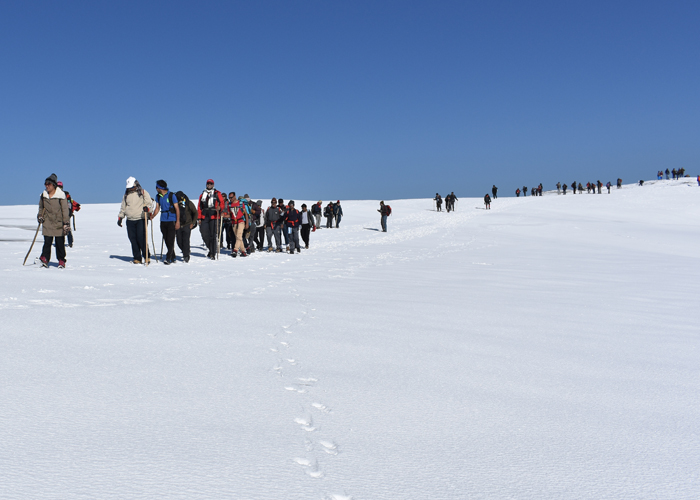
- Upcoming Trekking

National Himalayan Trekking cum Training Expedition Sar Pass 2024
After completing 50 years in Himalayan Trekking, Youth Hostels Association of India once again brings the National Himalayan Trekking cum Training Expedition– SAR Pass, 2024.
Importatnt Note – Participants are requested to bring the below documents at the time of reporting at base camp. 1) 2 Copies of ID proof 2) Trekking Medical certificate 3) 2 Passport size photographs About Program : After completing 50 years in Himalayan Trekking, Youth Hostels Association of India once again brings the National Himalayan Trekking cum Training Expedition– SAR Pass, 2024, in the beautiful Parvati valley of Kullu District in Himachal Pradesh. SAR Pass is one of the most popular trails of the Shivalik range of the mighty Himalayas. SAR Pass Trail offers an opportunity to enjoy the exquisite beauty of the Parvati valley with Kasol, Nagaru, Biskeri and Manikaran as its beauty spots. Kanwar Wid Life Sanctuary : The Kanwar Sanctuary was established in February, 1954, and is extended over an expanse of 60.7 square kilometres. Kanwar Sanctuary is home to the rare “Western Tragopan” and 200 species of birds and over 30 species of mammals. Amongst the bird population, Cheer Pheasant and White Cheeked Tit are the most prominent which can be seen here. Animals which can be found inside the boundary of the Kanwar Sanctuary are Barking Deer, Serow, Golden Jackal Goral, Leopard, Himalayan Palm Civet, Common Giant Flying Squirrel, Himalayan Weasel and Yellow Throated Marten. Kanwar sanctuary is an ideal place to witness the imposing beauty of the forests and their endless range of wildlife. Mandatory : Trekking Medical Certificate will be compulsory at the time of reporting only (with 30 days of validity ) duly signed by registered Medical Practitioner (MBBS / MD only) along with his registration no. and stamp. Trek Grading : Moderate to Tough These treks generally have around 06 hours of trekking per day and can involve a reasonable amount of ascent and descent touching the altitude around 12000-13000 feet. This grade is suitable for someone who is in good health and who is regular walker. Suitable for anyone who is used to walking on weekends or so, no previous trekking experience is required for this grade. Range : Parvati Valley, Kullu District of HP Flora and Fauna : Because of the complex geography and the great variations in altitude, Kullu is home to an enormous range of species, which span the subtropical to the alpine. The common trees in the Kullu hills belong to the conifer species (deodar, pine, spruce, fir). Several species of medicinal plants like Hath Panja (Dactylorhiza hatageria) and Brahma Kamal (Saussurea obvallata) grow luxuriously in the valley. the Himalayan brown bear and the Himalayan Tahr. The Western Tragopan (the state bird of Himachal Pradesh) and the Monal pheasant are the prominent birds species found in the region. Heighest Altitude Gain : 12,500 feet Reporting Dates : 26th April to 31st May, 2024 Before book the programme kindly read the programme details carefully Day Wise Schedule : Day 1 : Reporting at Base Camp Day 2 : Acclimatization, Orientation/Training and Kit Inspection Day 3 : Trek to Grahan Camp (Distance 9 km, 5hrs) Day 4 : Trek to Ming Thach Camp (11200 ft) Day 5 : Trek to Nagaru Camp (12500 ft) Day 6 : Trek to Beskari Camp (11000 ft) via Sar pass Day 7 : Trek to Barshani and return to base camp by bus and Certificate Distribution and Recreation Activity Day 8 : Check Out after Breakfast Note : The route and Schedule of the programme may change without prior notice based on the local condition. Who Can Participate : The minimum age for a member to join the program is 18 years to 60 Years, YHAI membership is mandatory to participate. This condition will be adhered to strictly. Under age and above age will not be considered. Members desirous of joining this programme may apply online duly supported by a “Trekking Medical Certificate”. How To Reach : Our base camp is at Kasol which is linked by road to Kullu via Bhuntar, it is 5 kms short of Manikaran, famous for hot water springs. Regular bus services and available from Kullu and Bhuntar to reach Kasol. Direct Buses are also available to Manikaran from Chandigarh and other parts of Punjab. Nearest railheads are Chandigarh and Ambala. Nearest airport is Bhuntar. Deluxe, semi deluxe and orginary night/day buses are available from Delhi, Chandigarh and other parts of Punjab till Manikaran. Please visit Himachal Pradesh Tourism Department and Himachal Pradesh Road Transportation website. How to Participate : Online Booking : Members desirous of joining this programme may apply online though website: www.yhaindia.org by paying requisite program fee Rs.9000/-. We accept Net Banking, Debit Card and Credit Card payment on www.yhaindia.org for online payments. After successful transaction Admit Card will be generated. Participant has to carry “Admit Card”, “Trekking Medical Certificate” & “Membership Card, two passport size photographs at the time of reporting to the Base Camp. Offline Booking : Members desirous of joining this programme may apply on the prescribed “Trekking Registration Form” duly supported by a “Trekking Medical Certificate”, along with a Demand Draft of requisite amount of Rs.9000/- .in favour of “Youth Hostels Association of India” payable at New Delhi. The Trekking registration Form, Trekking Medical Form and Demand Draft may be sent to following address: All Offline Booking confirmation is subject to availability of seats. National Office will send the Admit Card along with confirmation letter to the participant at the address mentioned in “Trekking Registration Form”. Members can also apply through our YHAI Units or State Branch in their respective area. Notice to Participant : 1. Smoking, use of alcohol and narcotics of any description is strictly prohibited during the course of the program. 2. Stay other than YHAI Camp is not allowed for the entire duration of the camp. 3. This is an environment friendly trek. Do no litter any wrappers or spoil the trial in any way. In case you find any wrapper, plastic bag or anything left by trekkers on the way, please carry the same with you and deposit at the base camp. 4. Burning of wood during camp fire is strictly prohibited. Import of any bio Non- degradable Material in Himachal Pradesh is an offence Accommodation Facilities : Tented accommodation (ON SHARING BASIS), pucca toilet cum bathroom facility, at the base camp. Food & Water Supplies : Simple, nutritious vegetarian meals. What Participants Should Bring : Rucksack (if You have one), Walking stick, Woolens, Cotton Shirts, Slacks, Cotton Pants, Sun Cap, Shoes, Socks, Enameled or Steel Mug / tumbler, Plate, Lunch box ,Spoon, Water purifying tablets, Pen knife, Needle, Thread, Spare buttons, Goggles, Cold cream / Vaseline, Soap, Toilet Paper, Towel, Rain sheet, Medicines (As per your personal requirement, which you regularly use at home and Crepe Bandage 4in*1, Micropore tape 1/2inch*1, Bandaids, Cough lozenges/ Kanthil or other, Vicks Vaporub, Coldarin, Clortrimazole cream and powder, Paracetamol*10 Mupirocin cream, Diclofenac gel, Lopamide*10, Azithromycin and Electral), Camera with extra batteries. Certificates : Participants, who successfully complete the trekking and abide by the discipline of the program, will be awarded certificates. Justice TPS Chawla Scholarship for underprivileged Girls : YHAI announced Justice T.P.S. Chawla Memorial Adventure Scholarship for underprivileged girls for participation in YHAI adventure activities. Girls whose family income is less than Rs.100000/- p.a. can avail this scholarship. Applicant has to submit the salary certificate of their parents. In case of Business, she has to submit their income on an affidavit. Deserving participants may apply to the National Office YHAI supported by relevant document / certificates. Off the beaten Siddharth Scholarship for underprivileged Young Men & Women : YHAI announced 50% Off the Beaten Track Siddharth Scholarship of the program fee to provide underprivileged Young Men and women less than 30 years of age with an opportunity to participate in outdoor adventure activities/ programs by YHAI in various parts of the country. Underprivileged Young Men & Women whose family income is less than Rs. 250000/- p.a can avail this scholarship by applying to the National Office YHAI supported by relevant document/ certificates through their respective State Branch. Safety & Security : Extensive and painstaking preparations have gone into the planning of trekking routed for your safety. Our field staff and experienced camp leaders have been visiting the area to check all details. While every care has been taken to ensure safety, the Youth Hostels Association of India cannot be held responsible for any accident, illness and such other unforeseen eventualities. Cancellation Rules : 1) Participants booked online will do online cancellation minimum 10 days prior to your reporting date. 2) Participants booked offline will inform their cancellation by email to [email protected], minimum 10 days prior to your reporting date. Only cancellation done as per above method will be eligible for credit shell. The below cancellation policy will however not be applicable if the request reaches short of 10 days prior to reporting date and shall not be eligible for credit shell. Cancellation Policy : 1) In case you are unable to join the programme due to any reason, you will get a 100% Credit Shell of the participation fees which will be valid till December 2024. No refund will be applicable for any cancellation of seat. 2) If the next programme opted by you is cheaper, you may use the balance amount in any of the Trek till Dec 2024. 3) If the next opted programme is costlier, the trekker has to pay the differential amount. 4) Program opted using the Credit Shell cannot be cancelled again in any condition. 5) You may transfer your seat to your family members and friends also. The seats thus transferred cannot be retransferred or cancelled.
Itineraries map
Weather forecast.
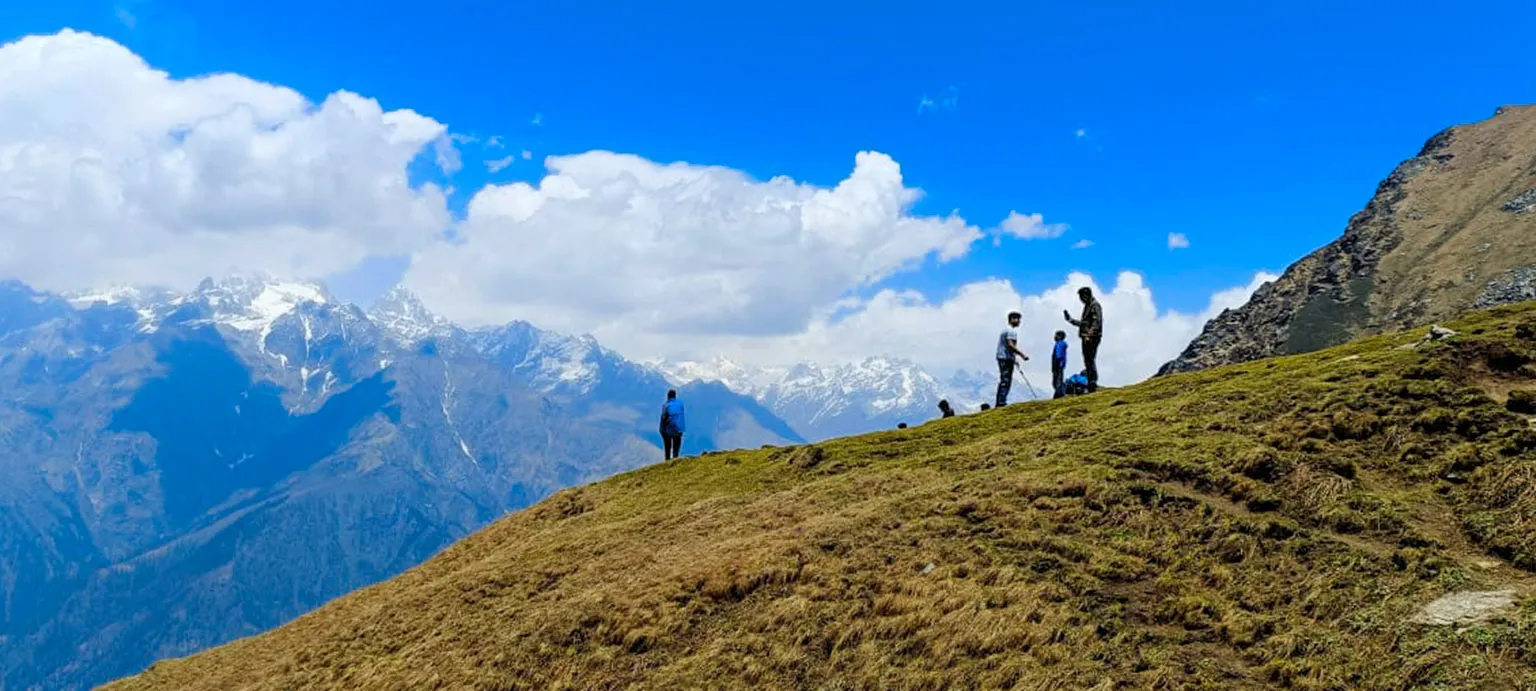
Sar Pass Trek
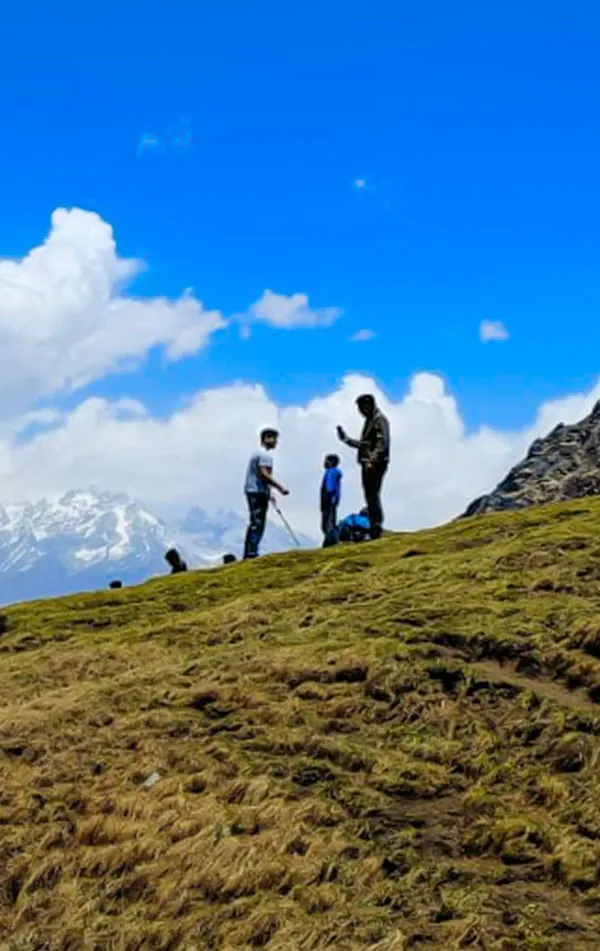
Himachal Pradesh |
Himachal Pradesh | India
Max Altitude
Trekking Km
Help & Support
11300 /person $ /person.
- +5% GST (goods and services tax)
- Services Grahan Village to Barshaini
Insurance 175
Insurance is Mandatory.
Non-Indian rates are slightly higher. Trek coordinator will provide balance payment link post-booking.
- Get insurance through us or elsewhere. If not through us, email for a refund after booking.
Cancellation 4 or more days before the start of the trip results in a 100% cash refund.
Cancellation less than 4 days from the start of the trip results in no refund.
Transport 1500
Transportation Kasol to Kasol & retun is optional
Choose add-ons during booking. If missed, log in and add them later
Book transportation at least 10 days before the trek.
Cancellation less than 4 days from the start of the trip results in a 50% cash refund.
Cancellation after the trip date does not qualify for a refund.
Offload 4800
Backpack offload is optional
Choose add-ons during booking. If missed, log in and add them later.
Book off-load at least 10 days before the trek.
For offline bookings at the base camp, a convenience fee of Rs. 5500 applies.
Cancellations made before the trip date will receive a full refund.
For more information. Please complete this form.
Help & Support
Trek Name: Sar Pass Trek
Adventure Type: Trekking
Base Camp: Kasol
Season: Summer | Autumn |
Month: April | May | June | September | October | November |
Country: India
Altitude: 13800 Ft.
Grade: Moderate
Rail Head: Pathankot is the nearest rail head to the base camp
Stay: Camping (Twin sharing) & Home Stay
Food: Meals while on trek & at Hotel/Guesthouse (Veg & Eggs)
Location: Himachal Pradesh
Distance: 50 Km.
Trail Type: Cross over trail | Start in one valley, traverse the pass, and ends in another valley.
AirPort: Bhuntar, which is 52 km away from Manali
Why Sar Pass A Must-Do Trek?
Sar Pass is a beautiful Himalayan Trek situated in the state of Himachal Pradesh and starts from the lovely village of Kasol. This trek allows you to witness part of the Himalayas, which is covered in lush green and pristine white. The trek begins with a beautiful start from Kasol, which is a picturesque village situated at an altitude of 5,184 ft in Parvati Valley.
The trek takes you through the lush green forests of Pine, Deodar, and Rhododendrons, you will also pass through Grahan, which is another beautiful village in the Parvati Valley, and from here you can gaze at a beautiful night sky full of a million stars. Camping under a sky full of stars is a life-altering experience.
An interesting thing about this trek is that it starts with lush green vegetation and later is completely whitewashed as you move toward the pass. You will cross different terrains like grasslands, woodlands, and snow patches in this short yet beautiful trek. The simple grade of the trek makes it suitable for beginners and anyone who wish to experience a Himalayan trek. All in all Sar Pass is a wonderful adventure that is a must-do for everyone.
About The Trek?
Sar Pass is situated at an altitude of 13,799 ft and the trek is an easy to moderate grade trek. This 50 km trek passes through Himachal Pradesh starting from Kasol and ending at Barshaini crossing through pine forests, meadows, snow-capped mountains, and various captivating landscapes.
The trek starts from the small settlement of Kasol in Parvati Valley where you will trek to Grahan Village. Both villages are the two most beautiful villages in Himachal Pradesh. From Grahan, we will move on to Min Thach a meadow patch followed by a trek to Nagaru, and then the next day you will trek to another grassland Biskeri Thach.
From Nagaru, we head to Sar Pass , where the landscape is completely whitewashed, and then to Biskeri Thach. On day 5, we will trek from Biskeri Thach to Barshaini and then drive back to Kasol.
What Can You Expect At The Trek?
Since Sar Pass is an easy-grade trek, it is suitable for all levels of trekkers and families as well. On average, you will walk about 7 km to 9 km daily with an average duration of 7 hrs. The temperature at Sar Pass Trek can be as high as 22°C and can fall to -5°C during the nighttime. The changes in temperature at a high altitude can affect your body, so dress in appropriate layers of clothing and follow your trek leader’s instructions to make the most of the journey.
The best time to do Sar Pass Trek is from May to October as the skies are usually clear and you will get to see the amazing panoramic views. During the trek, you can enjoy the hospitality and the friendliness of the people in the Himalayan villages and get a peek into their everyday lifestyle. You will also spot the rich biodiversity of the place. Because of the altitude variations of the place you can spot many diverse plant species. You can see different varieties of Pine, Deodar, Spruce, Fir, and medicinal plants like Brahma Kamal and Hatha Panja. You may also be able to spot wildlife species like Himalayan Tahr, Brown Bears, and bird species like Monal pheasant and Western Tragopan.
This trek is best for those who love adventure and want to see varied mountain landscapes and high snowy mountains. This trek is sure to give an adrenaline rush and thrilling experience!
- Who can Participate
- Important Links
- How to Reach
- Trek Essential
Who Can Participate
Age; 12 years +.
First timers can apply; previous trekking experience is more appreciated.
The climber must be fit and have sufficient stamina to cover 5 km of distance in 30 minutes without stress.
The climber should be able to carry a 10-15 kg backpack.
Pulse rate at rest must be in between (60 to 90 beats per minute)
Blood Pressure Reading must be in between (DIASTOLIC 70 – 90, SYSTOLIC 100 - 140 mm Hg)
Respiratory rate at rest must be in between (12 to 20 breaths per minute)
Should not have Liver and kidney issues
Should not have Diabetes Mellitus, Bronchial Asthma, Heart problems, Hypertension etc
No pacemaker implant
People with the Sinus issues, Epilepsy please contact to trek coordinator before booking the trek
If your BMI is not normal, Please contact our Trek coordinator before Trek booking.
Medical & Disclaimer Form (Mandatory Documents) Click here to download Medical & Disclaimer Form
- Government Employees can avail the benefit of Special Casual Leave (SCL) when you join us for a trekking expedition. As per the rules of the Pay Commission, Special Casual Leave can be availed for up to 30 days in a calendar year for trekking/mountaineering expeditions through a registered organization. Trek The Himalayas is a registered adventure tour operator by Indian Mountaineering Foundation (IMF) and Ministry Of Tourism (MOT)
- Trekkers have to apply for leave at least 20 days before trek departure date,
- This service is exclusive to Indian government employees and is applicable only for treks within India.
- Do mail at info@trekthehimalayas to apply and mention your booked trek date and trek name.
Junior trekkers (below 15 years) should have a company of parents/guardians.
Trekkers between 15 to 18 years can come solo with the disclaimer form signed by parent/guardian.
- Medical & Disclaimer Form (Mandatory Documents) Click here to download Medical & Disclaimer Form
Exercise For Moderate
Fitness Regime For:
Calculate Your Bmi
Your BMI value is
Congratulations, your body is in good conditions!
Kasol To Grahan Village
The trek starts from the beautiful mountain village Kasol in Himachal Pradesh, which is known for its lovely evergreen forests and creeks. It is a picturesque village set beside the gushing Parvati River and the trail takes you to Grahan village, which is another scenic village approximately 10 km from the village of Kasol. Our trek leader and the team will meet you at Kasol and after a round of brief introductions with teammates and some instructions the trek will start.
The trek gradient is very gradual, so it is effortless on your legs and knees and you can effortlessly make the trek today. You will start along the right bank of the Grahan Nallah and continue on the trail until it becomes a little rocky and you move far away from the right bank of the river, sometimes it may even feel like you are not on the right path but you are and keep continuing on the trail. The initial part of the trail passes through dense coniferous forests and the aroma of the pine trees will invade your senses as you walk through the forest.
After walking through the forested patch for some time, the forests will eventually give way to grasslands and you can see some local vendors with their tea stalls. These stalls also sell Rhododendron syrup, which is mixed with water to make a very refreshing drink. Grahan village is not very far. From here, it is about a steep climb of one hour before you enter the picturesque village setting.
Grahan is situated at the top of a hill and we will camp here for the night. Mobile coverage is sometimes available in Grahan but it is very erratic. The campsite is surrounded by Rhododendron trees making it look even more beautiful. After having a delicious lunch at the campsite, you can go about exploring the quaint village and its surroundings. The pleasantness of the scenery with the beautiful mountain views will captivate you. After a delectable dinner, you will retire to your tents ending the first day of trekking.
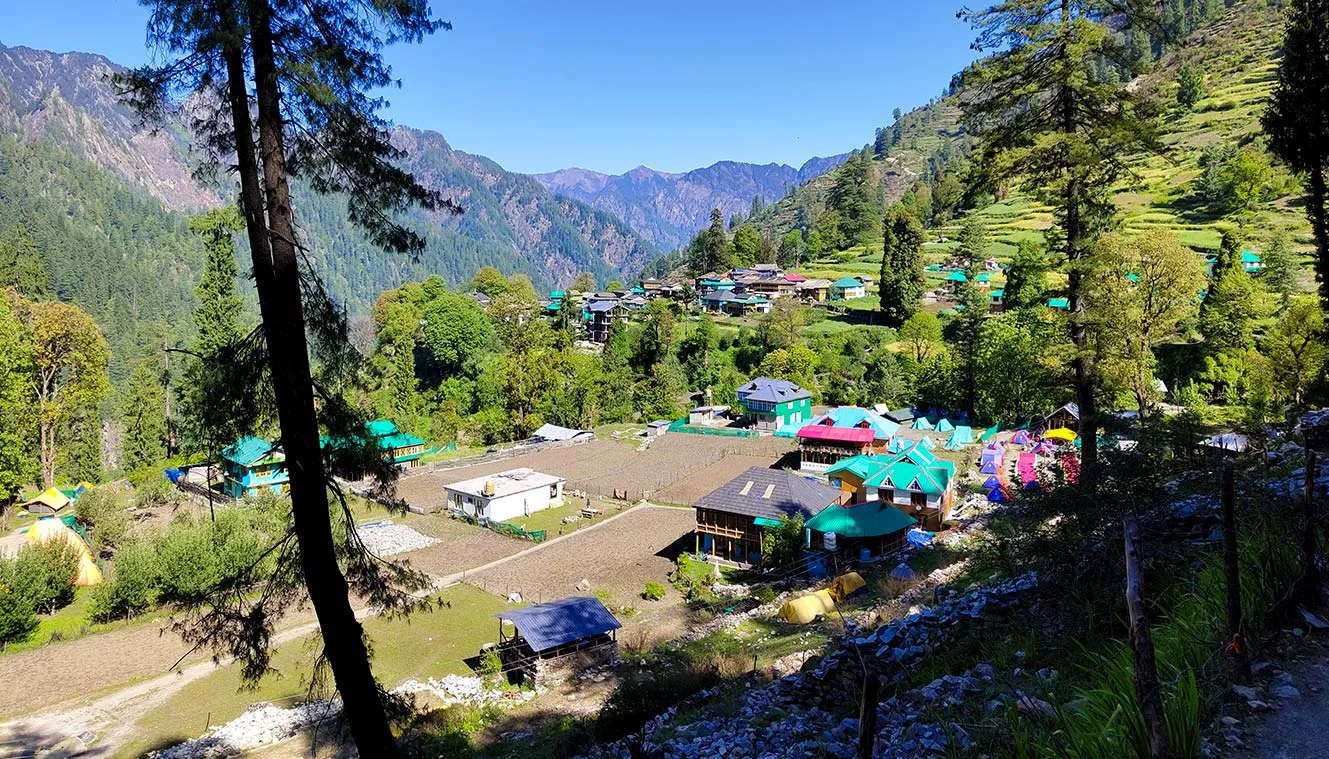
Grahan To Min Thach
Today we will trek to Min Thach, a beautiful meadow that falls en route to your trek. To reach Min Thach, we will follow the trail that goes north from our campsite at Grahan, this path will lead you to Min Thach. We will start our trek post a hearty breakfast at the Grahan campsite.
After walking for some time, wonderful mountain views begin to open up and the trail to Min Thach will be on your right. The climb to the meadow is a little steep and sometimes the trail becomes a little confusing, follow your trek leader’s instructions during these confusing patches. After walking for a few hours through the dense forests, it will open into a grassy ridge, this is Min Thach clearing and we will find a proper location here and pitch our tents for an overnight stay. Min Thach is usually used by locals to graze their cattle.
On the northwest side, you will get views of Chanderkhani and its adjoining mountain ranges stretching across the horizon. In the southeast, it is lined with dense evergreen forests. Sometimes there are also seasonal vendor stalls that sell tea, coffee, and the like. There’s also a water source in the form of a tap, and you will get potable water here. This is a good place to camp as the ridge protects the tents against strong winds. Also, having a day between Grahan and Nagaru campsite allows for the body to acclimatize well to the weather and the altitude. Sunset and sunrise views are especially beautiful here. Once you reach the campsite, relax and enjoy a beautiful sunset over the snow-clad mountains. After a hot dinner at the campsite, you will end the day and retire in your tents.
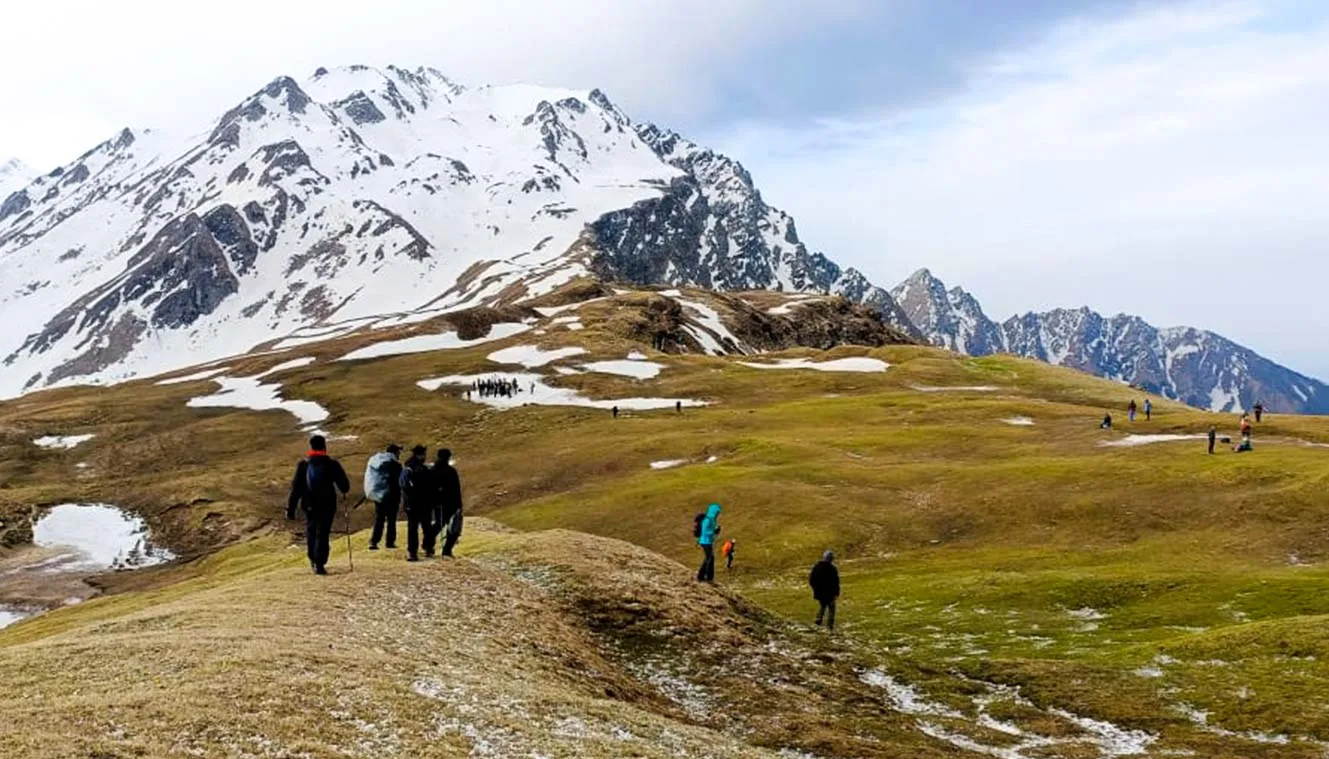
Min Thach To Nagaru
From Min Thach, you get glimpses of Nagaru and it doesn’t seem all that far but we are not going to take the straight ridge path to Nagaru, rather the trail entwines up towards the south and follows into the woods. Depending on the time you are visiting the trek, you may find patches of snow on the trail. It’s a good idea to start early as most of the time the weather remains favorable up until noon, post which it can be unpredictable. So, we will start out early today.
After walking some time through the forests, you will climb onto another ridge, this one is quite a bit rocky and overlooks the meadow down below. You have to take the left on the ridge, and it becomes pretty steep here. Nagaru sits atop a cliff that you have to ascend to reach the campsite. Follow the trail, it is pretty well marked here and after some time the tree line recedes and grassy patches begin to open up. If you are trekking in a season when there is snow on the trail then you have to be really careful as the snow can make the trek pretty tricky and slippery. Exercise extra caution and follow your guide’s instructions to avoid any mishap. Waterproof gloves and an ice axe can be helpful in these places.
After a couple of hours of trekking through varied terrains, you will arrive at a flatland on the top of a hill, this is Nagaru. As soon as you reach Nagaru, you will be totally amazed by the sight lying ahead of you. All of a sudden it seems like you have entered a different world from the one you have been trekking in so far! On the northern side, you can see the majestic mountains rising from the Parvati Valley down below. The Chanderkheni Ranges simply look magnificent and the Beas Valley with its greenery is amazing too. On your left, down below, you can see a bird’s eye view of Min Thach and Grahan village and to your south, you can see the vast expanse of snow up to the mountains. This is the direction you will trek in next to reach Sar Pass. The winds are very strong at Nagaru and the temperature drops pretty quickly so it is wise to set up the camps as soon as possible.
The nights here can be very chilly so have the appropriate layers on to protect yourself from the cold. After an early dinner, we will retire into the tents as the winds get stronger at night. Sleep well as tomorrow you will make your summit to Sar Pass.
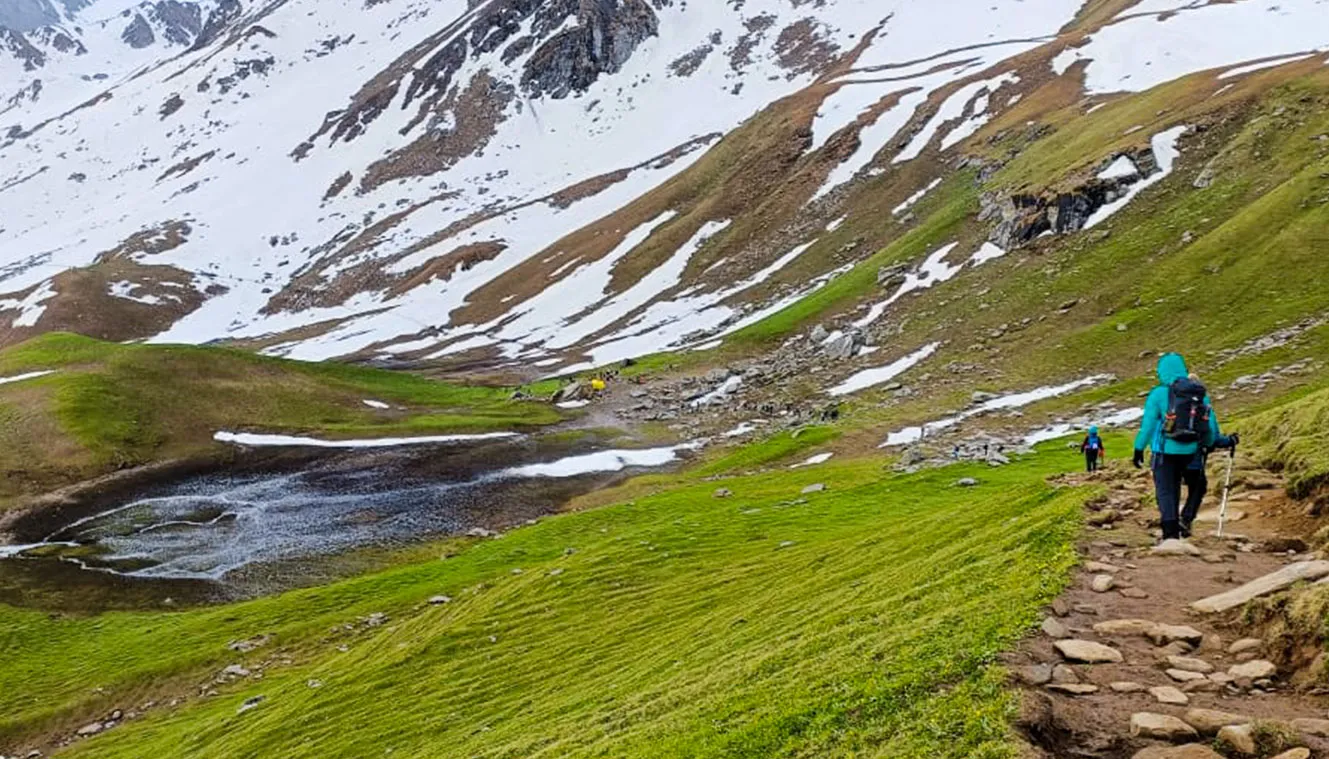
Nagaru To Biskeri Thach Via Sar Pass
Today is an exciting day of trekking and also the longest trekking day. Today will head to Sar Pass! We will start the day early and wake up before dawn as we have a distance of 14 km to cover. The climb to the Pass is much like yesterday and you will use the same techniques. We will climb along the ridge line in a southward direction, there will be a couple of steep stretches that would test your physical and mental endurance. Keep a steady pace as you climb these stretches and cross the snow patches.
It is a bit easier to walk on the snow and the strikingly beautiful surroundings will take your tiredness away, and we are always there to motivate you along the way. From Nagaru, you can see a hill, and once you climb the hill another hill comes into view that we need to climb. The ridge becomes sharper and steeper and on one side the ridge falls steeply to the ridge below. Be very careful and cautious here. Crampons and ice axe will make walking on the snow easier.
Once you make it to the top of the hill after an arduous climb, you will forget all the struggles that you have faced because of the view lying in front of you. You have reached the summit at Sar Pass. You will observe a flag tied to a Trishul at the summit indicating that you have arrived at the summit. The pass has derived its name from ‘Sar’ meaning a ‘pond’ which lies at the top. The pond remains frozen till late summer. The beautiful peaks of the Tosh Valley greet you on the one the east and to the south, you can see snow-ensconced mountain peaks. There’s a sharp drop to a beautiful valley ahead of you, which you have to slide down as there is no other way to climb down. Soak in the heavenly beauty of the place before we slide down to the valley below.
The slide is harmless and really fun but also follow the team’s instructions to slide down properly. Keep all your loose materials in a bag and keep your legs tight together and do not dig into the snow. Also, keep your elbows firmly by the side and push your trunk back into the snow. The slide will take about a kilometer into a gentler slope in the valley and after walking for some time you will come across another slope though not as steep depending on the snow accumulated, you can choose to slide down once again till you reach level ground. Another slope will come not long after this. You can again cover this slope by sliding down. You will now reach a narrow valley with a beautiful meadow on the left, this is Biskeri Thach. There are a couple of stream crossings before you reach the meadows. This campsite presents the sublime beauty of pine forests and snow-covered mountains as the backdrop. There are lots of water streams beside the campsite, so you can refill your water here. There’s a water tap as well. You may even find network coverage for some networks as well. Tonight we will stay at Biskeri Thach and return to Kasol the following day.
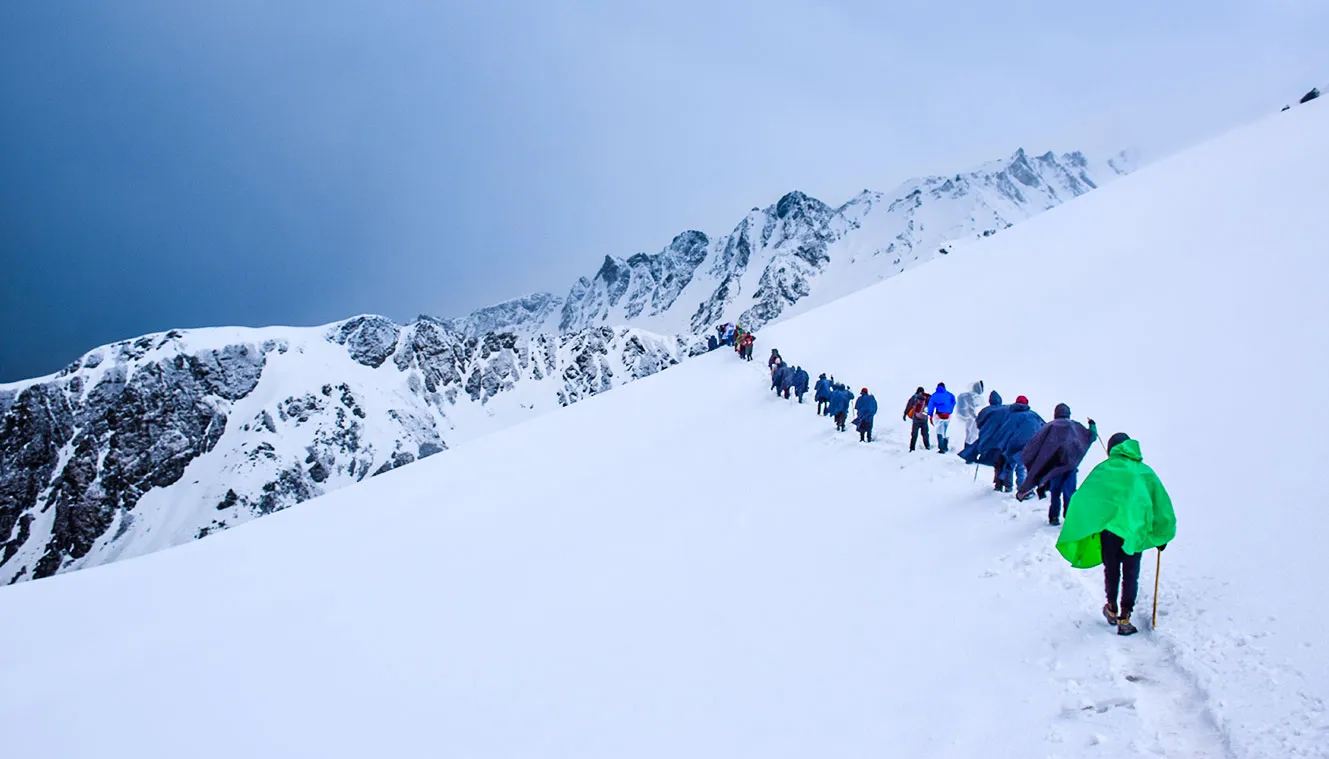
Biskeri Thach To Barshaini And Drive Back To Kasol
Today is the last day of trekking in the mountains and also the last day of your wonderful journey to Sar Pass. Today is also a long walk and we have to cover a distance of 10 km downhill. From Biskeri Thach a steep path goes down below by the side of a stream. The trail ends at a fenced plot of land so you have to go through the land before you hop on the trail again.
Follow the trail and you will enter a dense forest, there are many trails here, follow the one that leads in the north-eastern direction. After walking through the forest for some time you will come across a stream crossing. Getting to the stream is pretty tricky as you have to rappel down some twenty feet of rock with a rope. You will then cross the stream on wooden planks laid across it and then climb up the path that leads to some campsites. The trail follows a water pipeline that takes you to Pulga village. Pulga and Tulga are twin villages that are separated by a stream. From Tulga, you will have to cross another bridge over the Parvati River to reach the village of Barshaini. The river is dammed ahead for a hydroelectric power project.
Barshaini is the last village of Parvati Valley, which is connected by a road-head, albeit a bumpy one, and is often used as the road-head for treks like Kheerganga, Pin Parvati Pass, Matalai Lake, etc. From Barshaini you will drive back to Kasol. Kasol is about 15 km approximately from Barshaini and it takes about 45 minutes to 1 hr to reach Kasol depending on the road conditions. Thus ends this wonderful trek with so many beautiful memories for you to cherish forever.
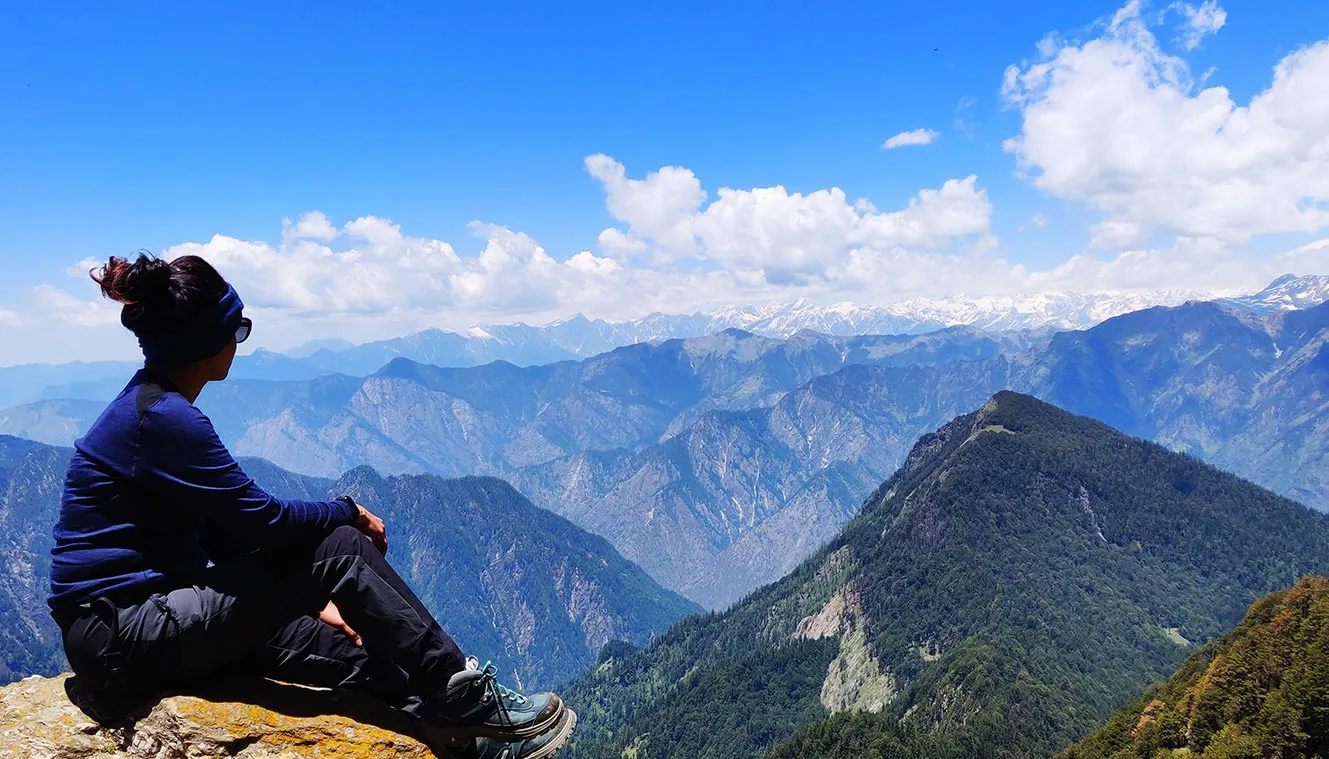
Day-1: Kasol To Grahan Village
- Altitude: Kasol - 1,700 m. Grahan - 2,350 m.
- Altitude Gain: 650 m.
- Distance: 10 km | Duration: 4 to 5 hrs.
- Transportation Amount is not included in the trek cost.
Day-2: Grahan To Min Thach
- Altitude: 3,400 m.
- Altitude Gain: 1,050 m.
- Trek Distance: 10 km | Duration: 5 to 6 hrs.
- First 9 km steep ascent and last 1 km steep descent.
- Water source at Min Thach Campsite (groundwater tap).
- Dense forest of Rhododendrons, Pine trees, Golden oak.
- Camping on meadows.
- Beautiful view of mountain peaks from the campsite.
- Stay in tents.
Day-3: Min Thach To Nagaru
- Altitude: 3,800 m.
- Altitude: 400 m.
- Trek Distance: 6 km | Duration: 4 to 6 hrs.
- All ascent.
- No water sources on the way.
- Nagaru camp site is above the tree line and too windy.
- Sometime networks are also available (Jio and Airtel are the best).
- View of snow mountains and meadows from the campsite.
Day-4: Nagaru To Biskeri Thach Via Sar Pass
- Altitude: Sar Pass - 4,200 m; Biskeri Thach - 3,350 m.
- Altitude Gain: 400 m.
- Trek Distance: 14 km | Duration: 6 to 8 hrs.
- 5 km steep and gradual ascent on snow till Sar Pass top.
- Can witness the amazing Sunrise.
- Views of Parvati Valley and local villages.
- Packed lunch will be provided for the day.
- Biskeri Thach camp is on a meadow and the last camp of the trek.
Day-5: Biskeri Thach To Barshaini And Drive Back To Kasol
- Altitude: 2,400 m.
- Altitude Loss: 950 m.
- Trek Distance: 10 km | Duration: 4 to 5 hrs.
- Drive Distance: 15 km | Duration: 40 minutes to 1 hr.
- Trek is a complete descent.
- Last 2 km trek is on off-road till the power project (Pick-up point).
- On the way to Kasol you can visit Gurudwara Sahib Manikaran and the hot spring, taxi waiting charges will be applicable.
- Drive to Kasol is next to the Parvati river.
- Reach Kasol by 4-5 pm.
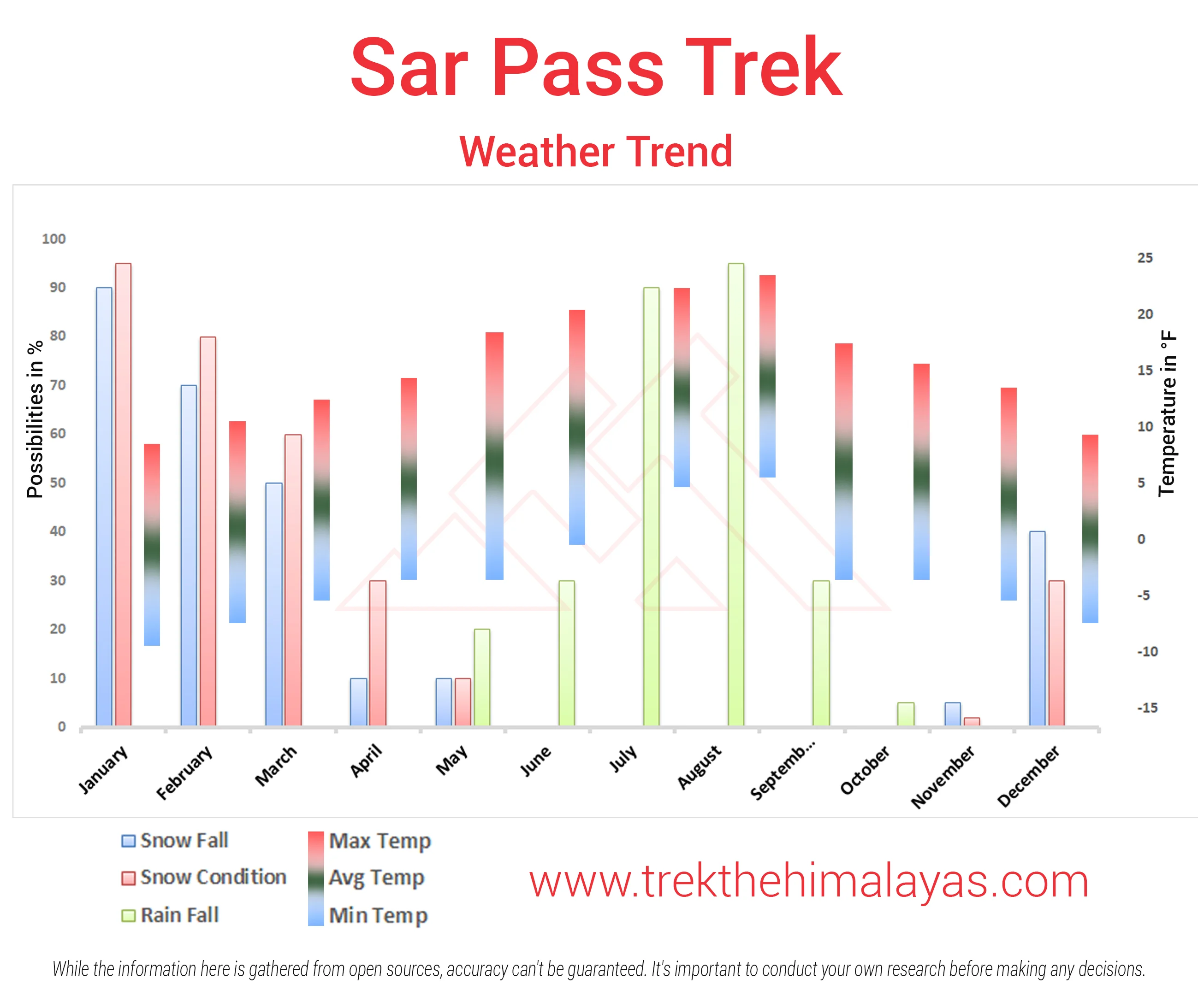
- Mandatory Documents to Bring on A Trek Click Here.
How To Reach
It is essential for everyone to arrive at Kasol (11:00 am)
Once you have reached the assembly point of the trek in Kasol, TTH will manage the rest of your travel arrangements, if you have opted for TTH's pick-up service, you can select this option during the booking process by adding it as an add-on.
Options to reach Kasol
1. Take overnight bus to Kasol from Delhi or Chandigarh.
-Chandigarh to Kasol Bus: 10 hours.
-Delhi to Kasol Bus: 14 hours.
2. Take overnight bus to Kullu and then private taxi / shuttle bus service to Kasol
We always recommend going for the govt. Buses over the private ones outside the bus station as based on the experience we have found that there are very high chances of delay involved with private buses. Also, govt. Buses are always more reliable. Whichever bus you choose, just make sure to reach Kasol at 9 am positively.
3. You can take a flight to Bhuntar Airport (but we would not recommend it because of the high prices of the flight and very high chances of cancellations), Kasol is just a couple of hours away and you can easily get a bus or a private taxi till there. If you do plan to come via Bhuntar, make sure to reach at least a day before the trek starts.
4. You can even come via train, Pathankot railway station is from where you can get direct buses to Kullu/Kasol that is 300 km from there and would take an overnight journey. Even in this case, reach a day before at Kasol.
Taking a flight to Chandigarh Airport and then travelling by bus to Kasol is the best option.
If you prefer to travel independently, you can either take a government bus or book a private cab. Your trek coordinator will provide guidance on how to arrange for the bus or cab booking.
Trekkers will be dropped at Kasol in between 4 to 6 pm. Taxi waiting charges will be applicable if want to visit Gurudwara Sahib Manikaran and hot spring. TTH offers comfortable transportation through Tempo Traveler, Bolero, or equivalent vehicles. If you wish to upgrade your mode of transportation, please contact your trek coordinator for further assistance.
.webp)
1. Accommodation (as per the itinerary):
- Camping on Day 1 to Day 4
2. Meals (Veg + Egg):
- From the Day 1st Linch to the Day 5th Lunch
3. Transportation (as per the itinerary):
- Transport from Kasol to Kasol.
4. Support:
- 1 Versatile base camp manager: handles communication and deploys extra manpower in emergencies.
- 1 Mountaineering & First aid qualified professional expedition Leader.
- 1 Experienced high altitude chef.
- Local experienced guides (Number of guides depending on the group size).
- Enough support staff.
5. Trek equipment:
- Sleeping bag, Sleeping liners (if required), Mattress, Utensils.
- 3 men all season trekker tent (twin sharing), Kitchen & Dining tent, Toilet tent.
- Camping stool, Walkie talkie.
- Ropes, Helmet, Ice axe, Harness(if required).
- Climbing Boots, Gaiters & Crampon /micro spike (if required).
6. First aid:
- Medical kit, Stretcher, Oxygen cylinder, Blood pressure monitor, Oximeter, Stethoscope.
7. Clock room service at base camp. 8. Mules/porters to carry the central luggage. 9. All necessary permits and entry fees, Upto the amount charged for Indian.
1. Insurance (Mandatory). 2. Food during the transit. 3. Any kind of personal expenses. 4. Mule or porter to carry personal luggage. 5. Emergency evacuation, hospitalization charge or etc. 6. Anything not specifically mentioned under the head Inclusion.
Things can be provided on demand and availability (participant has to pay extra for these things).
1- Satellite phone/set phone - is a type of mobile phone that connects via radio links via satellites orbiting the Earth instead of terrestrial cell sites like cellphones. Therefore, they can operate in most geographic locations on the Earth's surface.
2- Gamow/PAC HAPO Bag (Portable Hyperbaric Bag) - is a unique, portable hyperbaric chamber for the treatment of acute mountain sickness (AMS), also known as altitude sickness.
3- AEDs (Automated External Defibrillators) - are portable life-saving devices designed to treat people experiencing sudden cardiac arrest, a medical condition in which the heart stops beating suddenly and unexpectedly.
Special Offer
Make a single payment and trek the number of times you want.
If you book a trek with Trek The Himalayas and cannot complete it, or if you've successfully completed the trek and wish to do it again, you can repeat it multiple times at no additional cost.
Terms and conditions
- This offer is non-transferable.
- This offer is valid for Trek The Himalayas limited fixed departures.
- This offer is valid for 5 years from the date of booking.
- This offer is not valid if the participant has received a cash refund or voucher at the time of cancellation.
- Participants don’t have to pay for the trek cost but have to pay for transportation and trek permit costs.
To reserve a spot for a trek or adventure program, you can either utilize our online booking form or call us at the provided number. For your confirmation, a deposit must be wired, including the initial payment.
Cancellation terms:
Cancellations prior to 25 days from the start of the Trip
Refund options
- 5% deduction of trek fee
- 100% cash voucher for any trip till one year
- Transfer your trek (any trek, any date) to your friend
Cancellation between 24 days and 15 days to the start of the Trip
- 30% deduction of trek fee
- 100% cash voucher for same trip till one year
- 85% cash voucher for any trip till one year
- Transfer your trek (same trek, any date) to your friend
Cancellation between 14 days and 10 days to the start of the Trip
- 50% deduction of trek fee
- 80% cash voucher for same trip till one year
- 70% cash voucher for any trip till one year
- Book the same trek, in the same season, with any other batch
Cancellation less than 9 days to the start of the trek
- No cash refund
- 20% cash voucher for the same trip till one year
- 10% cash voucher for any trip till one year
- Transfer your trek (same trek, same date) to your friend
Note- If a booking is made using a voucher or discount code, the policies related to vouchers and discounts cannot be modified.
In the unlikely event that TTH cancels a trek prior to the scheduled departure date:
While it is extremely rare for TTH to cancel a trek, we understand that unforeseen circumstances or natural disasters may occasionally require us to do so before the scheduled departure. These circumstances could include continuous rain or snow, thunderstorms, snowstorms, landslides, floods, earthquakes, or any other natural calamity that poses a risk to the safety of our trekkers. Additionally, unforeseeable events such as local riots, curfews, pandemics, lockdowns, government orders, or any similar situations that compromise the safety of the trekking experience may also necessitate a cancellation.
In the event of such a cancellation, TTH will provide you with a voucher equivalent to the amount you paid for the trek. This voucher can be redeemed for any of our treks within the next year, allowing you to still enjoy an adventure with us at a later date.
The issuance of a voucher is not applicable in situations where you are required to descend from the trek for any reason. The trek leader may make the decision to send you down from the trek due to factors such as insufficient fitness level, symptoms of Acute Mountain Sickness (AMS), high blood pressure, exceeding the designated turn-around-time, health concerns, or if you are found smoking, drinking, or violating the rules set for the trek. In such cases, the provision of a voucher does not apply.
In the rare event that TTH shifts a trek:
We would like to emphasize that weather conditions in high-altitude areas are highly unpredictable and can undergo sudden changes at any time, irrespective of the day. Additionally, circumstances beyond our control, such as natural disasters, political unrest, pandemics, and lockdowns, may impact the feasibility of conducting a trek. In cases where we are unable to proceed with an event due to such circumstances that are beyond our direct control, we will make every effort to provide you with an alternative trek that is safer and more suitable.
In such situations, we will issue a voucher to offset the cost difference between the originally scheduled trek and the alternative trek. This voucher can be redeemed at any time within one year from the date of issue. Please note that a refund fee or reimbursement of the cost difference is not applicable in these cases.
- Change of trek batch is dependent on the availability of seats in the batch
- In case of transferring a trek to a friend, he/she should satisfy all the mandatory requirements put forward by TTH
- TTH holds the right to change/cancel the policies, without prior notice
- Cash refund is applicable only in case of bookings made without using any promotional offer code or vouchers
Cash Voucher Terms:
- This is a non-transferable voucher
- The voucher cannot be merged with any other offer of Trek The Himalayas
- The voucher is valid for Trek booked directly with Trek The Himalayas in India
- To avail the voucher please use your register phone number or e-mail id
- All the other Terms of booking a trek with Trek The Himalayas are applicable to the voucher
- Trek The Himalayas holds rights to add/remove any of the Terms and Conditions without prior notice
Itineraries are based on information available at the time of planning and are subject to change. "Trek The Himalayas" reserves the right to change expedition dates, people or itineraries as conditions warrant. If a trip must be delayed or the itinerary changed due to bad weather, road conditions, transportation delays, government intervention, airline schedules, sickness, or other contingency for which TTH or its agents cannot make provision, the cost of delays and/or other changes are the responsibility of the participant. TTH reserves the right to decline, or accept, any individual as a trip member for any reason whatsoever.
Trek Essentials
PDF Of Trek Essential Download
Frequently Asked Questions(FAQ)
How to register/create an account with tth.
To register with TTH, visit our website - www.trekthehimalayas.com and create your account. To create your account you will need to use your email address and fill in all the details, set your unique password and your account is ready to use.
How to book a trek?
- To book a trek with TTH, you first need to register with us and create an account.
- Choose the trek that you want to do and click on available dates.
- You will land at the login page, fill in the required details.
- Add Participants, choose add-on services click on the Pay now button, choose your preferred payment method, and make the payment. TTH accepts multiple payment options, including credit/debit cards, net banking, and UPI.
- You will receive a confirmation email from TTH with all the necessary details about the trek, including the meeting point, transportation, accommodation, and other important instructions.
Made a payment but did not receive any confirmation.
please send an email to us at [email protected] or reach out to the numbers provided in the Help and Support section of your Trek Page. We will ensure that your issue is promptly resolved.
How to book off-load luggage and transportation?
To book services such as off-load luggage and transportation, you can find them listed as add-ons. These additional services can be booked at the time of your initial booking. If you miss booking add-ons during the initial reservation, you can log in anytime and easily book 4 days before the departure date add-ons through the platform.
If I have booked the wrong trek or date, how can I make changes?
In such a situation, please log in to your account and transfer your trek or date to the desired one within 12 hours or drop us an email at [email protected] 10 days before the departure date of the trek. After the initial 12-hour period, any changes will be processed according to the cancellation policy.
I am a beginner and confused which trek to book.
We recommend visiting our "Suggest Me a Trek" page. By filling out the form, our experts will contact you with the best possible trek options based on your preferences and experience level. Alternatively, you can reach out to us via email at [email protected] or give us a call using the numbers provided on our website for personalized assistance and recommendations.
How is family trek different from regular trek?
Family treks differ from regular treks by focusing on ease of difficulty, offering shorter durations for younger participants, Kid-friendly and easily digestible foods, child-friendly activities, maintaining a higher guide ratio for diverse age groups, and implementing additional safety measures for families.
Ideal treks for children.
Family Trek with Kids recommendation Only Dayara Bugyal and Chopta Chandrashila Trek.
Minimum age for children to trek with TTH.
Minimum age for TTH treks is typically 7 years, though this may vary depending on the specific trek.
Can we take children to high altitudes with their guardian?
Yes, you can take a kids to a high-altitude trek with a parent. Discuss with a trek expert before booking a trek.
Can we send kids without Parents/guardian?
Medical & Disclaimer Form (Mandatory Documents) Click here to download medical and disclaimer form
How to prepare a child for a high altitude trek?
Physical Fitness: Ensure your child is physically fit. Engage them in regular exercise, outdoor activities, and hikes to build stamina and endurance. Hydration: Emphasize the importance of staying hydrated at high altitudes. Encourage your child to drink water regularly, even if they don't feel thirsty. Proper Nutrition: Provide a well-balanced diet with sufficient carbohydrates for energy and foods rich in iron to prevent altitude sickness. Adequate Sleep: Ensure your child gets enough sleep in the days leading up to the trek. Quality rest is crucial for altitude adaptation. Educate on Altitude Sickness: Teach your child about the symptoms of altitude sickness, such as headache, nausea, and dizziness. Encourage them to communicate any discomfort immediately. Appropriate Clothing and Gear: Dress your child in layers to adjust to changing temperatures. Ensure they have appropriate trekking gear, including sturdy footwear. Positive Mindset: Foster a positive mindset. Encourage your child, and let them know it's okay to take breaks when needed. Medical Check-Up: Schedule a medical check-up before the trek to ensure your child is fit for high-altitude activities. Consult with a healthcare professional about any potential health concerns.
Kind of food will be served during the trek for children.
TTH takes special care to provide wholesome and nutritious food for children on treks. Here are some of the foods that are typically served for children: Breakfast: For breakfast, TTH serves a variety of options like porridge, cornflakes, bread, butter, jam, honey, boiled eggs, omelettes, and pancakes. Children can choose from these options to fuel themselves for the day's trek. Lunch: For lunch, TTH serves lunch which includes rotis, vegetables, rice, dal, and salad. The rotis are usually made fresh on the trek and are a good source of carbohydrates. The dal and vegetables provide protein and other essential nutrients. Snacks: TTH provides healthy snacks like fresh fruits, dry fruits, energy bars, cookies, and biscuits to keep the children energized throughout the day. Dinner: For dinner, TTH serves a hot and wholesome meal which includes soup, rice, dal, vegetables, and a non-vegetarian dish (if requested in advance). Children can also choose from a variety of desserts like custard, jelly, and fruit salad. Dietary requirements: If a child has any special dietary requirements, TTH can cater to those needs as well. For example, if a child is lactose intolerant or allergic to nuts, the kitchen staff can make arrangements to accommodate those requirements.
How to choose the right trek?
Choosing the right trek for a beginner can be a bit overwhelming as there are many factors to consider such as distance, elevation gain, terrain difficulty, weather, and time of year. Here are some tips that can help you choose the right trek for a beginner:
1. Determine fitness level: Assess the fitness level of the beginner to understand their physical capabilities. This will help you select a trek that is challenging but not too difficult.
2. Choose a well-traveled trail: A well-traveled trail will have more amenities such as signposts, water stations, and shelter. It is also safer as there will be other hikers on the trail.
3. Consider the length of the trek: For beginners, it is recommended to start with a shorter trek that can be completed in a day or two. This will help them get acclimatized to trekking and build their confidence.
4. Look for gradual elevation gain: Choose a trek with a gradual elevation gain rather than steep ascents. This will make the trek easier and more enjoyable.
5. Check the weather: Check the weather forecast before selecting a trek. Avoid treks during the monsoon season or winter when the trails can be slippery or dangerous.
6. Research the trail: Read about the trail to get an idea of the terrain, altitude, and difficulty level. This will help you select a trek that is suitable for the beginner.
7. Consult with an expert: If you are unsure about which trek to choose, consult our trek expert Mr. Nitin (+91 70600 59773) between 10 AM to 6 PM (Tuesday - Friday). Mr. Nitin will provide you valuable advice and guidance.
Overall, it is important to choose a trek that is enjoyable, challenging but not too difficult, and suitable for the beginner's fitness level and experience.
Can a beginner choose a tough trek?
It is not recommended for a beginner to choose a difficult Himalayan trek. Trekking in the Himalayas can be physically and mentally challenging, especially if you are not used to the high altitude, steep slopes, and rugged terrain. Choosing a difficult trek without the proper experience, fitness level, and preparation can be dangerous and put you at risk of altitude sickness, injury, and other hazards.
If you are a beginner, it is recommended to start with an easier trek and gradually build up your skills and experience. This will help you understand the challenges of trekking in the Himalayas, and also prepare you physically and mentally for a more difficult trek in the future. It is also important to choose a trek that matches your fitness level, experience, and interest.
What is the age limit for a beginner trekker?
There is no specific age limit for a beginner trekker. However, it is important to consider your physical fitness, health condition, and personal interests before embarking on a trek. Trekking in the Himalayas can be physically and mentally demanding, and requires a certain level of physical fitness and endurance.
If you have any pre-existing medical conditions or are above a certain age, it is recommended to consult with a doctor before embarking on a trek. It is also important to listen to your body and take breaks as needed during the trek to prevent exhaustion or injury.
If I am solo, can I join the trek in a group?
Yes, you can join the trek. We have fixed departure groups where you can simply book your trek and we will take care of curating a group.
How does my family get updated about my Trek?
Before you start the trek, it is recommended that you make all the necessary phone calls as during the trek you may or may not receive network coverage, once you come back to the Base Camp, you can reconnect with your family via phone once again. You can share your trek coordinator contact detail with your family members to get the latest updates about your trek batch.
What food can I expect?
At TTH, we provide wholesome and nutritious meals during the trek. The food is vegetarian and includes a variety of dishes such as rice, dal, vegetables, chapati, paratha, pasta, noodles, and soup. We also offer snacks such as biscuits, and salty, and dry fruits during the trek. Special dietary requirements such as vegan, gluten-free, or Jain food can also be arranged if informed in advance.
I am allergic to some foods.
If you are allergic to some foods, you need to let us know in advance so that we can make arrangements accordingly.
How safe is trekking with TTH?
TTH is a trekking company that prioritizes the safety of all its participants, including women trekkers. They have a comprehensive safety system in place, which includes a dedicated team of experienced and trained trek leaders and support staff who are equipped to handle emergency situations and provide first aid.
TTH also takes specific measures to ensure the safety and comfort of women trekkers. They have a separate tent accommodation for women trekkers, female trek leaders, and support staff. They also provide separate toilet facilities for women and encourage a safe and respectful environment for all trekkers.
Moreover, TTH has a strict policy against any kind of harassment and has a zero-tolerance policy towards such incidents. They have a designated Internal Complaints Committee (ICC) to investigate and address any complaints related to harassment or misconduct. Overall, TTH has a good reputation for safety and responsible trekking practices, and women can feel comfortable and safe while trekking with them.
How TTH will manage if I am the only woman in the group?
In case you are the only women in the group, we provide a single sleeping arrangement. Also, during the trek, the trek leader will always remain by your side to provide optimum safety and reassurance.
How can I know that other women are in the batch?
You can reach out to the trek coordinator to inquire about the number of female trekkers and their respective states who have booked the trek. Please note that the trek coordinator cannot disclose personal details of any trekker. Once you've confirmed your booking, a WhatsApp Group will be created for all the trekkers in your batch. This allows you to connect with fellow trekkers before the trek begins.
Can I know in advance, which trek is led by a women Trek Leader?
While many of our treks are led by female trek leaders, however, it is not possible to know which trek leader is assigned to which group. But nonetheless, whether the trek leader is male or female you can be completely assured of your safety and security with us.
Can I trek with periods? If yes, then where can I dispose of the sanitary pad?
Yes, it is possible to trek with periods. However, it is important to take some extra precautions and preparations to ensure a comfortable and safe trekking experience.
Here are some tips that can help you trek during your period:
1. Use menstrual hygiene products that you are comfortable with, such as tampons, pads, or menstrual cups. It is recommended to carry enough supplies for the entire duration of the trek.
2. Pack wet wipes, hand sanitizer, and plastic bags to dispose of used hygiene products.
3. Wear comfortable and breathable clothing that allows for easy movement and reduces friction. Avoid wearing tight or restrictive clothing that can cause discomfort.
4. Carry pain relief medication, such as ibuprofen or acetaminophen, in case of menstrual cramps.
5. Stay hydrated and maintain a balanced diet to support your energy levels and overall health.
6. Take breaks as needed and listen to your body. If you feel uncomfortable or experience any unusual symptoms, seek medical attention immediately.
It is also recommended to consult with a doctor before going on a trek during your period, especially if you have a pre-existing medical condition or are taking medication. By taking necessary precautions and being prepared, you can have a safe and comfortable trekking experience even during your period.
We provide proper disposal facilities for sanitary pad disposal during the trek.
How will the accommodation be during the trek?
We offer three person tents with twin-sharing for optimum comfort. A woman trekker will share a tent with another woman trekker and if you are the only woman in the group, you will be given a single accommodation for your comfort and privacy.
Are trek poles, Jackets and other equipment available for rent from Trek The Himalayas?
Yes, we do provide gears on rent. You can book it using you TTH account directly.
Who will be with us on the trek from Trek The Himalayas?
Mountaineering qualified Experienced and first aid certified Trek Leader, First Aid Certify local guide, Cook, helpers and supporting staff.
Who can not join the trek?
People suffering from Bronchitis, Asthma, High blood pressure, Epilepsy (got faints), TB , Heart problem or on higher BMI side are strictly not allowed to go on any Himalayan trek. Apart from this if you had any medical history, please let us know.
When it gets really cold can I consume alcohol?
No. Alcohol and smocking isn’t allowed while on trek. It is totally misconception that it will keep you warm. Your body need to acclimatize properly and for that eat properly and drink enough water; these things will keep you warm.
What type of toilet facility is TTH providing at the trek?
Toilet tents provide a convenient solution for answering nature's call in the great outdoors. Dry toilets, in particular, offer a highly sanitary approach. By digging a pit and utilizing mud and a shovel, you can easily cover up your waste. This method ensures cleanliness and hygiene while camping or exploring in the forest.
Remember to pack essential toiletries to complete your outdoor bathroom kit and maintain proper personal hygiene during your adventures. With these practices in place, you can enjoy nature while also respecting it.
How do I manage the negative temperatures on the trek at higher camps? Do I need special jackets?
Layer Up From Head To Toe Eat Full Meals, never sleep empty stomach You can keep warmee (if you’re more susceptible to cold). Use sleeping bag in right way and don’t leave free space in sleeping bag.
For upper body – Thermal layer – T-shirt (full-sleeves) – Fleece T-shirt (for extreme colds) – Fleece layer – Thick Jacket/Down Jacket – Waterproof or Windproof layer (outermost layer, when it is snowing or raining) - For Lower Body – Thermal layer – Hiking pants (normal) or Winter hiking pants
Based on how warm you feel you can skip any of the above layers. Your outer later should be windproof since it is windy at high altitude. The idea behind layering is that the more insulation you have the less cold you feel, and instead of wearing a very thick jacket if you wear multiple layers, your body will be better insulated against the cold.
Do you provide crampon/micro spikes and gaiters?
Yes, we provide micro spikes and gaiters, if required.
What documents need to carry on trek?
Mandatory documents: 2 xerox of ID having address (addhar card/driving license), 2 Passport size photographs, hard copy Medical form signed & sealed by doctor, disclaimer form sign by trekker and high altitude insurance.
If we come prior the trek date, Do you provide accommodation?
No. We don’t but we can suggest you good hotel/Stay nearby pick up location.
Do we get enough water for drinking?
Yes, trekker must carry 2 water bottles 1 litre each so they can refill it at campsite for drinking and keep themselves hydrate.
What kind of shoes we should buy for the trek?
You should buy shoes which has these three features –Good grip, Ankle Support and additional water resistant layers. Generally, we advise Quechua Trek 100, MH 500 and MH 100.
How do we get back after the trek?
Your return transport is also included in trek fee if you're opting for service Dehradun to Dehradun ; we use Tempo Traveller/ Tata Sumo/Max/Boloero kind of vehicle.
What happens if some members of the team need to turn back before the summit?
No one is forced to go on. There is always enough staff to split the party according to need and regroup later at the camp. Most people have no trouble reaching the highest campsite. If some members decide not to climb the final distance they can wait for the climbers to come back down the same way or take a lateral path to the descent route.
What kind of help is available in case of emergency?
We always have a first aid kit close at hand. Serious injuries are rare. Porters will assist injured climbers to the base of the mountain and onward to a clinic or hospital. Kilimanjaro International Airport is very near Marangu Gate if evacuation to the US or Europe is advisable.
What is Sar Pass Trek?
The Sar Pass Trek is a journey through the majestic Himalayas that offers trekkers an opportunity to experience the raw and rugged beauty of nature. The trek takes you through remote mountain villages, dense forests, and snow-capped peaks, giving you a glimpse into the local culture and lifestyle. The trail is a challenging one, with steep inclines, rocky paths, and unpredictable weather conditions. But the reward is worth the effort - stunning views of the Himalayas, including the peaks of Toshainagiri and Chanderkhani. The highlight of the trek is the Sar Pass , a high-altitude mountain pass that requires you to traverse steep slopes and negotiate snow-covered terrain. But the sense of accomplishment upon reaching the summit and taking in the breathtaking views is truly unmatched. The Sar Pass Trek is a journey of self-discovery, pushing you beyond your limits, and immersing you in the grandeur of nature.
How difficult is Sar Pass Trek?
Sar Pass Trek is a moderate-grade trek
When is the best time to do Sar Pass Trek?
The best time to do the Sar Pass Trek is during summer (Mid Apr-Jun) and autumn (Sep - Mid Nov) .
What is the duration of the Sar Pass Trek?
Sar Pass Trek takes 5 days to complete the trek.
What is the maximum altitude of Sar Pass Trek?
The maximum altitude of Sar Pass is 13,800 ft .
What is the total distance covered in Sar Pass Trek?
Throughout the Sar Pass Trek, you will cover a total distance of 50 km .
Is it safe to do Sar Pass Trek?
Yes, it is safe to do Sar Pass Trek with an expert organization. However, it is always advisable to take necessary precautions and follow safety guidelines issued by the Trek Leaders and guide while trekking in the mountains.
What are the essential things to carry on Sar Pass Trek?
Here are some of the essentials you should carry for the trek:
1. Trekking shoes: A good pair of trekking shoes is essential for a comfortable trek. Make sure your shoes are well-fitted, sturdy, and provide good grip on the trail.
2. Warm Clothing: The weather can be unpredictable in the mountains, so it's important to carry warm clothing, including thermal innerwear, fleece jackets, down jacket, and waterproof jackets.
3. Trekking pants: Carry comfortable and quick-drying trekking pants that are suitable for weather conditions.
4. Backpack: A good quality backpack with a capacity of 40-50 liters is ideal for carrying your essentials during the trek.
5. Sleeping bag: A good quality sleeping bag is essential for a comfortable stay during camping nights.
6. Headlamp/Flashlight: Carry a good quality headlamp or flashlight with extra batteries for trekking during early morning or late evening hours.
7. Water bottle: Carry a reusable water bottle and stay hydrated throughout the trek.
8. Snacks: Carry energy bars, dry fruits, and snacks for instant energy during the trek.
9. First aid kit: Carry a basic first aid kit, including band-aids, antiseptic cream, pain relief spray, and medicines for altitude sickness.
10. Sun protection: Carry sunscreen lotion, sunglasses, and a hat to protect yourself from the harsh sun rays.
11. Trekking poles: Trekking poles can help in maintaining balance and reduce the strain on your knees while trekking.
Is it necessary to hire a guide for Sar Pass Trek?
Yes, it is recommended to hire a professional trekking expert for the Sar Pass Trek , especially if you are a beginner or unfamiliar with the region.
Do I need any prior trekking experience to do Sar Pass Trek?
The Sar Pass Trek is a moderate to difficult level trek, and it is recommended that you have prior trekking experience before attempting it. The trail involves steep inclines, rocky paths, and unpredictable weather conditions, which can be challenging for beginners. It is important to be physically fit and mentally prepared for the trek to ensure a safe and enjoyable experience. However, with proper preparation, guidance from experienced trek leaders, and a positive mindset, even first-time trekkers can successfully complete the Sar Pass Trek.
What is the accommodation like during Sar Pass Trek?
During the Sar Pass Trek , you will stay in a guest house in the base camp and on the slopes you will be staying in tents (twin-sharing).
How do I reach the starting point of Sar Pass Trek?
The Sar Pass Trek starts from Kasol village in Parvati Valley.
- Date and Price
Rent A Gear
Trek Articles
Quick Links
Trekking & Hiking
Mountaineering
Multi Sports
Himalayan Pilgrimage
Website Privacy
Terms & Condition
Contact Info
Get in touch with us. E-mail us Monday-Saturday (10 AM to 6 PM)
Address: Trek The Himalayas, Kaintura Plaza, Badrinath Road Tapovan, Rishikesh - 249201 Uttarakhand
Phone: 8191004846
Email: [email protected]
2010 Trek The Himalayas. All rights reserved

Sar Pass Trek
Sar pass trek in himachal pradesh.
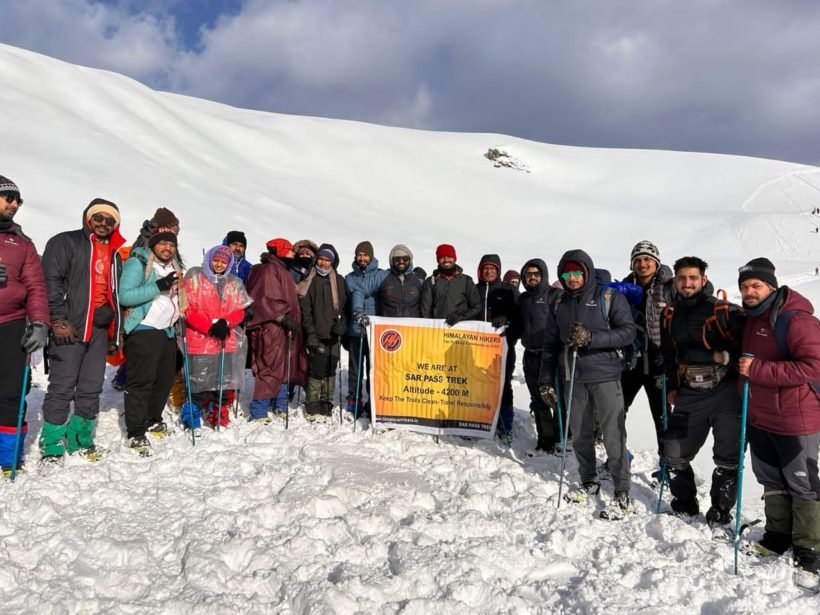
Description
Reviews (6), things to take, available dates, include / exclude, the sar pass trek is a popular trekking route in the parvati valley of himachal kasol – india. -2024- complete information, itinerary, route, map, best season.
Sar Pass Trek is a stunning trek from Grahan village ending in Barhseini in Kullu Valley . The trek is recommended for all those who love adventure, snowy landscapes, and high mountains.
The trek starts from Kasol where you will PASS through pine forests, magnificent meadows, snow-capped mountains, and some of the most jaw-dropping landscapes which make Sar Pass one of the best treks for beginners. You will also PASS by a frozen lake (Called Sar in the local dialect) from where it got its name.
The total trek distance is 37 km. Once you reach the PASS almost close to 14,000ft, the view from the PASS is absolutely breathtaking because of the majestic mountains of Parvati Valley.
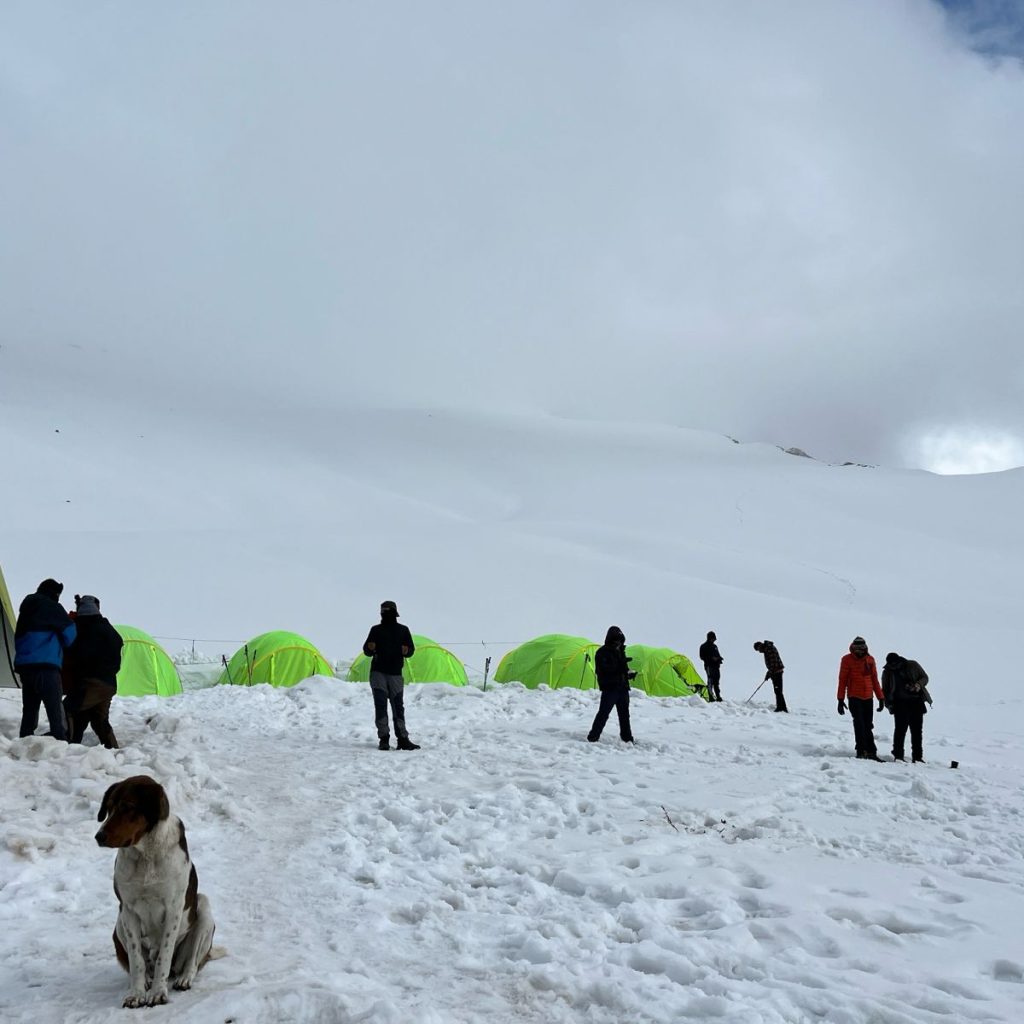
Here are some highlights of the Sar Pass Trek:
- Scenic Beauty: The trek takes you through beautiful forests of oak, pine, and deodar trees, offering stunning views of the surrounding Himalayan ranges. You’ll come across enchanting meadows, gushing streams, and charming villages, making it a visual treat for nature lovers.
- Sar Pass: The highlight of the trek is reaching the Sar Pass, which sits at an altitude of approximately 13,800 feet (4,200 meters). The pass offers panoramic views of the snow-clad peaks of the Parvati Valley, Tosh Valley, and the mighty Himalayas.
- Challenging Terrain: The Sar Pass Trek is considered moderately difficult, making it an ideal choice for trekkers looking for a challenge. The trail includes steep ascents, narrow ridges, and tricky descents, which add an adventurous element to the journey.
- Camping Experience: During the trek, you’ll get to experience camping in the serene Himalayan wilderness. Camping sites like Grahan, Min Thach, Nagaru, and Biskeri Thach offer stunning views and a chance to connect with nature.
- Cultural Interaction: The Sar Pass Trek takes you through traditional Himachali villages where you can interact with the locals and get a glimpse into their way of life. It’s an opportunity to learn about the local culture, traditions, and cuisine.
- Adventurous Activities: The Sar Pass Trek also offers opportunities for adventure activities like rappelling and rock climbing. These activities add an extra thrill to the overall trekking experience.
- Hot Springs: After completing the Sar Pass Trek, you have the option to visit the nearby Manikaran hot springs. These natural hot water springs are considered sacred and are believed to have medicinal properties. It’s a perfect way to relax and rejuvenate after the trek.
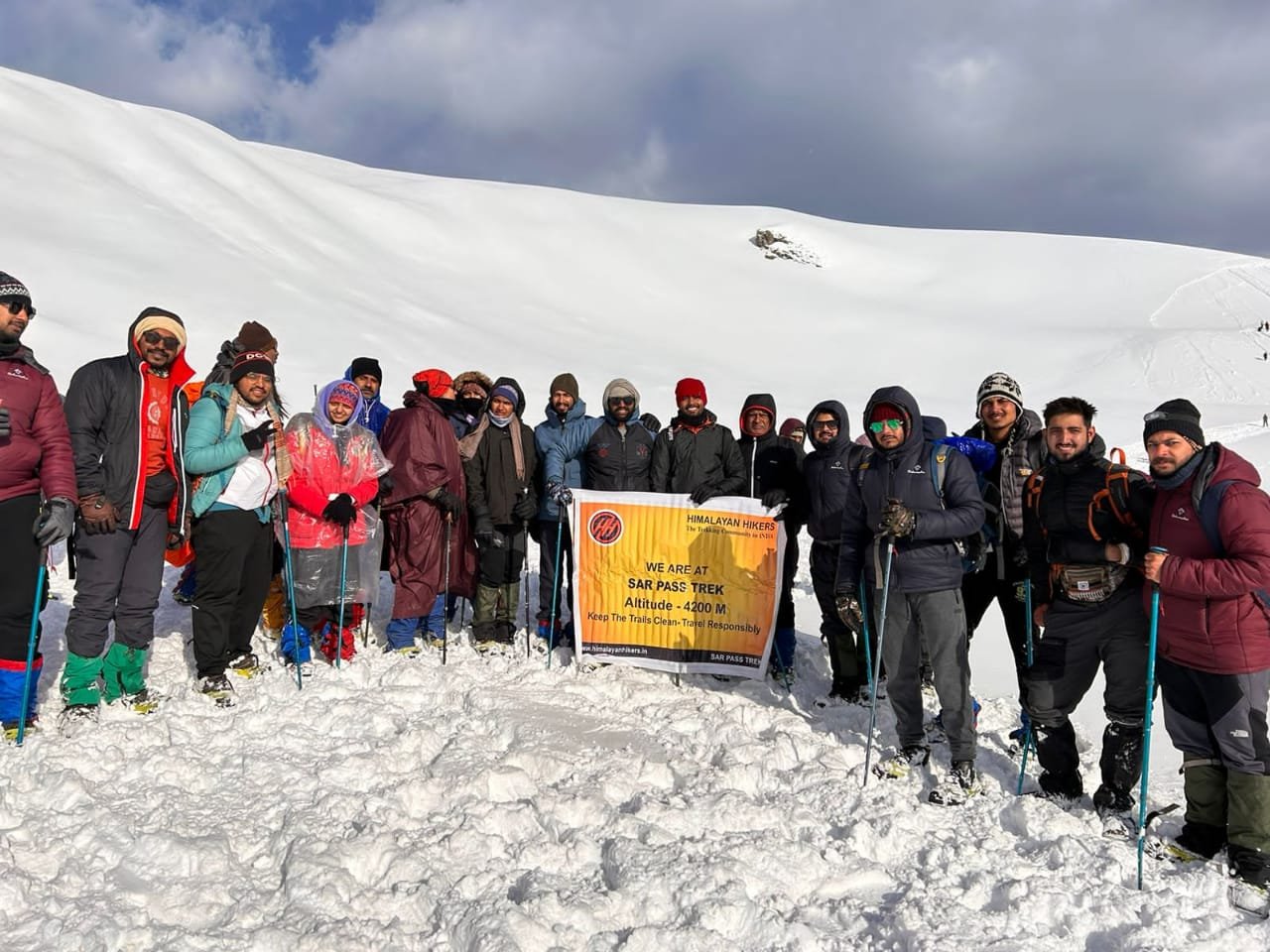
This trek will surely give an Adrenalin rush and thrilling experience adorned with alpine forests, wildflowers, and magical valleys.
Sir Pass Trek is a high-altitude mountain pass trek located in the state of Himachal Pradesh in India. It is considered to be one of the most challenging and scenic treks in the region. The trek begins from the village of Kasol and takes you through the lush green forests, meadows, and valleys of the Parvati Valley.
One of the unique features of Sir Pass Trek is the diverse landscapes and terrain it covers. The trek takes you through pine forests, river streams, and vast meadows, and also involves crossing high-altitude passes covered in snow and ice. This diversity in terrain and landscape makes the trek all the more challenging and exciting for adventure seekers.
Another special aspect of the Sir Pass Trek is the breathtaking views it offers. During the trek, you will get to witness stunning vistas of snow-capped peaks, glaciers, and valleys. The trek also takes you through remote villages and hamlets where you can experience the local culture and traditions.
Overall, the Sir Pass Trek is a unique and challenging adventure that offers a truly unforgettable experience for trekkers and nature lovers.
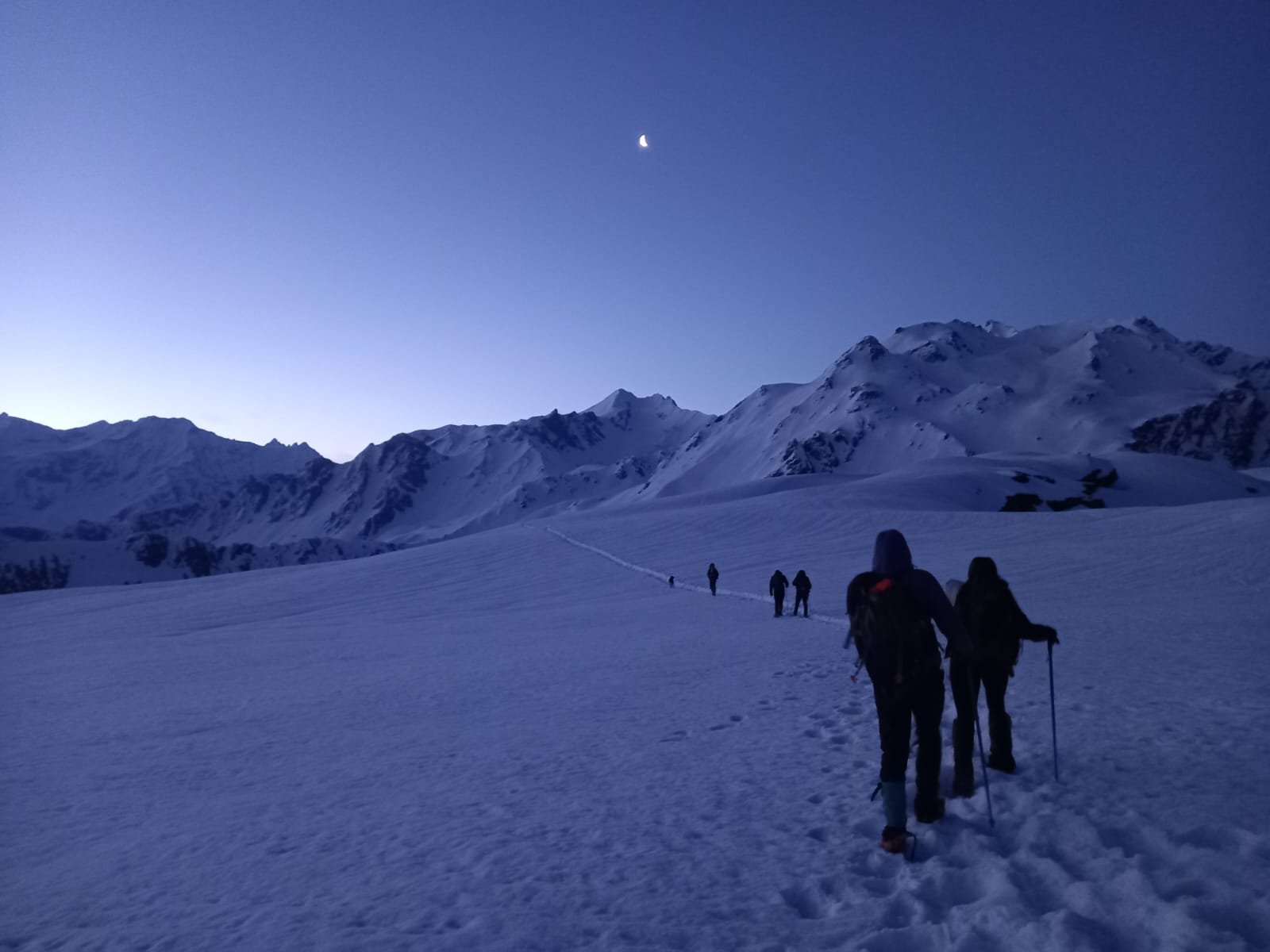
PASS by a glacial Lake SAR Himachal Pradesh
SAR means Lake in the local language, this trek which is at an altitude of 13,816 feet is named Sar Pass because you have to PASS by a glacial Lake “Sar”. It lies in the Parvati valley of Himachal Pradesh and the starting point of this trek is Kasol.
Because of its ease of difficulty, this trek is ideal for first-time trekkers. It’s a classic choice for those who want to explore a variety of terrain all in one trek. This trail provides trekkers with a range of experiences, including forests, meadows, quaint villages, and snow-covered mountains.
- Experience the majestic views and local legends of these spectacular snow-capped peaks.
- Get a chance to explore the wild and exotic vegetation of the Himalayas. Pink rhododendrons painting the trails at various points is a sight not to be missed
- Challenge yourself to explore the thrill of various ascends and descends.
- Immerse yourself in the breathtaking view from the top of Sar Pass.
- The lavish green meadows of Biskeri Thatch would exceptionally persuade you to yearn for more.
- Bring back a lot of souvenirs and memories from this journey.
Sar Pass Trek is an Ultimate Trek for Beginners
One can experience all kinds of trails, and go through Himalayan old fashioned and alluring villages, wide and narrow meadows and forests.
You get to experience terrain varieties on this trek and its starting point is Kasol , away from cities . The people from different areas visit this place and it’s a famous tourist destination.
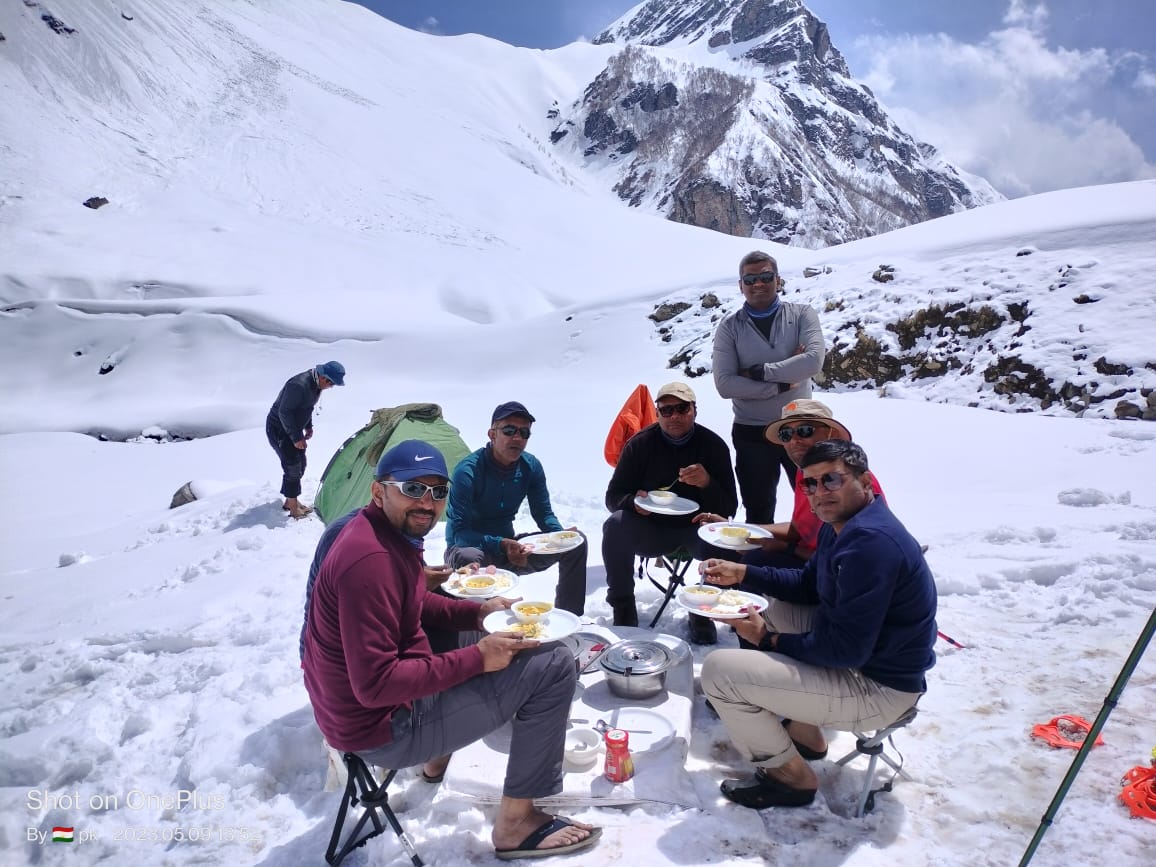
Beauty in Abundance in Sar Pass Trek
Sar Pass has got inherent beauty, peace and adventure, everything! Start from Kasol and trek through rich forest to reach Grahan village .
The views of Parvati valley are spell binding and will leave you speechless.
Trek through Biskeri Thach, a wide meadow and this trek will take you to the heavenly Sar Pass.
Some of the trek highlights
The base camp for this trek is Manali, which is located near the Parvatiriver’s banks in the Parvati valley. The trek to Sar officially begins in Kasol, a town well-known for its pretty coniferous forest and mountain streams. The trek trails through dense forests and progresses to a total snow-covered setting. The trail then further loops through pining forests, charming old-world villages, majestic snow-capped mountains, and some of the most breathtaking scenery.
Rhododendrons abound in the forest near the descent; trekkers can expect to be taken aback by the breathtaking scenery. The Nagaru campsite which is also the highest point during the entire trek is blessed with beautiful mountains across the Parvati valley. It arrives after the shepherds trail of Mung Thatch. During the trek, hikers pass through several small meadows, most of which are grazed by villagers with their livestock
Things to Look out for-
- The trek is certain to provide unrivalled feelings of accomplishment.
- Various villages with many opportunities to interact with the locals will keep you entertained throughout the journey.
- Explore the enthralling forest of rhododendrons.
- Various ascents and descents will encourage you to put your endurance to the test and eventually overcome them.
- The panoramic view of snow-covered trails and peaks from the top is well worth the effort trekkers will expend on their journey.
- Camping under the clear night sky filled with stars is an experience in and of itself
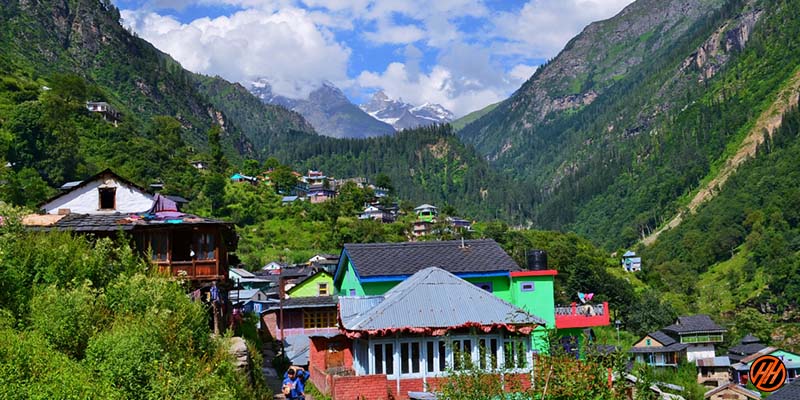
Before heading towards the itinerary, it is really essential to perceive the reason behind choosing the Sar Pass
Sar Pass trek is a high-altitude mountain trek Altitudes is 4200 Meters
The Starting trail is easy to moderate as compare to other treks this is an easy to moderate trek. So, this trek is for beginners, or family or school tour. First time can easily do this trek.
Need proper gear & clothing for sub-zero temperature?
You got to see so many heavenly bodies at one place like the panoramic view of the mountains of Parvati Valley, you can see pine forests, different variety of flora and fauna
I think Do spare time in Interaction with our local’s team, and you will get to know about some of the ancient tales of Indian mythology and our local cultures, this is good ideas for trekkers
Beautiful landscapes so carry proper photo gear & Extra battery backup.
The backpack should not exceed 12 kg only
For Himalayan Hikers or trekkers, it’s crucial to have some emergency medical support available, given the remote and rugged terrain they often traverse. Here are some essential medical supplies to consider carrying:
- First Aid Kit : Include bandages, antiseptic wipes, adhesive tape, gauze pads, scissors, tweezers, and a CPR mask.
- Oxygen cylinder- Oxygen can be beneficial in alleviating symptoms of altitude sickness, such as headache, dizziness, nausea, and shortness of breath. Administering oxygen can provide relief and help prevent the condition from worsening.
- Personal Medications : Any prescribed medications should be carried in sufficient quantities.
- Pain Relief : Ibuprofen or acetaminophen for pain relief in case of minor injuries or headaches.
- Antihistamines : For allergic reactions and insect bites.
- Anti-diarrheal Medication : Such as loperamide, in case of gastrointestinal issues.
- Water Purification Tablets : In areas where clean water may not be readily available.
- Blister Treatment : Moleskin or blister pads for foot care.
- Tweezers : For removing splinters or ticks.
- Emergency Blanket : To keep warm in case of exposure.
- Whistle and Signal Mirror : For attracting attention in emergencies.
- Flashlight or Headlamp : Essential for navigating in the dark or signaling for help.
- Emergency Communication Device : Such as a satellite phone, PLB (Personal Locator Beacon), or a two-way radio for calling for help if needed.
- Basic Wilderness First Aid Guide : To assist in treating common injuries or illnesses.
- Sun Protection : Sunscreen, sunglasses, and a wide-brimmed hat to protect against sunburn.
- Emergency Shelter : Lightweight emergency shelter or tarp for protection from the elements.
It’s also essential for hikers to have basic knowledge of first aid and wilderness survival skills. Additionally, informing someone of your hiking plans and expected return time can be crucial in case of emergencies. Always be prepared and stay safe while exploring the beautiful but challenging Himalayan terrain.
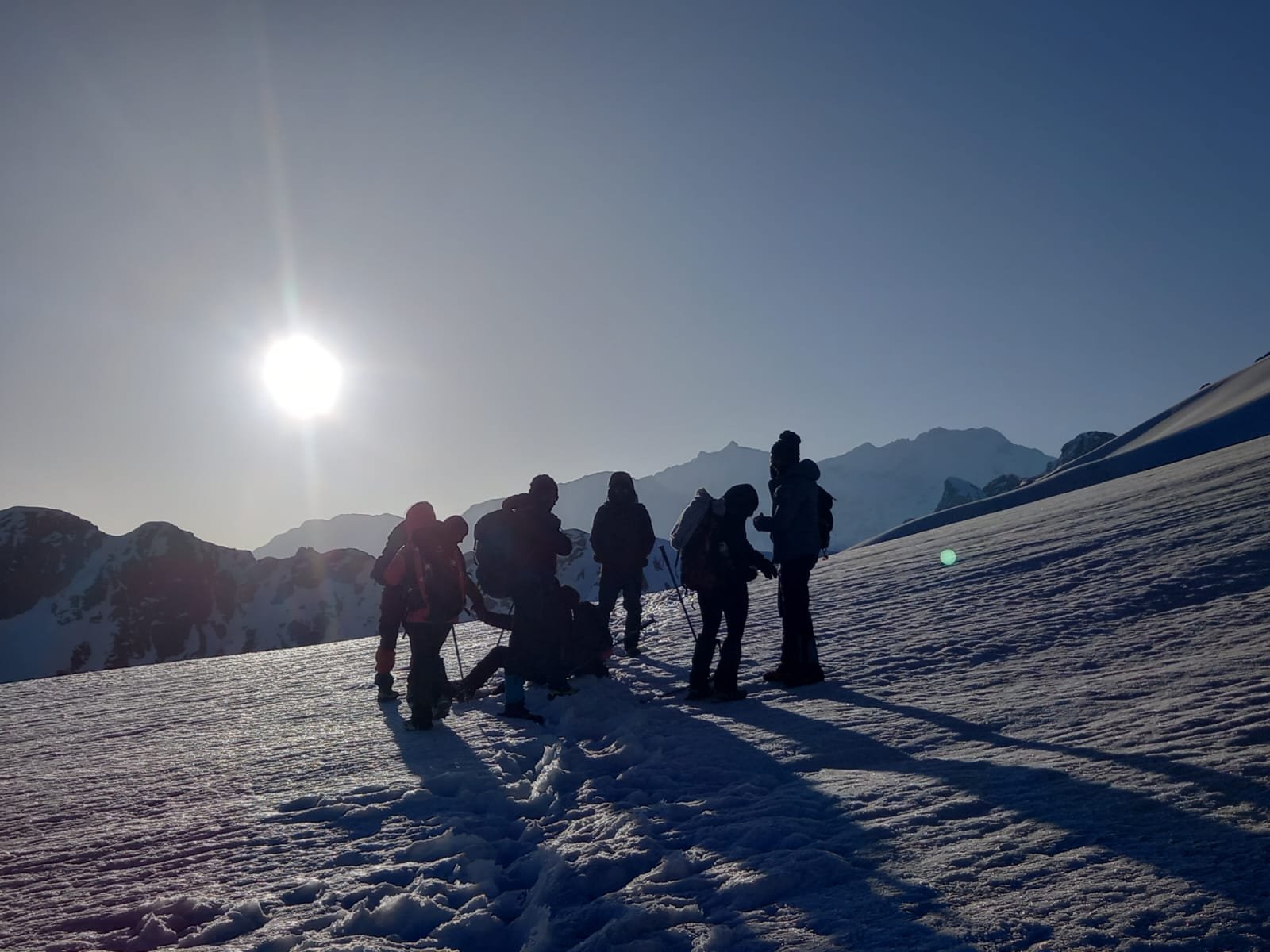
Key Points of Sar Pass Trek
Duration: – 4 Nights 05 days from Kasol to Kasol
Base camp: – Grahan base camp
Summer Temperature: – 13°C to 17°C and Night: 0°C to 7°C
Sar Pass Altitude – 4200 m
Best Time: – April, May, June, 2024
Trek Level: – Moderate
Trek distance: – On foot 37 km – By taxi km by Taxi
Group Size: – A maximum 25 people
The altitude covered in the Sar Pass trek
Grahan base Camp- 2350 m
Mini Thatch- 3400 m
Naguru-3800 m
Sar Pass- 4200 m
Biskeri Thatch- 3350 m
Barsheini- 2400 m
Short Itinerary of Sar Pass Trek
Day 1 : Pickup from Kasol Bus stand Same day Trek Kasol camp to Grahan village (07 km) (5/6 Hours) uphill (2350m)- overnight stay at Grahan village
Day 2 : Trek from Grahan to Mini Thach (07 km) ( 4/5 hours) (3400 m) overnight stay at Camp
Day 3 : Trek from Mini Thatch to Naguru (05 km) (4/5 hours) (3800 m) overnight stay at Camp
Day 4 : Trek from Naguru – Sar Pass- 13875 ft) to Biskeri Thatch (12 km) (6/8hours) (6 hours) (3350 m) overnight stay at Camp
Day 5 : Trek from Biskeri Thatch to Pulga (06 km) (4/5 hours) (2400 m) same day drive to Kasol 22 km by taxi
Best Time to Visit Sar Pass Trek
The best time to undertake the Sar Pass Trek is during the summer and post-monsoon seasons, which typically fall between May and October. Here’s a breakdown of the different seasons and their characteristics:
- Summer Season (May to June): This is the ideal time for the Sar Pass Trek, as the weather is pleasant with mild temperatures during the day and cool nights. The trails are usually clear of snow, allowing for a relatively easier trek. The meadows are in full bloom, offering vibrant landscapes and picturesque views.
- Monsoon Season (July to August): The monsoon season brings heavy rainfall to the region, making the trekking trails slippery and risky. It is not recommended to undertake the Sar Pass Trek during this time, as the chances of landslides and flash floods increase.
- Post-Monsoon Season (September to October): After the monsoon season, the weather starts to clear up, and the landscapes become lush green again. This period is considered the shoulder season for the Sar Pass Trek. The crowds are thinner compared to the summer season, and the weather remains favorable for trekking. However, towards October, temperatures start to drop, especially during the nights, so you should be prepared for colder conditions.
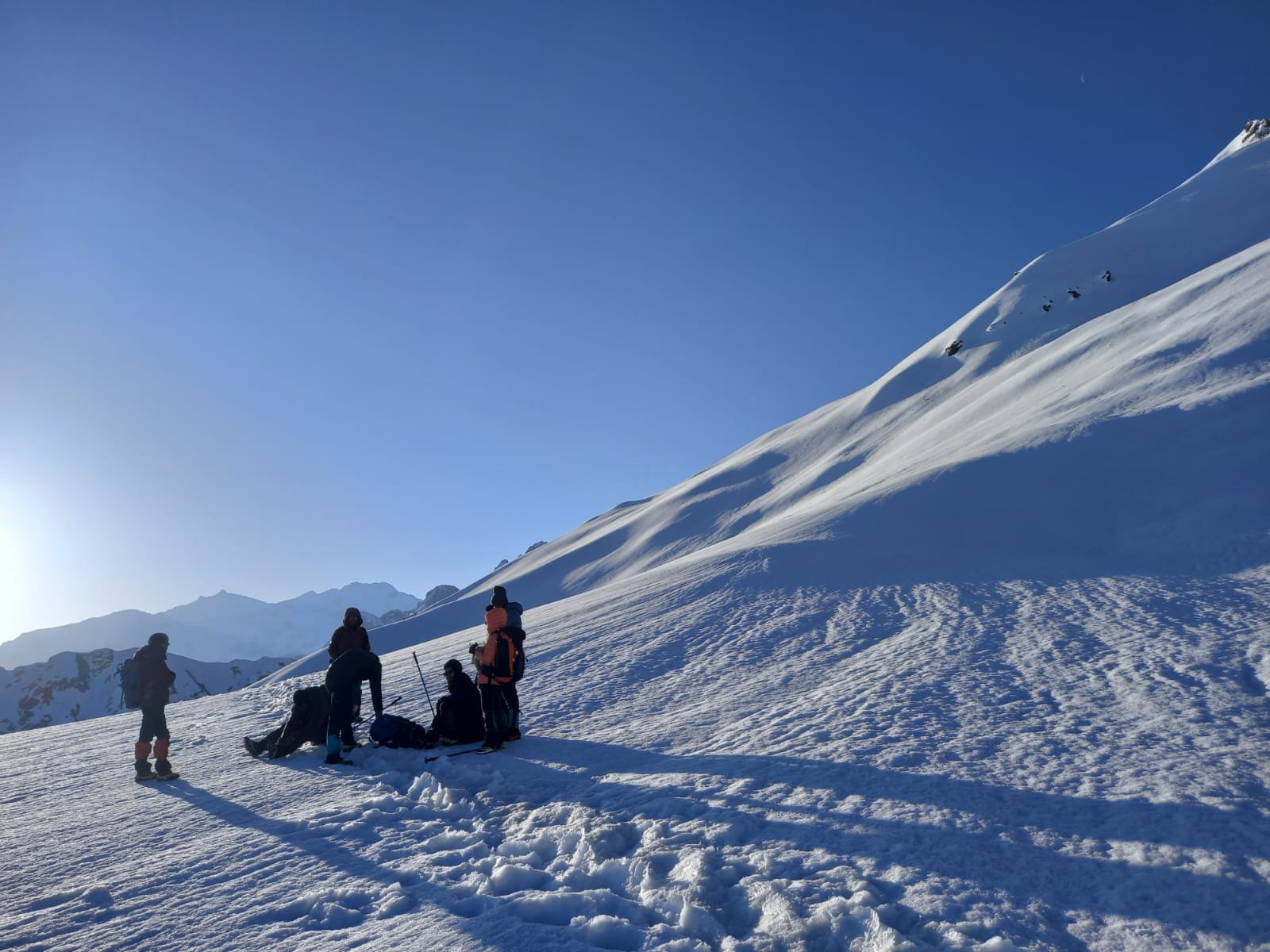
1) Detailed Itinerary
2)Is it safe
3)Difficulty level
4)Weather conditions
5)Things to carry
6)Connectivity and transaction
7)includes and excludes
8)How to reach
Is it safe Trek?
Set amidst the high altitude ranges, concerns regarding Sar Pass trek safety are indeed very valid questions. We have all the possible probabilities calculated if anything goes off the schedule.
At every stop point of the journey, trekkers will be going through a properly guided session informing them about the upcoming terrains. All our professionals strive their best to provide trekkers with the best experience possible.
Difficulty level
The Sar Pass Trek is considered a moderate trek, suitable for trekkers with some prior trekking experience. Here are some factors that contribute to its level of Moderate or difficulty:
- Altitude: The trek reaches an altitude of approximately 13,800 feet (4,200 meters) at Sar Pass. As you ascend to higher altitudes, the air becomes thinner, and the oxygen levels decrease. This can cause altitude-related challenges such as shortness of breath, fatigue, and altitude sickness. It is essential to acclimatize properly, stay hydrated, and listen to your body’s signals.
- Terrain: The trail consists of various terrains, including steep ascents, narrow ridges, rocky sections, and snow patches, especially in the early summer months. You will encounter steep climbs and descents, requiring good physical fitness, balance, and endurance. The terrain can be challenging and demanding at times, requiring careful footing and cautious navigation.
- Weather Conditions: Weather conditions in the mountains can be unpredictable, even during the best trekking seasons. You may encounter rain, snow, and cold temperatures, especially at higher altitudes. It is important to pack appropriate clothing and gear to withstand changing weather conditions.
- Duration and Distance: The Sar Pass Trek usually takes around 04 nights 05 Days days to complete, covering a distance of approximately 37 kilometers Each day involves trekking for several hours, covering varying distances and altitude gains. It requires a good level of stamina and endurance to sustain the trekking duration and distances.
- Camping and Facilities: The trek involves camping in tents at designated campsites along the route. Basic facilities like toilet tents and a limited water supply are available, but you should be prepared for rustic camping conditions.
Weather conditions
Weather conditions depend on the time of the year trekkers are traveling. Months from May to October experience moderate temperatures during the day with substantially colder nights
What to Pack for Sar pass trek clothes?
When packing for the Sar Pass Trek, it’s important to consider the varying weather conditions and the duration of the trek. Here’s a suggested list of clothing items you should pack:
- Moisture-wicking T-shirts: Lightweight and quick-drying shirts to keep you comfortable during the trek.
- Thermal tops: For colder days or nights at higher altitudes.
- Fleece jacket or lightweight down jacket: Provides warmth during chilly mornings and evenings.
- Insulated trousers: To keep your legs warm in colder temperatures.
- Waterproof and windproof jacket: Protects you from rain, snow, and chilly winds. Look for a jacket with a hood for added protection.
- Waterproof and windproof trousers: To keep your legs dry during wet or snowy conditions.
- Quick-drying and comfortable trekking pants or trousers. It’s recommended to carry at least two pairs.
- Sun hat or cap: Provides shade and protects from the sun’s rays.
- Beanie or warm hat: Keeps your head warm during colder days or at higher altitudes.
- Buff or neck gaiter: Versatile accessory that can be used as a neck warmer, face cover, or headband.
- Lightweight gloves: Protects your hands from cold temperatures and wind. Carry an extra pair in case one gets wet.
- Sturdy trekking boots: Waterproof and ankle-supporting boots with good traction.
- Comfortable trekking socks: Carry multiple pairs of moisture-wicking socks to keep your feet dry and blister-free.
- Rain cover for your backpack: Keeps your gear dry during rainy or snowy conditions.
- Sunglasses: Protects your eyes from harsh sunlight and glare from snow.
- Trekking poles: Provide stability and support, especially during steep ascents and descents.
- Thermal innerwear: Optional but helpful for colder temperatures.
Remember to pack lightweight and moisture-wicking clothing to ensure comfort during the trek. Layering is key to adjust to changing temperatures throughout the day. Additionally, carry a small backpack for daily essentials like water bottles, snacks, sunscreen, and a first aid kit.
It’s important to pack according to the season and weather conditions at the time of your trek. Consider checking with local trekking agencies or experienced trekkers for any specific recommendations based on the current conditions.
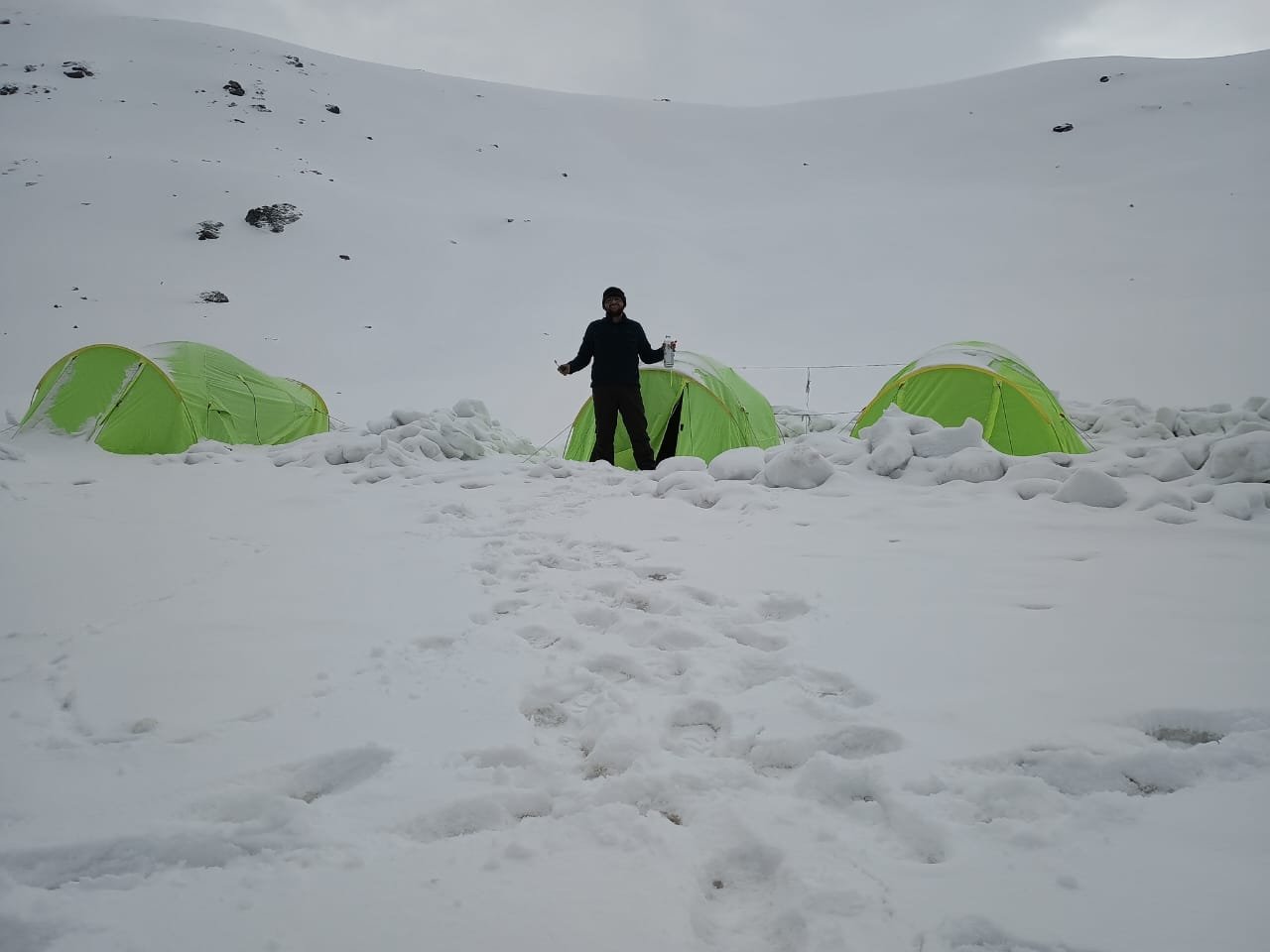
Other trekking Essentials-
Connectivity and Transactions
1) Because connectivity along the route is unpredictable, we urge people to do all of their work ahead of time.
2) Trekkers will be provided with walkie-talkies beforehand in case of emergency
3) Last ATM transactions available will be at Kasol but we recommend travelers to collect cash beforehand or while in Manali as ATM available at other places might not dispense cash at times.

How to Reach Kasol for Sar Pass Trek?
To reach Kasol, the base village for the Sar Pass Trek, you can follow these general directions:
By Air: The nearest airport to Kasol is Bhuntar Airport, located approximately 31 kilometers away. You can take a flight to Bhuntar Airport from major cities like Delhi or Chandigarh. From the airport, you can hire a taxi or take a local bus to Kasol.
By Train: The nearest major railway station to Kasol is Pathankot Railway Station, which is well-connected to major cities in India. From Pathankot, you can take a bus or hire a taxi to reach Kasol. Another option is to take a train to Chandigarh Railway Station and then continue your journey to Kasol by bus or taxi.
By Road: Kasol is well-connected by road and can be reached by bus or taxi from various cities. Here are a few common routes:
- From Delhi: You can take a bus from Delhi to Bhuntar, which is the nearest major town to Kasol. From Bhuntar, you can take a local bus or hire a taxi to reach Kasol, which is approximately 30 kilometers away.
- From Chandigarh: You can take a bus or hire a taxi from Chandigarh to Kasol. The distance between Chandigarh and Kasol is around 275 kilometers.
- From Manali: If you are coming from Manali, you can take a local bus or hire a taxi to Kasol. The distance between Manali and Kasol is approximately 80 kilometers.
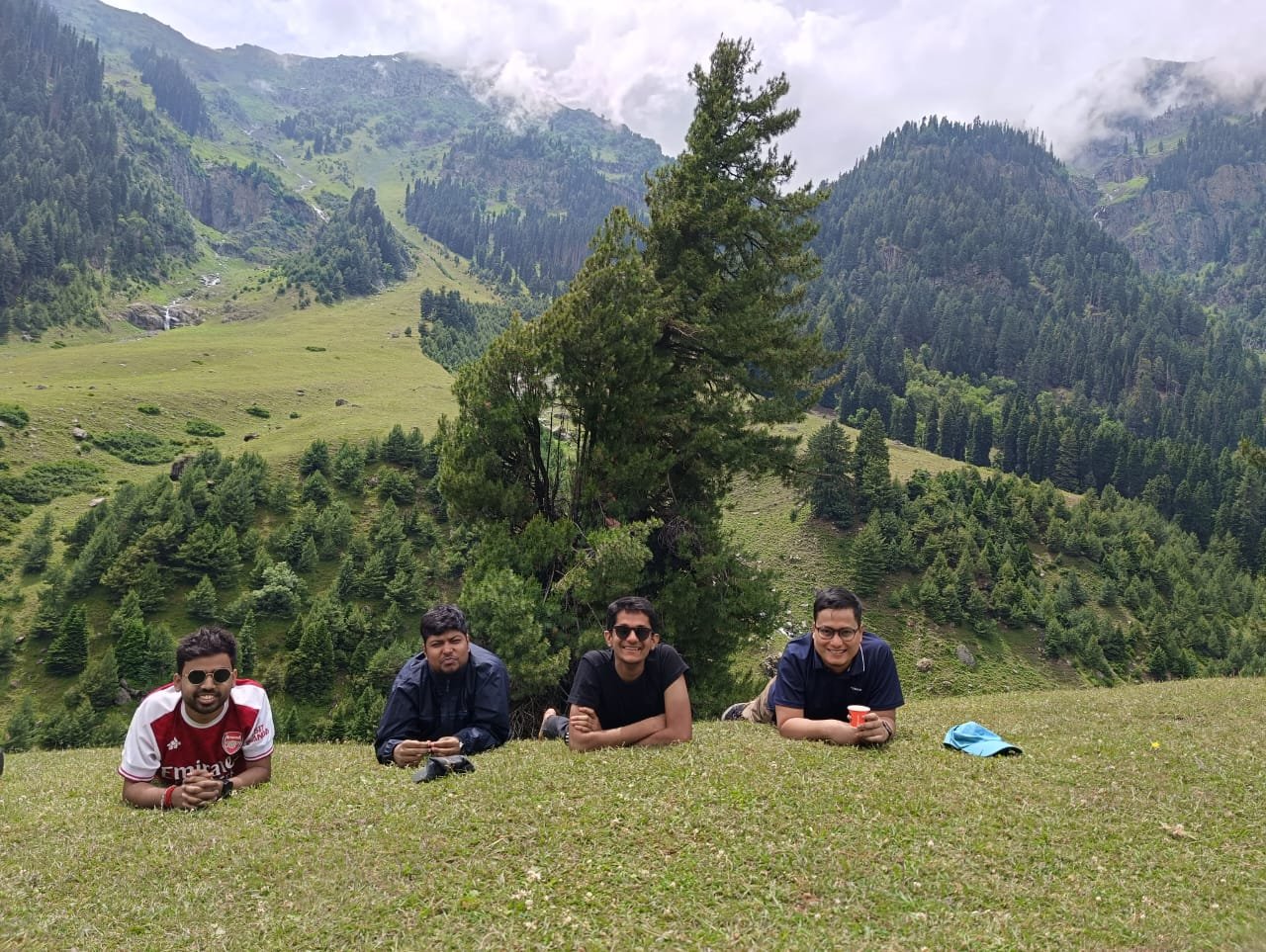
. Some important points to note-
- Please note that we don’t provide timings schedules for transportation before Manali. Subject to various conditions the scheduled timings and availability of particular rides may differ. We recommend trekkers to reach out our teams for any queries. You can drop an email or call us for an initial guided session.
- Our teams will be collecting trekkers at fixed points of airports, railway stations and bus stands.
- It is recommended that unless any delay arrives, trekkers are advised to reach the destinations at least 2 hours prior.
Things Himalayan Hikers recommend
As previously stated, a camera, as well as spare batteries and memory cards, are recommended. We can assure and guarantee that you will be stopping frequently along the trail to observe the grandeur of the trekking experience.
We strongly recommend trekkers to prepare beforehand for the journey ahead. Regular practicing physical fitness and mental endurance will surely assist trekkers in great times.
After the trek, we strongly encourage trekkers to tag us on social media when they post any memories from the trip; this will not only prove invaluable to us with our work but will also serve as a motivational example for all of our experts.
Why you should choose us
We’re here to give you the greatest experience possible through the eyes of highly skilled and qualified specialists who have a passion for adventure sports. We are community members attempting to promote our favorite adventure sports while also supporting local businesses. We, at Himalayan Hikers, dedicate ourselves to providing you with an unforgettable experience.
What do we do for safety in the Sar Pass trek?
First of all, the safety of trekkers is much more for us, if you see in the trek, then there are all the risks, which I do not think about.
Himalayan Hikers worry more about you that no one should ever have any problem in the trek.
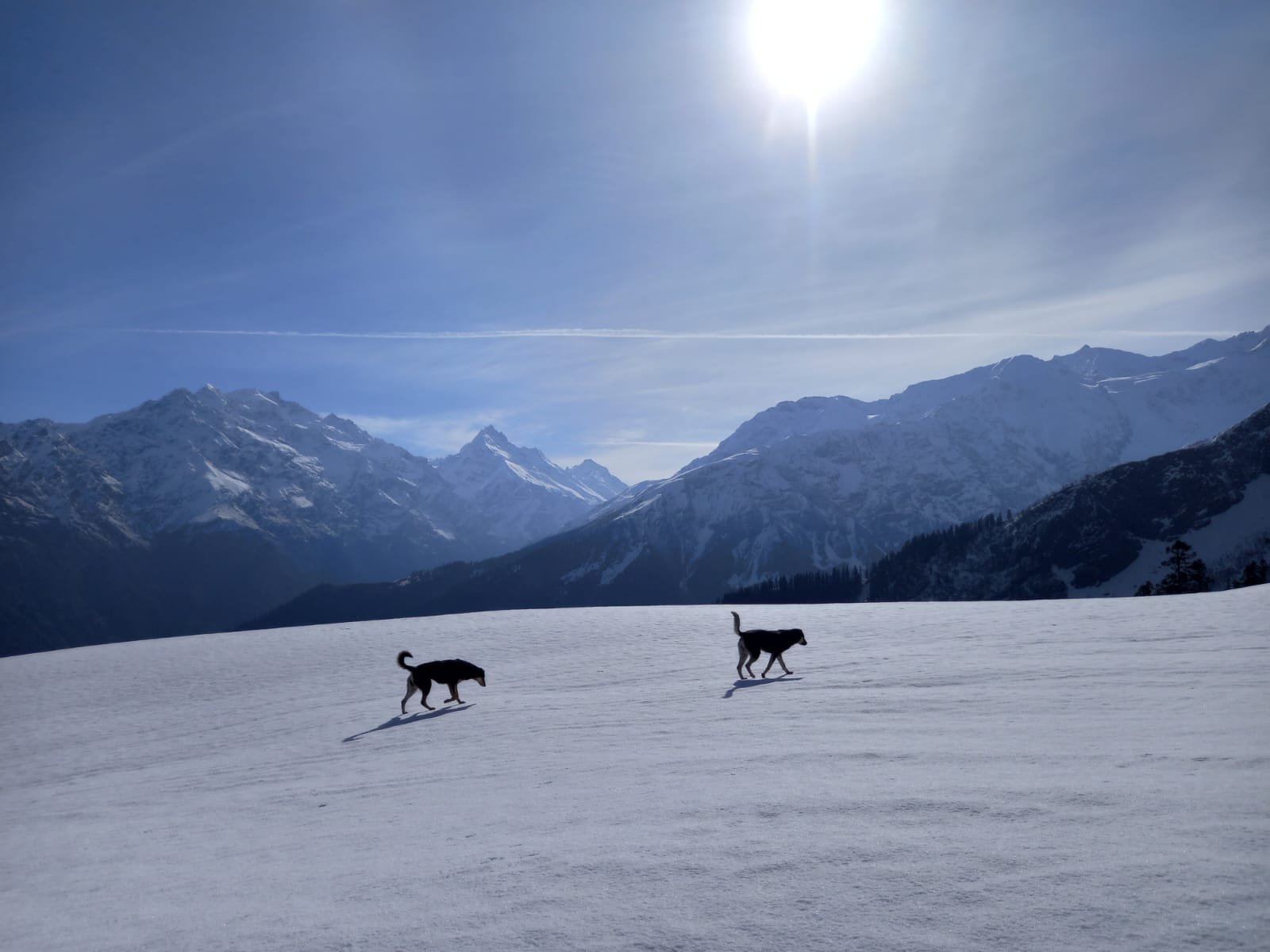
What should we and you keep more safety in the trek
- Whenever you are going for any trek, it is very important that you go completely fit and ready.
- Sar Pass trek is Moderate, if you make your feet and your mind calm and strong, you will find the trek very easy.
- While trekking, keep in mind that you are walking on the right route or not always with your guide.
- Most people look somewhere and where they are walking, this can cause twitching in your legs, which can ruin your entire trek.
- It is important to ask your doctor if you have any medical problems
- I should always keep my medical kit with me, it is very important.
- Himalayan Hikers always keep a medical kit with you, such as oxygen cylinders, medicine to be given in emergency on the trek
- If any trekkers have any more problems, then they are brought back to the base camp by laying them in the stretcher.
- Our Sar pass trek camp is around 6000 ft to 11,000 feet where you can not have any problem of oxygen, this is tree line area
- In case of any medical problem, the help of your guide or well-informed trekkers should be taken
- If there is major health problems in this trek , then Nearest Hospital is in Manali/Bhunter which is about 67 Kms away from Sar pass trek
- Our camps also move forward day by day and our bodies also work with the altitudes that are safe for trekkers
- Along with the trek we keep getting acclimatization
- Himalayan Hikers always take care of their trekkers anyway it is one of our local trek where we live every day
How to get fit for Sar Pass Trek in Himachal Kasol?
Here are some tips to help you get fit for the trek:
- Cardiovascular Fitness: Trekking involves long hours of walking and endurance. Engage in activities that improve your cardiovascular fitness, such as jogging, cycling, swimming, or brisk walking. Start with shorter distances or durations and gradually increase the intensity and duration of your workouts over time.
- Leg Strength and Endurance: Trekking requires strong leg muscles to tackle uphill and downhill sections. Incorporate exercises like squats, lunges, step-ups, and calf raises into your fitness routine. Include both strength training and endurance-building exercises for your legs.
- Core Strength: A strong core is essential for maintaining balance and stability during the trek. Include exercises like planks, Russian twists, mountain climbers, and sit-ups to strengthen your core muscles.
- Stair Climbing: Find a nearby staircase or use a stair-climbing machine at the gym to simulate the uphill and downhill sections of the trek. Regular stair climbing workouts will help build strength and endurance in your legs.
- Backpack Training: As you will be carrying a backpack during the trek, gradually increase the weight of your backpack during your training sessions. Start with a lighter load and gradually add weight to simulate the weight you’ll carry during the trek.
- Flexibility and Stretching: Engage in regular stretching exercises to improve flexibility and prevent muscle stiffness. Focus on stretching your leg muscles, lower back, shoulders, and neck.
- Mental Preparation: Trekking requires mental resilience and determination. Prepare yourself mentally by setting realistic goals, visualizing the trek, and staying positive. Practice mindfulness and relaxation techniques to manage stress and keep a calm mindset during challenging moments.
- Hydration and Nutrition: Stay hydrated throughout your training period and during the trek. Maintain a balanced diet rich in carbohydrates, proteins, and essential nutrients to fuel your body and aid in recovery.
Himalayan Hikers – Provided food During the Sar Pass Trek
– We serve five -05 times meals a day including- Breakfast, Lunch, Eevening Snakes, Soup, Dinner, A variety of delectable and healthy food is provided which includes; Indian, Chinese and other Western meals. They are nutritious and keep you fit and healthy on the trek.(Veg or non-veg food) With our local food and Day Pack, for Summit Day like fresh fruits
Food Menu – Roti + Rice + Salad + Papad +Matter paneer +Daal +mix veg+ daily more vegetable +sweet+ Bread +Omelets + jam + butter +Muesli, Milk+Banana+ Allo parantha +Tea & coffee Cornflakes, Milk +Egg bhurji +Bread, Peanut Butter +Pancake +Plain parantha +Fruits+ Porridge Oats+ +Bread & cheese +Poha +Boiled egg + Gulab Jamun+ Custard+ Jalebi+ Chilla +Honey+ Puri + Chole more
Note: – This is only list Himalayan Hikers Team or Cook provide you more healthy food and more items of per day menu
The type of food provided during a trek can vary depending on factors like the location, duration, and the trekking company or organization you’re with. However, there are some common types of food that are often included in trekking provisions:
- Carbohydrates : Foods high in carbohydrates provide energy for the trek. This includes items like rice, pasta, bread, and potatoes. More
- Proteins : Protein-rich foods help with muscle repair and recovery. Common protein sources include lentils, beans, tofu, meat (if available), eggs, and dairy products.
- Fruits and vegetables : These provide essential vitamins, minerals, and fiber. While fresh produce may not always be available, dried fruits and vegetables or canned options might be included.
- Snacks : Trekking often involves long hours of physical exertion, so snacks are important for quick energy boosts. Snacks like nuts, energy bars, trail mix, and chocolate are common choices.
- Local cuisine: Depending on the region you’re trekking in, you might also get the chance to sample local dishes. This can be a delightful way to experience the culture and flavors of the area.
Day 1: Reach Our Base Camp Kasol 8:30 am to 9:00 am Then trek to Grahan Village
- Starting Point: Kasol Bus Stand Base Camp of H.H
- Destination: Grahan Village
- Distance: Approximately 07 kilometers
- Time Required: Around 4-6 hours, depending on your pace and breaks
- Difficulty Level: Moderate
Trek Details:
- Kasol is well-connected by road, and you can easily reach there by bus or taxi from nearby towns like Bhuntar or Manali. Once you arrive at Kasol Bus Stand, you can start your trek.
- The trail starts from Kasol and leads towards Grahan Village. You’ll need to cross the Parvati River and then start ascending through dense forests.
- The initial part of the trek involves a gradual ascent through the forest, with occasional steep sections.
- The trail is well-marked, but it’s recommended to have a local guide or a map with you.
- As you ascend, you’ll pass through lush greenery, pine forests, and possibly encounter some streams.
- After a few hours of trekking, you’ll reach the beautiful Grahan Village, situated at an altitude of around 7,700 feet above sea level.
- Grahan Village is a quaint Himalayan hamlet, offering stunning views of the surrounding peaks and valleys.
- The trek from Kasol to Grahan Village is considered moderate in difficulty.
- While the trail is well-defined, there are some steep sections, especially during the ascent.
- Proper trekking gear, including sturdy hiking shoes, water, snacks, and a rain jacket (depending on the weather), is recommended.
- It’s also essential to pace yourself and take regular breaks, especially if you’re not used to hiking at higher altitudes.
- Start your trek early in the morning to make the most of daylight hours and avoid trekking in the dark.
- Carry an adequate amount of water and snacks to keep yourself hydrated and energized throughout the trek.
- Respect the local culture and environment. Avoid littering and follow the principles of Leave No Trace.
- Check the weather forecast before starting your trek and be prepared for changes in weather conditions.
Day 2 : Trek from Grahan to Mini Thatch
- Starting Point: Grahan Village
- Destination: Mini Thatch
- Distance: Approximately 7-8 kilometers
- Time Required: Around 4-5 hours, depending on your pace and breaks
- From Grahan Village, head towards the trail leading to Mini Thatch. You’ll find signposts or locals who can guide you in the right direction.
- The trail initially ascends through dense forests, similar to the previous segment from Kasol to Grahan.
- You’ll pass through scenic landscapes, lush greenery, and possibly encounter some streams along the way.
- The trek involves a significant ascent as you make your way towards Mini Thatch.
- The trail may become steeper and more challenging compared to the previous segment. Be prepared for some strenuous sections.
- As you climb higher, you’ll be rewarded with breathtaking views of the surrounding valleys and snow-capped peaks.
- Mini Thatch is a beautiful meadow nestled amidst the mountains, offering a tranquil setting for camping or resting.
- The trek from Grahan to Mini Thatch is considered moderate to difficult, primarily due to the steep ascent.
- You’ll need to have a good level of fitness and stamina to tackle the uphill sections.
- Proper trekking gear, including sturdy hiking shoes, trekking poles (if required), water, snacks, and warm clothing, is essential.
- Take regular breaks to catch your breath and enjoy the scenery along the way.
- Start early in the morning to make the most of daylight hours and avoid trekking in the dark.
- Carry sufficient water and snacks to keep yourself hydrated and energized during the trek.
- Be mindful of your surroundings and follow the trail markers or ask locals for directions if needed.
- Take precautions against altitude sickness, especially if you’re ascending to higher elevations.
- Respect the local environment and leave no trace of your visit.
Trekking from Grahan Village to Mini Thatch offers a challenging yet rewarding experience amidst the natural beauty of the Himalayas. Enjoy the journey and embrace the serenity of the mountai
Day 3 : Trek from Mini Thatch to Naguru
Trekking from Mini Thatch to Nagaru is a segment that takes you further into the scenic landscapes of the Parvati Valley, eventually leading you to the base camp for the Sar Pass trek. Here’s a guide for this part of your journey:
- Starting Point: Mini Thatch
- Destination: Nagaru
- Distance: Approximately 5-6 kilometers
- Time Required: Around 3-4 hours, depending on your pace and breaks
- Difficulty Level: Moderate to Difficult
- Depart from Mini Thatch and follow the trail towards Nagaru. The route may be marked with signs or cairns, but it’s advisable to have a local guide or a map to navigate effectively.
- The initial part of the trek involves ascending further through alpine meadows and possibly rocky terrain.
- You’ll continue to enjoy panoramic views of the surrounding mountains and valleys as you gain altitude.
- The trail gradually becomes steeper as you ascend towards Nagaru.
- You may encounter some challenging sections with rocky paths and uneven terrain.
- It’s essential to pace yourself and take regular breaks, especially considering the altitude gain.
- Keep an eye out for any trail markers or signs to ensure you’re on the right path.
- Along the way, you’ll be treated to stunning views of the Parvati Valley below and the towering peaks surrounding you.
- Nagaru itself is situated at a higher altitude, offering breathtaking vistas of the Himalayan landscape.
- The trek from Mini Thatch to Nagaru is considered moderate to difficult, primarily due to the steep ascent and potentially challenging terrain.
- Altitude gain can also be a factor, so it’s essential to acclimatize properly and be prepared for the effects of high altitude.
- Ensure you have the necessary trekking gear, including sturdy hiking shoes, warm clothing, water, snacks, and a first aid kit.
- Start early in the day to make the most of daylight hours and avoid trekking in the dark, especially considering the terrain’s difficulty.
- Stay hydrated and fuel yourself with snacks to maintain energy levels throughout the trek.
- Keep an eye on weather conditions, as they can change rapidly in mountainous regions.
- Follow Leave No Trace principles and respect the environment and local communities.
Day 4 : Trek from Naguru to SAR Pass to Biskeri Thatch
Trekking from Nagaru to Sar Pass and then descending to Biskeri Thatch is one of the most exhilarating segments of the Sar Pass trek, offering breathtaking views and a sense of accomplishment as you traverse high-altitude landscapes. Here’s a guide for this challenging yet rewarding trek:
- Starting Point: Nagaru
- Destination: Biskeri Thatch via Sar Pass
- Distance: Approximately 12-13 kilometers
- Time Required: Around 8-10 hours, depending on your pace and breaks
- Difficulty Level: Difficult
- Begin your trek from Nagaru, situated at a considerable altitude. Ensure you’re properly acclimatized before embarking on this challenging segment.
- The initial part of the trek involves ascending towards Sar Pass. The trail is likely to be steep and rocky, requiring careful footing and endurance.
- As you ascend towards Sar Pass, the trail may become progressively steeper and more challenging.
- You’ll navigate through rugged terrain, possibly encountering snowfields or icy patches, depending on the season.
- Keep an eye out for trail markers or follow the guidance of your guide to stay on track.
- Sar Pass, situated at an elevation of around 13,800 feet, offers breathtaking views of the surrounding peaks and valleys, making the ascent worth the effort.
- Once you reach Sar Pass, take some time to rest and soak in the stunning vistas before beginning your descent towards Biskeri Thatch.
- The descent from Sar Pass to Biskeri Thatch can be equally challenging, with steep gradients and potentially slippery terrain. Use trekking poles for stability if necessary.
- The trail from Sar Pass descends through alpine meadows and forests, providing a contrast to the rugged terrain of the ascent.
- While the descent may be less physically demanding than the ascent, it requires caution to navigate safely, especially on uneven terrain.
- Biskeri Thatch, nestled amidst the mountains, offers a serene camping spot to rest and rejuvenate after the day’s trek.
- The trek from Nagaru to Sar Pass and then to Biskeri Thatch is considered difficult, primarily due to the steep ascent, high altitude, and potentially challenging terrain.
- Proper acclimatization, physical fitness, and trekking experience are essential prerequisites for this segment.
- Ensure you have the necessary equipment, including sturdy hiking shoes, warm clothing, trekking poles, water, snacks, and a first aid kit.
- Start early in the day to allow ample time for the trek and to avoid trekking in low visibility conditions, especially during the descent.
- Stay hydrated and nourished throughout the trek to maintain energy levels.
- Keep a close watch on weather conditions and be prepared for changes in mountain weather.
- Follow Leave No Trace principles and respect the environment and local culture during your trek.
Day 5: Trek from Biskeri Thatch to Pulga road
Trekking from Biskeri Thatch to Pulga Road offers a scenic route through the picturesque landscapes of the Parvati Valley. Here’s a guide for this segment of your trek:
- Starting Point: Biskeri Thatch
- Destination: Pulga Road
- Distance: Approximately 10 kilometers
- Time Required: Around 5/6 hours, depending on your pace and breaks
- Begin your trek from Biskeri Thatch, situated amidst the mountains and alpine meadows.
- The trail initially descends from Biskeri Thatch, gradually leading you towards lower elevations.
- As you descend, you’ll be treated to breathtaking views of the surrounding valleys, lush forests, and distant peaks.
- The trail winds its way through forests, meadows, and possibly small streams, offering a varied and picturesque landscape.
- Along the route, you may pass through or encounter several small villages inhabited by the locals.
- These villages provide a glimpse into the local way of life and may offer opportunities to interact with the residents.
- While the trail is generally well-defined, it’s advisable to have a map or GPS device to ensure you’re on the right path.
- Signposts or markers may guide you along the way, but it’s always helpful to ask locals for directions if needed.
- The trek from Biskeri Thatch to Pulga Road is considered moderate in difficulty.
- While the overall terrain may involve some descents and ascents, it’s generally less challenging compared to higher altitude treks.
- However, be prepared for uneven terrain, rocky sections, and possibly some steep gradients, particularly as you descend towards Pulga Road.
- Start your trek early in the day to make the most of daylight hours and avoid trekking in the dark.
- Carry sufficient water, snacks, and any necessary supplies for the trek.
- Wear sturdy hiking shoes and comfortable clothing suitable for trekking.
- Respect the environment and local communities along the way, and adhere to Leave No Trace principles.
- Check the weather forecast before setting out and be prepared for changes in weather conditions.
- The route from Pulga to Kasol involves driving back along the road you trekked on or taking any alternate routes available. The primary road network connects these two destinations.
- The distance between Pulga and Kasol by road is approximately 15-20 kilometers, depending on the specific route you take.
- The road conditions can vary, but in general, the roads in this region are narrow and winding, often with steep inclines and declines.
- Some sections of the road may be rough or unpaved, especially in more remote areas.
- The driving time from Pulga to Kasol typically ranges from 30 minutes to an hour, depending on traffic, road conditions, and the specific route taken.
- The drive from Pulga to Kasol offers stunning views of the surrounding mountains, valleys, and forests. Be sure to take some breaks along the way to admire the scenery and take photographs.
Mandatory Documents
Please carry the documents given below.
Original and photocopy of government photo identity card- (Aadhar Card, Driving License, Voters ID, etc, Passport and Visa important to foreigners Medical Certificate (First part should be filled by the Doctor and Second part by the Trekker) Declaration Certificates
Note: – Many trekkers commit the same mistake of carrying unnecessary items on a trek which only makes the backpack heavy. It is important to know the right items to carry. It differs from season to season if you are trekking in summers then carry less layers of warm clothing and if you are trekking in winters carry enough layers to protect yourself against chilly cold.
Necessary Items for trekkers

Backpack (50 to 60 liters) A strongly built backpack with good support is compulsory for a trek. (Rain cover is important)
Sturdy Trekking Shoes The shoes should be strong enough with good support. The people ask if sports shoes would be comfortable but it is good to bring the right trekking shoes.
The Clothes You Should Bring On a Trek Avoid keeping extra clothes because it only makes you backpack heavy.
Trek Pants – The jeans are never suitable for a trek so you need at least 2-3 trek pants for treks carry more for longer treks.
Jacket – Jackets are very important to carry on a trek it protects you against the chilly weather. So carry 2 jackets on a week long trek.
Layers of warm Clothing Carry warm woolen layers or fleece. Carry more layers during winter season (at least 2 to 3) and less during summer.
Thermals – The Temperature decreases at night so you might be need thermals for Night.
T- Shirts – Bring those t shirts which dry fast.
Poncho –They are needed if you are trekking on a Rainy day to keep you dry.
Hiking Pole
Water Bottle 2
Cap or Balaclava
Woolen and Waterproof Gloves
Socks (Woolen and Regular)
Torch head light
Personal Toiletry Items – (toothpaste, toothbrush, toilet paper, sanitizer etc.)
Carry Personal Medical Kit
Personal Medical Kit (Carry minimum 5 tablets and maximum 10)
Medicine for Altitude Sickness
Medicine for acidity and discomfort.
Fever and Headache Medicines
Pain Reliever
Motion Sickness Medicine
Medicine for Allergies
Medicine for Diarrhoea
Sprains Cream or Spray
Antiseptic Cream
Stretchable/Elastic bandage
Note:- Please take all medicines only when prescribed by the doctor. In case you face any problem during your trek, discuss and take advice from the Professional guide.
It is important to have some guidelines in place in case something unexpected happens. Here are some general guidelines that may be helpful:
- Have a first-aid kit: Make sure to carry a well-equipped first-aid kit that can be used to treat minor injuries and ailments.
- Follow safety protocols: It is important to follow all safety protocols and guidelines related to the trek. This includes staying on designated trails, avoiding risky or dangerous areas, and staying with your group.
- Have a communication plan: Make sure to have a communication plan in place in case of emergencies. This may include carrying a mobile phone or a satellite phone, or using a walkie-talkie to stay in touch with other members of your group.
- Know the local emergency services: Be aware of the local emergency services available in the area where you will be trekking. This includes knowing the location of the nearest hospital, police station, or rescue service.
- Carry proper gear and equipment: Make sure to carry appropriate gear and equipment for the trek, including proper footwear, warm clothing, and rain gear. This will help you stay comfortable and safe during the trek.
- Follow Leave No Trace principles: Follow Leave No Trace principles and leave the trekking area as you found it. This includes packing out all trash and waste, avoiding damaging vegetation, and respecting wildlife.
- Stay calm and collected: In case something unexpected happens, try to stay calm and collected. Assess the situation and take appropriate action to stay safe and help others in your group.
It’s also a good idea to consult with a local trekking agency or experienced guide before embarking on a trek, as they can provide additional guidance and support to ensure a safe and enjoyable experience.
Are you Looking for Trekking Equipment on Rent?
If any trekker needs trekking equipment on Rent then Himalayan Hikers has the best trekking equipment available on rent.
There are many people behind this who are in great need of it, it is better to hire it at affordable price without spending much money for just a few days.
Rent Costs per Day
1. Hiking shoes Per day Rs. 100/-
2. Hiking Pant Per Day Rs. 100/-
3. Down Jacket Per Day Rs. 100/-
4. Hiking Pole Per Day Rs. 50/-
5. Headlight Per Day Rs. 50/-
6. Trekking Bag 50 to 60 litter Per Day Rs. 50/-
7. Gloves Per Day Rs. 50/-
Trek Equipment You can book directly at the Base Camp of your trek.
01 May to 05 May 2024 (Open)
02 May to 06 May 2024 (Open)
03 May to 07 May 2024 (Open)
04 May to 08 May 2024 (Open)
05 May to 09 May 2024 (Open)
06 May to 10 May 2024 (Open)
07 May to 11 May 2024 (Open)
08 May to 12 May 2024 (Open)
09 May to 13 May 2024 (Open)
10 May to 14 May 2024 (Open)
11 May to 15 May 2024 (Open)
12 May to 16 May 2024 (Open)
13 May to 17 May 2024 (Open)
14 May to 18 May 2024 (Open)
15 May to 19 May 2024 (Open)
16 May to 20 May 2024 (Open)
17 May to 21 May 2024 (Open)
18 May to 22 May 2024 (Open)
19 May to 23 May 2024 (Open)
20 May to 24 May 2024 (Open)
21 May to 25 May 2024 (Open)
22 May to 26 May 2024 (Open)
23 May to 27 May 2024 (Open)
24 May to 28 May 2024 (Open)
25 May to 29 May 2024 (Open)
26 May to 30 May 2024 (Open)
27 May to 31 May 2024 (Open)
28 May to 01 June 2024 (Open)
29 May to 02 June 2024 (Open)
30 May to 03 June 2024 (Open)
31 May to 04 June 2024 (Open)
01 June to 05 June 2024 (Open)
02 June to 06 June 2024 (Open)
03 June to 07 June 2024 (Open)
04 June to 08 June 2024 (Open)
05 June to 09 June 2024 (Open)
06 June to 10 June 2024 (Open)
07 June to 11 June 2024 (Open)
08 June to 12 June 2024 (Open)
09 June to 13 June 2024 (Open)
10 June to 14 June 2024 (Open)
What is Included In This Trek?
Transport Facility Kasol To Kasol
Forest Permit and entrance fee
Accommodation in tents on twin/three share basis
All meals: breakfast, packed lunch, tea, coffee, snacks, soup, and dinner
High-quality Dome tents
Sleeping bags
Separate Toilet tents – Ladies and Gents
Dining Tent
Dining Table
Kitchen team
Radio Walkie-Talkie for Communication
Good Experience Trek Leader guide and Technical guide
Medical Kit
Oxygen Cylinders
Crampons and Gaiters
What is Not Include In This Trek?
Personal Insurance
Medical Certificate
Personal toiletry Items and Personal Medicine kit
On the first day, En Route to base camp Breakfast was Not Included
Last Day En Route Lunch and Dinner are not Included
Porter – if you need porters for your uploading bag – The cost per bag per day is Rs. 800.00 paid to directly our manager at Kasol
6 reviews for Sar Pass Trek
Abhijit Gupta – April 18, 2024
We are 10 friends group successfully completed sar pass trek 12 april to 16 april -2024 Great —experienced, with team Himalayan Hikers , food, our guide, camping all best
Mayuri Deshpande – April 18, 2024
The Trek experience was thrilling and this is a difficult Trek for beginners in the month of April. Wait for the snow to get cleared by May or the beginners can also avoid this Trek. About Himalayan Hikers, the team was very supportive and made our Trek memorable.
Aditya Madan – April 15, 2024
Sar Paas was my second trek with Himalyan Hikers. These 5 days were filled with amazing experiences and unreal scenic beauty. I was literally in the lap of nature. My guide Shiva was super helpful throughout the trek which had snowfall and rainfall almost all days. It was really an awesome experience which enriched my perspective on life. Thanks HH team and Shiva Bhai.
Sanjit kumar Singh – April 15, 2024
Himalayan Hikers best team made our Sar Pass Trek memorable ! thanks kuldeep sir —our guide cooking team, all camp to good all experienced, humble, . Highly recommend Team Himalayan Hikers !” our next trek Kashmir great lakes paka with your same team
Poulomi Saha – April 15, 2024
The Sar Pass trek with Himalayan Hikers was a great experience. Shiva Ji and Sonu Ji, our guides, ensured safety and support throughout the journey. The trek offered breathtaking views of the Himalayas, fostering a sense of connection with nature. As a woman trekker, I felt encouraged, with the guides providing a supportive environment. All the facilities were good. The camaraderie among fellow trekkers added to the enriching experience. Overall, the Sar Pass trek with Himalayan Hikers was a memorable adventure.
Kuldeep sharma – April 15, 2024
Himalayan Hikers made our Sar Pass Trek unforgettable! Shiva ji and Sonu Ji were exceptional guides—experienced, humble, and generous. Their fun-loving nature added joy to every step. Highly recommend Himalayan Hikers for an adventure of a lifetime!”
Your email address will not be published. Required fields are marked *
Name *
Email *
Save my name, email, and website in this browser for the next time I comment.
Related Tours
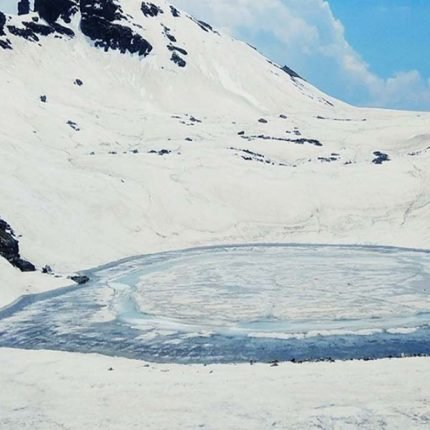
Bhrigu Lake Trek
ONE OF THE MOST BEAUTIFUL GRASSLANDS OF INDIA
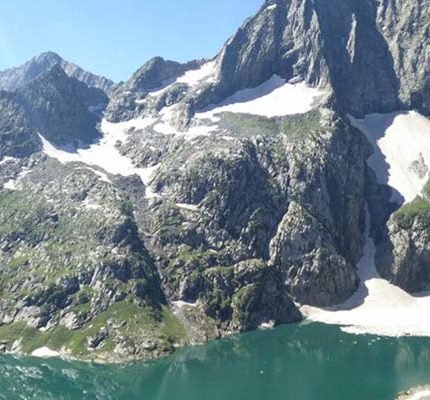
Rohil Basmai Valley Trek
The Rohil Basmai Valley Trek is a versatile trek in Kashmir..
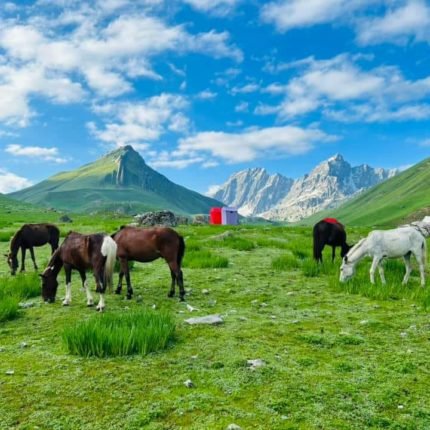
Warwan Valley Trek
Spiti Valley Trek is a stunning and remote region located in the Indian state of Himachal Pradesh.
Price: ₹ 6,500.00
Book the tour
Send a quick enquiry.
- Overview Itinerary Dates Include/Exclude
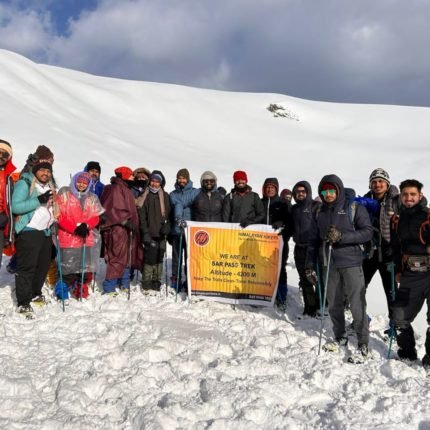

- Trekking & Travel Events
- Travel Organizations
- Himalayan Treks
- Maharashtra Treks
- Karnataka Treks
- Travel Guides
- Weekend Getaways
- Trekking Tips & Advice
Sar Pass Trek: A Complete Guide (Updated 2024)
- Trekking Destinations
Are you seeking an exhilarating trekking experience amidst the breathtaking Himalayan landscapes? Look no further than the Sar Pass Trek.
This trek is a favourite among outdoor enthusiasts and nature lovers. It offers a perfect blend of natural beauty and adventure.
In this article, we will dive into the details of the trek, including the distance, best time to visit, difficulty level, essential gear, and a comprehensive itinerary to help you plan your unforgettable journey.
Table of Contents
Overview of Sar Pass Trek
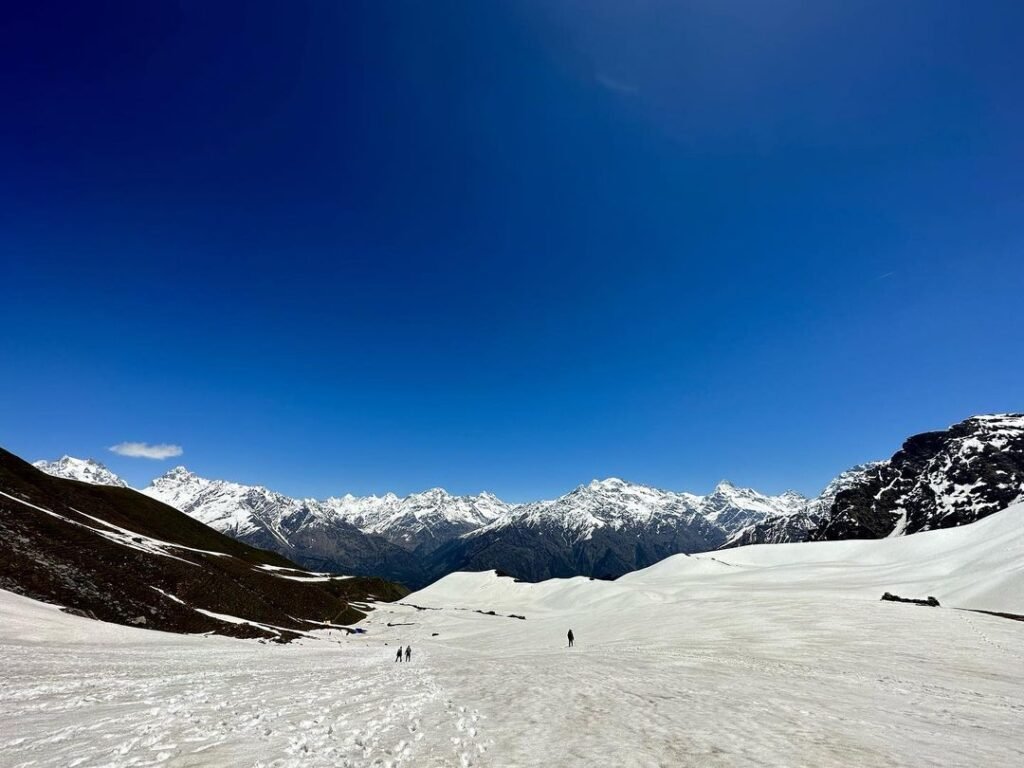
The Sar Pass Trek is a popular Himalayan trek in the Parvati Valley of Himachal Pradesh, India. The distance of the trek is approximately 48 kilometres; this trek offers a thrilling and picturesque adventure for nature lovers and adventure enthusiasts.
The trek begins from the quaint village of Kasol, known for its scenic beauty and serene atmosphere. Trekkers from Kasol traverse through dense pine forests, crossing gushing streams and charming meadows. The trail gradually ascends, leading trekkers to higher altitudes.
One of the highlights of the trek is the crossing of the Sar Pass itself, situated at an altitude of about 4,220 meters. This challenging section requires traversing steep slopes and snow-covered terrain, offering trekkers a sense of accomplishment upon reaching the pass.
The journey also includes mesmerizing views of snow-capped Himalayan peaks, including Sar Pass, Tosh Glacier, and Parvati Valley. Trekkers are treated to breathtaking panoramic vistas throughout the trek, creating unforgettable memories.
Depending on the chosen itinerary, the trek usually takes 5-6 days to complete. Campsites along the route provide a tranquil setting for trekkers to rest, enjoy bonfires, and soak in the beauty of the surroundings.
With its stunning landscapes, thrilling challenges, and a glimpse into the local culture, the trek is a remarkable adventure that allows trekkers to immerse themselves in the natural beauty of the Himalayas.
- Max Altitude: 13,800 Ft.
- Average Trekking Fees: INR 7000 – INR 12,000 + GST (Per Person)
- Distance: 48 – 50 kms
- Difficulty: Moderate
- Duration: 5-6 days
- Ideal For: Experienced Trekkers
- Best Season: April – June
- Region: Himachal Pradesh
Additional Information of the Sar Pass Trek
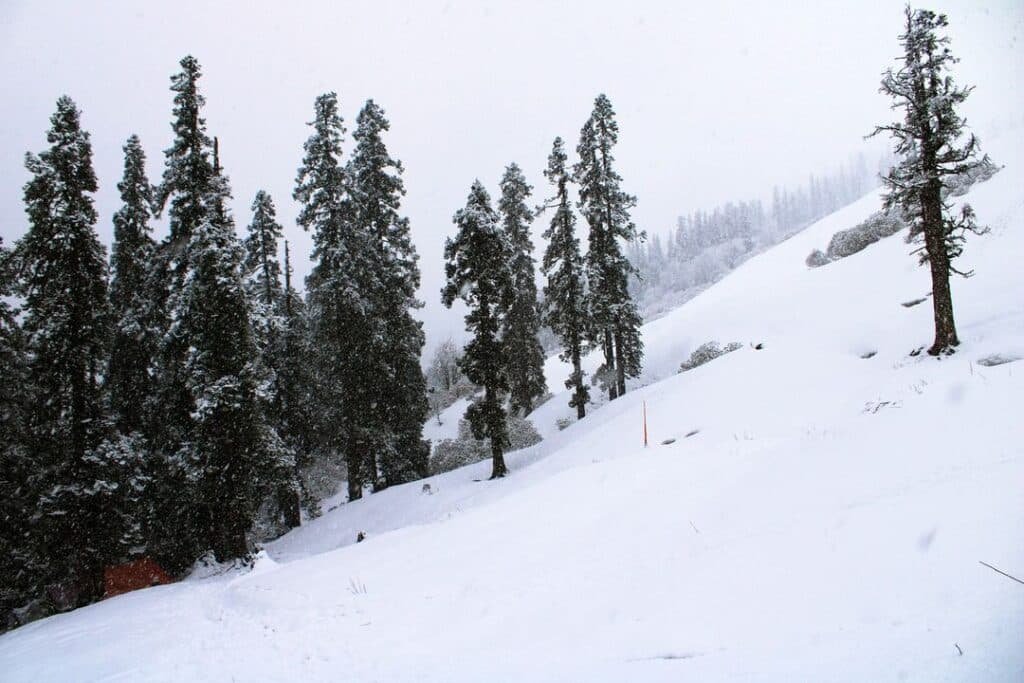
Trek Distance
The Sar Pass Trek covers a total distance of approximately 48 kilometres (30 miles) . It is usually completed over 5-6 days, depending on the pace and acclimatization of the trekkers. Each day’s distance varies, ranging from 6 to 12 kilometres (4 to 7.5 miles) , offering a perfect balance of trekking challenges and exploration.
Best Time to Do Sar Pass Trek
The best time to embark on the trek is from May to June and September to October . During these months, the weather conditions are relatively stable, with clear skies and comfortable temperatures. The summer months of May and June provide pleasant trekking conditions with moderate temperatures, while September and October offer the enchanting beauty of autumn colours.
Difficulty Level
The trek is rated as a moderate trek in terms of difficulty . It presents a reasonable challenge to trekkers, requiring good physical fitness and stamina. The trail involves steep ascents and descents, traversing through snow patches and rocky terrains. Prior trekking experience is not mandatory, but it is recommended to have basic fitness and endurance training before attempting this trek.
Acclimatization and Fitness Preparation
Acclimatization is crucial while trekking in high-altitude regions to prevent altitude sickness. Before starting the trek, spending a day in Kasol or nearby villages is recommended to acclimatize to the elevation. Engaging in light activities and staying hydrated during this period will help your body adjust to the changing altitude.
Preparing physically for the trek is advisable by engaging in regular exercises such as jogging, cycling, or swimming. Building stamina through cardio workouts and leg-strengthening exercises will greatly enhance your trekking experience.
Costing & Budget for the Sar Pass Trek
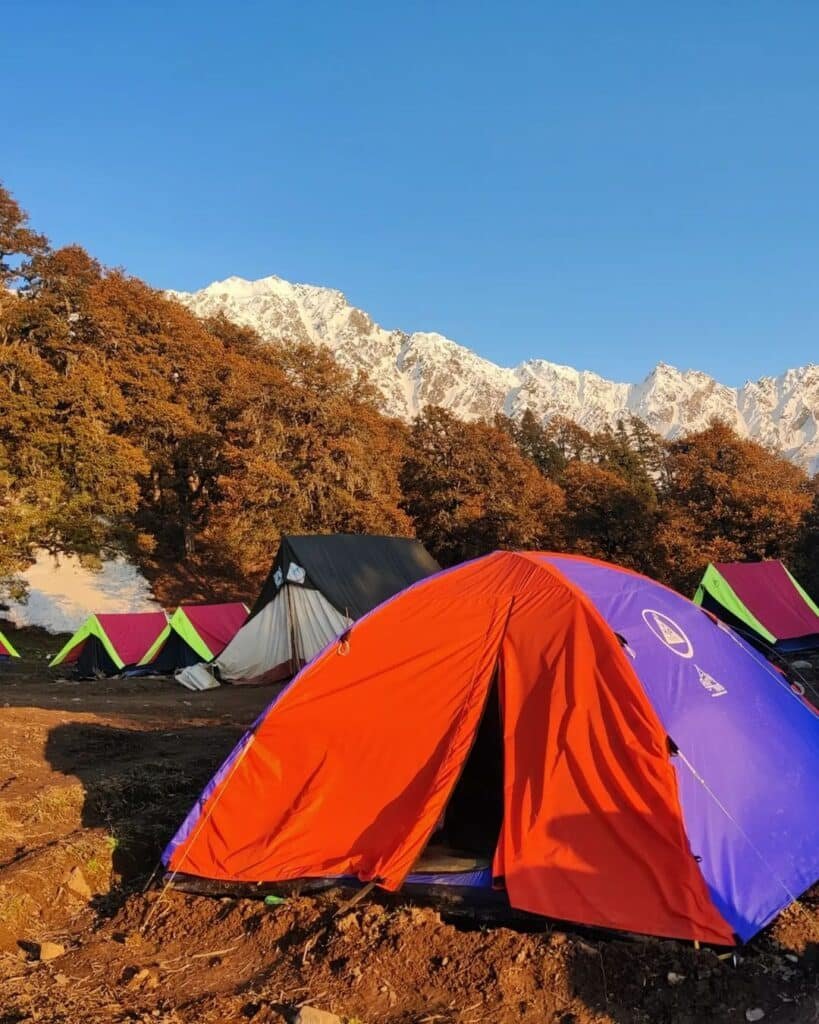
When planning for the trek, it is important to consider the cost and budgeting aspects to ensure a smooth and enjoyable experience. Here are some key factors to keep in mind:
Trekking Packages: Various trekking agencies and tour operators offer packages for the trek. These packages typically include transportation, accommodation, meals, trekking permits, and a guide. The cost of these packages can vary depending on the inclusions, duration of the trek, and the operator’s reputation. It is advisable to compare prices and read reviews before choosing a package.
Average Trekking Fees Charged By Organisations: INR 7000 – INR 12000.
Travel Expenses: Apart from the trekking package, you must consider travel expenses to reach the base camp. Kasol is usually the starting point for the trek, and you may need to budget for transportation from your place of origin to Kasol. This can include bus or taxi fares.
Equipment and Gear: Ensure you have appropriate trekking gear, such as sturdy hiking boots, warm clothing, a backpack, a sleeping bag, trekking poles, and other essentials. If you don’t already own these items, factor in the cost of purchasing or renting them.
Food and Water: Most trekking packages include meals during the trek, but carrying some extra snacks and energy bars is a good idea. Additionally, budget for bottled water or water purification tablets to ensure a safe drinking supply.
Miscellaneous Expenses: It’s advisable to set aside a small amount for unexpected expenses or emergencies during the trek, such as additional meals, medical supplies, or extra days if the weather conditions pose challenges.
In conclusion, the total cost of the trek depends on various factors, including the trekking package, travel expenses, equipment, food, and miscellaneous expenses. Planning ahead, researching prices, and allocating a reasonable budget for a comfortable and memorable trekking experience are recommended.
How to Reach Kasol?

The starting point of the trek is typically in the village of Kasol, which is well-connected to major cities in India. Here are the common modes of transportation to reach Kasol:
By Air : The nearest airport to Kasol is Bhuntar Airport, approximately 31 kilometres away. Regular flights operate from major cities like Delhi and Chandigarh to Bhuntar. You can hire a taxi or take a bus from the airport to reach Kasol.
By Road: Kasol is well-connected and can be reached by bus or private taxi. Regular buses operate from Delhi, Chandigarh, and other major cities to Bhuntar or Manali. You can take a local bus or hire a taxi to reach Kasol. The road journey offers scenic views of the mountains and valleys.
By Train : The nearest railway station to Kasol is Joginder Nagar Railway Station, approximately 144 kilometres away. However, it is a narrow-gauge railway station, and not all trains connect directly to Joginder Nagar. An alternative option is to take a train to Chandigarh or Pathankot and then continue the journey by road via bus or taxi.
Once you reach Kasol, you can start the trek from there. Reaching Kasol a day before the trek is advisable to rest and acclimate to the altitude. You can find local transport options like shared cabs or hire a local guide to reach the exact starting point of the trek within Kasol.
Detailed Itinerary of Sar Pass Trek
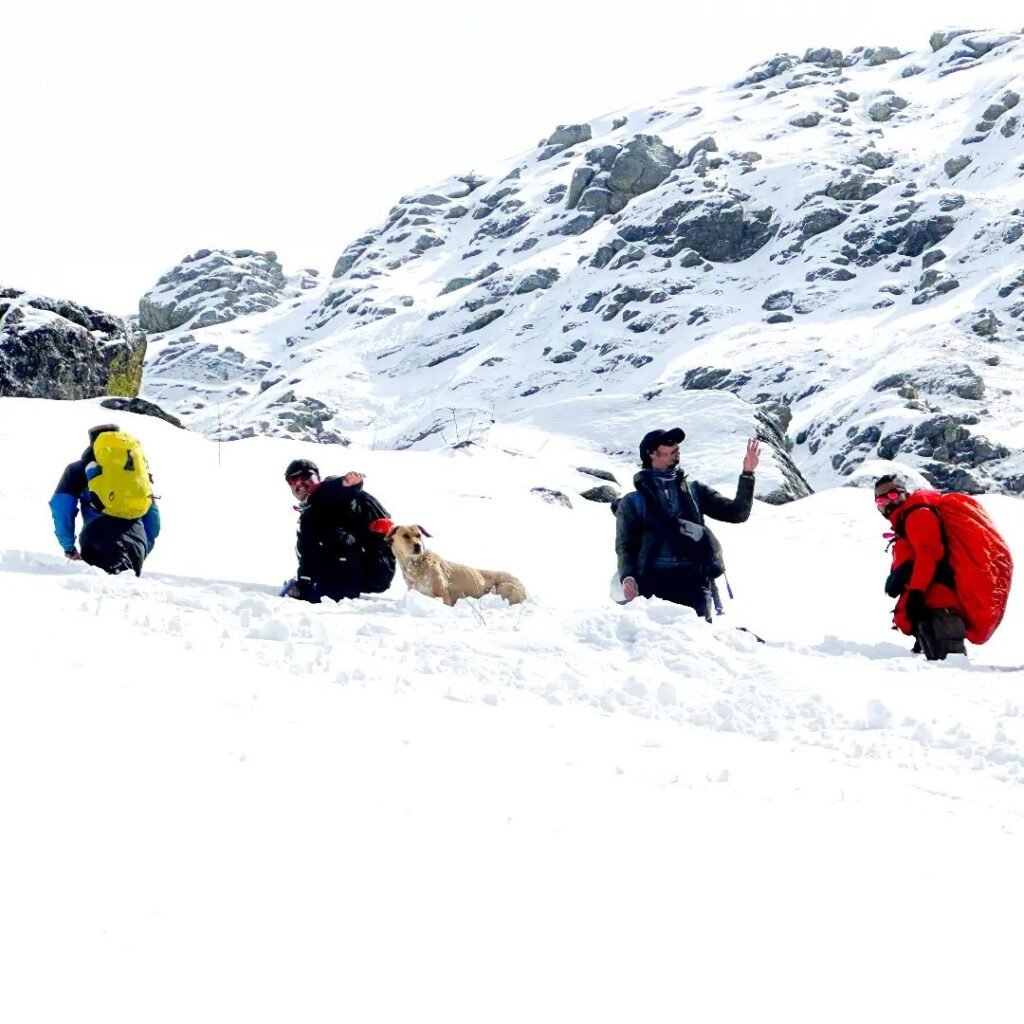
Here is a day-by-day breakdown of the trek itinerary:
Day 1: Arrival in Kasol
- Arrive in Kasol, a picturesque village nestled in the Parvati Valley.
- Explore the local markets and immerse yourself in the serene surroundings.
- Attend a briefing session by the trek leaders and get acquainted with fellow trekkers.
Day 2: Trek from Kasol to Grahan Village
- Start from Kasol, crossing the Parvati River and ascending through dense forests.
- Reach Grahan Village, a quaint Himalayan village known for its traditional architecture.
- Camp overnight in Grahan Village, surrounded by towering mountains and starry skies.
Day 3: Trek from Grahan Village to Min Thach
- Begin the day’s trek, passing through scenic meadows and blooming rhododendron forests.
- Ascend towards Min Thach, enjoying panoramic views of the valley and snow-capped peaks.
- Set up camps at Min Thach, relishing the tranquillity of the pristine surroundings.
Day 4: Trek from Min Thach to Nagaru
- Embark on a steep ascent from Min Thach to Nagaru, reaching an altitude of approximately 3,700 meters (12,100 feet).
- Experience the thrill of crossing snow patches and witnessing the mesmerizing landscape unfold.
- Camp overnight at Nagaru, with the starlit sky above and the grandeur of the mountains surrounding you.
Day 5: Summit Day – Trek from Nagaru to Biskeri Thach via Sar Pass
- Start early for the challenging trek to Sar Pass, about 4,220 meters (13,845 feet).
- Traverse through snowfields and conquer the past, experiencing a sense of accomplishment and awe-inspiring views.
- Descend towards Biskeri Thach, where you will camp amidst picturesque meadows and stunning vistas.
Day 6: Trek from Biskeri Thach to Barshaini and Return to Kasol
- Descend from Biskeri Thach through thick forests and charming trails.
- Reach Barshaini, where the trek concludes.
- Board a vehicle from Barshaini to Kasol and celebrate the successful completion of your trek.
Please Note: This is a general itinerary, followed by most of the trekking groups in India. However, there might be slight differences in the itinerary depending on the trekking group you opt to go with.
Highlights of the Sar Pass Trek

The trek offers a multitude of breathtaking highlights that make it a must-visit destination for adventure enthusiasts. Here are some of the key highlights of the trek:
- Majestic Mountain Views: Trekkers are treated to awe-inspiring views of the mighty Himalayan peaks throughout the trek. The panoramic vistas of snow capped mountains, including Sar Pass, Tosh Glacier, and Parvati Valley, create a stunning backdrop and leave trekkers spellbound.
- Dense Pine Forests: The trek takes you through dense pine forests that exude a tranquil atmosphere. Walking amidst the towering pine trees provides a refreshing experience and a respite from bustling city life.
- Picturesque Campsites: The trek presents picturesque campsites nestled amidst nature’s bounty. These campsites, situated near gurgling streams and lush meadows, provide a perfect setting for trekkers to unwind, enjoy bonfires, and soak in the peaceful ambience of the surroundings.
- Challenging Pass Crossing: Crossing the Sar Pass is a trek highlight. With an elevation of around 4,220 meters, it offers a thrilling adventure as trekkers navigate steep slopes and snow-covered trails. The sense of achievement upon reaching the pass is unparalleled.
- Frozen Lake and Snowfields: During certain months, trekkers can witness a frozen lake and traverse snowfields along the trek. The pristine beauty of the frozen lake and the glistening white snowfields create a surreal experience, adding to the charm of the trek.
- Local Culture and Hospitality: Interacting with the friendly locals along the trek route provides a glimpse into the unique culture and lifestyle of the region. Trekkers can engage with the warm-hearted villagers, savour local cuisine, and learn about the traditions and customs of the area.
Overall, the Sar Pass Trek offers a perfect blend of natural beauty, adventure, and cultural experiences, making it a memorable journey for trekkers seeking to explore the enchanting landscapes of the Himalayas.
Safety Tips & Precautions
While embarking on any trek, safety should always be a top priority. Here are some essential safety tips to keep in mind during the Sar Pass Trek:
- Trek with an experienced guide and follow their instructions.
- Stay hydrated and carry an adequate supply of water.
- Pack light and carry only the essential items.
- Dress in layers to adapt to changing weather conditions.
- Respect the environment and maintain cleanliness.
- Inform someone about your trekking plans and expected return.
- Stay updated about weather conditions and local regulations.
- Avoid alcohol and smoking during the trek.
Unlock the Adventure: Subscribe Now for Exclusive Deals, Insider Tips, and Epic Trekking Guides Delivered to Your Inbox!
Essential Gear and Equipment for Sar Pass Trek
Before embarking on the trek, it is essential to pack the right gear and equipment to ensure a safe and comfortable journey. Here is a list of items you should consider carrying:
- Good quality Trekking shoes with good ankle support
- Backpack with rain cover
- Trekking gaiters
- Warm and waterproof clothing layers
- Sleeping bag suitable for sub-zero temperatures
- Trekking poles for better stability on uneven terrains
- UV-protected sunglasses and sunscreen
- Water bottles and water purification tablets
- Headlamp or flashlight with extra batteries
- First aid kit with essential medications
- Portable power bank for charging electronic devices
The Sar Pass Trek is a thrilling adventure that takes you through the pristine beauty of the Himalayas. With its easy to moderate difficulty level, mesmerizing landscapes, and the joy of conquering Sar Pass, this trek offers an experience of a lifetime. So, pack your bags, prepare yourself physically, and get ready to embark on this unforgettable journey in the lap of nature.
The Sar Pass trek is moderately difficult and suitable for experienced trekkers due to steep ascents, rocky terrain, and changing weather conditions.
Sar Pass trek is in the Parvati Valley of Himachal Pradesh, India and the start point of the trek is Kasol.
The trek from Kasol to Sar Pass covers a distance of approximately 48 kilometres.
There can be snow on the Sar Pass trek in June, particularly at higher altitudes. It is advisable to be prepared for snowy conditions and carry appropriate gear.
Kuari Pass , Bhrigu Lake , Brahmatal Trek , Shrikhand Mahadev Trek , Buran Ghati Trek , Bali Pass Trek , Kareri Lake Trek , Rupin Pass , Tarsar Marsar Trek
- trekking guides
- No comments yet.
Add a comment
Leave a reply · cancel reply.
Your email address will not be published. Required fields are marked *
This site uses Akismet to reduce spam. Learn how your comment data is processed .
- Share via...
My SAR PASS Trek with YHAI

I really wanted to push myself from my comfort zone & go for a real trek not a 1 or 2 days short trek but a real one & I am going solo that's also my first solo trip, I choose YHAI sar pass trek & This trek changed me, I found so much about myself. John Muir says it correct that "The mountains are calling and I must go."
I hop on HRTC bus that leave at 5:30 from kashmere gate in evening & reach kasol by 9:00 in the morning but there are so many buses from Delhi that goes till bhunter. so I reached at my base camp in the morning located in the amazing location and as you enter there is big area that is dinning area under the tent roof where we get morning breakfast, lunch, evening snacks & dinner then there is huge empty area in the middle of all tents where everyone can play, today is a free day for us & had already been to kasol so I decide to stay in camp & take rest.
Next day we woke up early in the morning & go for exercise though that was tough for me as I don't do any workout but the view on our way of jog is making me do it, well after exercise we all back to our camps, grab breakfast & then we have to stood in line & clap for the group who are leaving for trek, after that we will leave for our mini trek trail so that we all be prepared for what's coming next. There after reaching up we do introductions, make some protein drink & share it with everyone, prepare for our night in camp which is a ritual of YHAI. I am already loving the vibes here it's like I am in school again, we all get back to camps & our group did great, some people dance, some sing, some do poetry they are all fun & I am not feeling like I came solo.
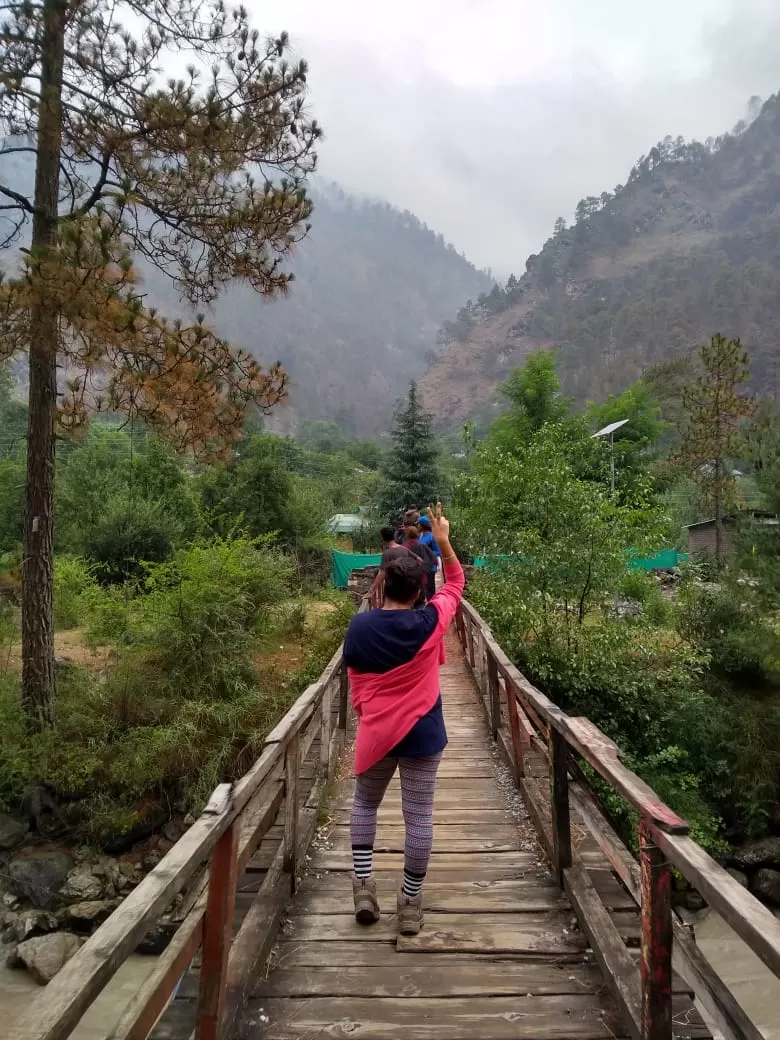
Well this is our second day of training, we go to another mini trail to prepare for our trek & after that everyone goes to market to arrange everything for trek , well I choose to play some sport here in camp and give my body a proper rest before we leave for our adventure.
ON OUR WAY TO MINI TREK TRAIL
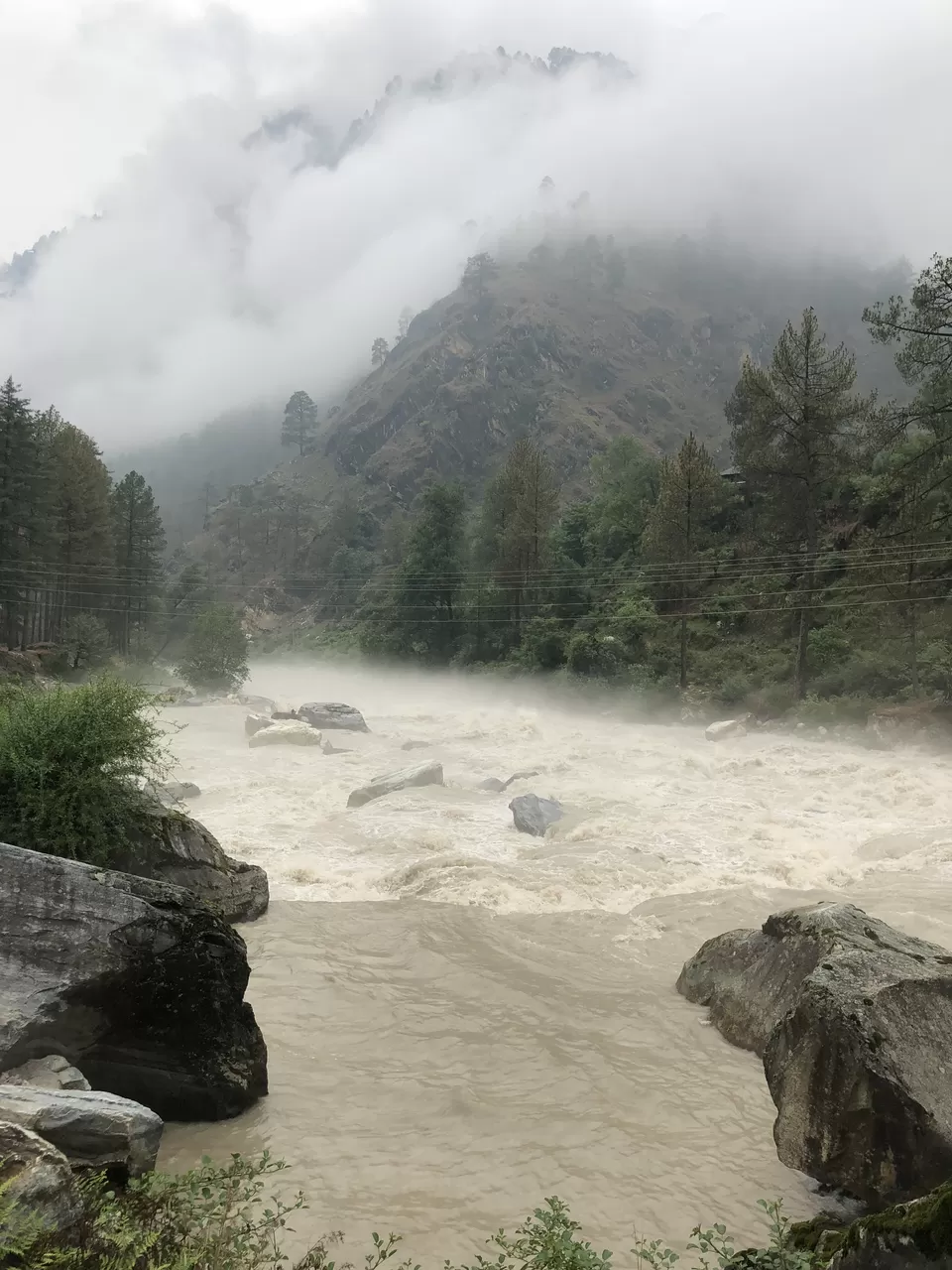
This is our day now, people are going to clap for us, we are leaving for our trek the new adventure is waiting for us. I am so happy that we are leaving the base camp today we have to trek 9kms & have to reach our first destination GRAHAN. Actually I am a little worried that how am I gonna trek as I don't do any workout it's going to be so difficult for me but the guides there they give you so much rest in between, you can enjoy your trek fully, I enjoyed watching birds there and the way to grahan is beautiful we all are getting close, sharing our foods & waters, helping each others we reached GRAHAN in 5hours & I am not tired, I am enjoying every bit of it the camp of grahan is so beautiful the paddy fields, the sunshine is all so beautiful I have never experienced anything like that & on our way to grahan I am actually become the centre of attraction, the funniest girl in our group and I didn't about that myself, I didn't know that I could be funny its true that if u come solo you can be anything you can discover all about yourself and I am loving that new me, I know that's sound so self love but it is I fell in love with myself. Though nothing good came single handy something bad also come along with it and there my worst nightmare insects inside our camps and we have to share our camp with them, when I say about leaving my comfort zone I am not sure I am talking about this and with my fear of insects & flies I became "MAKHI MAA" of our group.
New day and we have to move to our next destination, PADRI a 5kms trek from GRAHAN but a much difficult one and rain happens to make it more difficult we all are wet, our shoes are wet and worst our bags are wet, and so all the clothes inside it, but nothing can stop us to reach PADRI and conquer our only aim to make it to the top of SAR PASS, we move and stop and move,enjoying the flora & fauna, the birds and finally reach PADRI in 5hours and we still have so much time till the sun sets so we talked & enjoyed the view of waterfall. everyone from different places talking about their life's in cities it's all so different, so new to me, aha there I did something stupid, fun we collect the bones that are lying at some distance from our camp, we decided to join the bones & make a cow dragon and make it join the army of dead GAME OF THRONES people you understand what I am talking, though I failed but I am sure next group of YHAI will make it join army of dead. the sun sets so we have to be back at our camp, eat our dinner and STARGAZING is waiting for us, it was immensely beautiful, that was the first time I saw something like that, as living in Delhi, we are unaware from the beauty of sky.
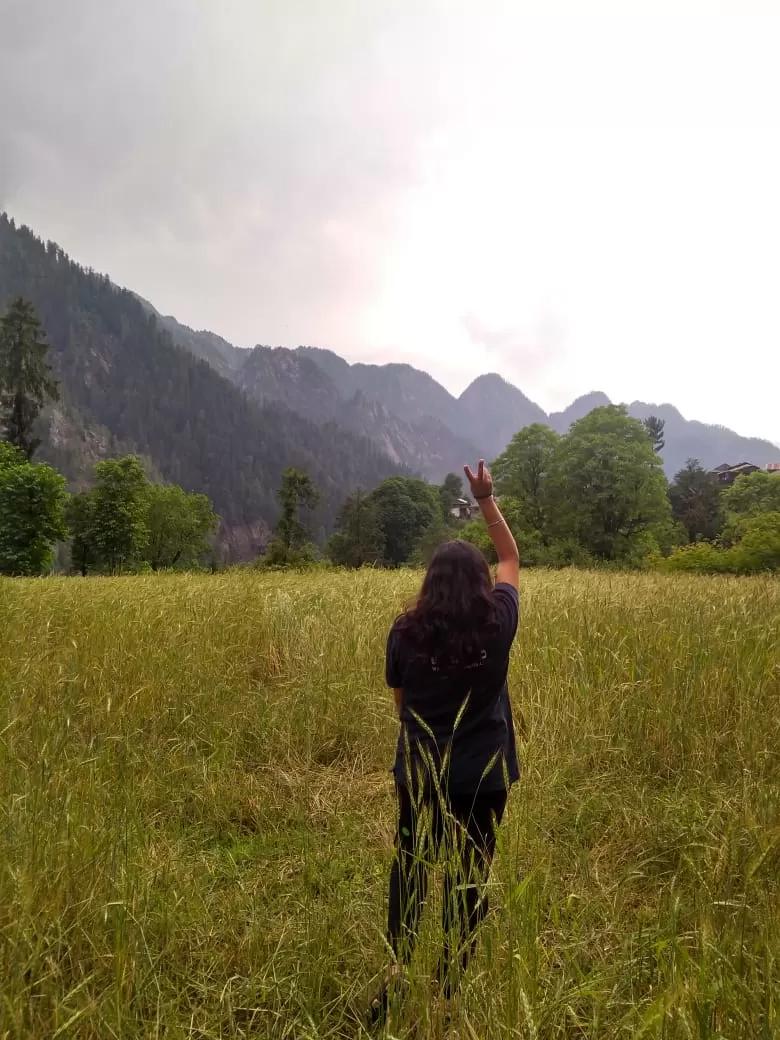
OUR FAIL ATTEMPT TO MAKE COW DRAGON
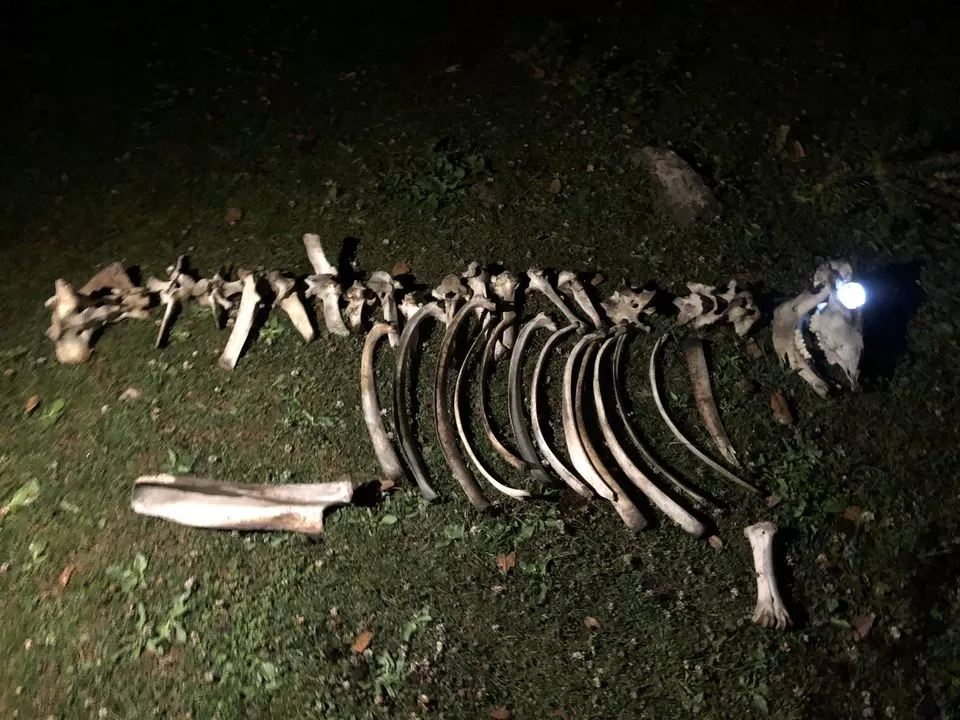
LOOKING AT WATERFALL
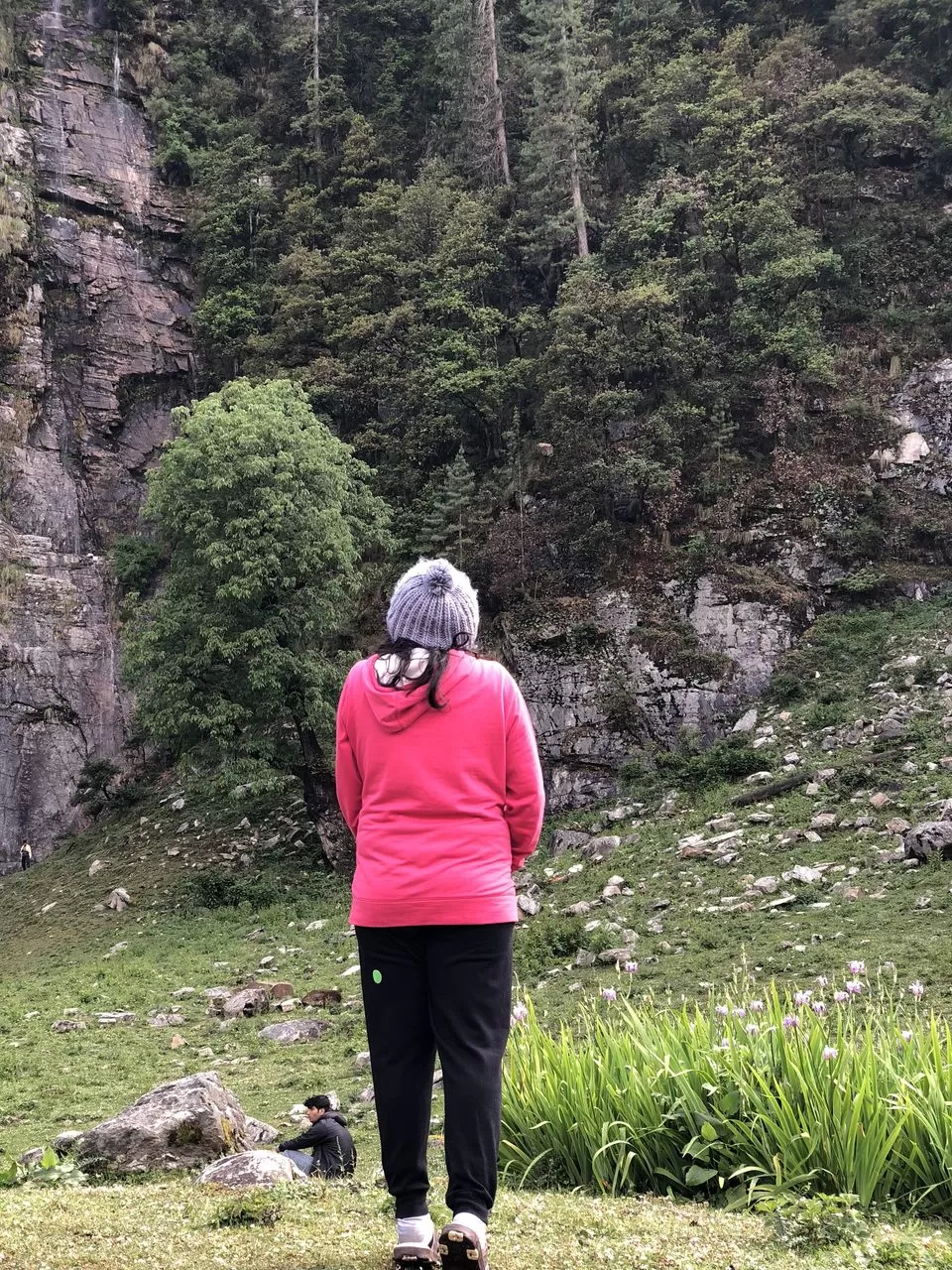
It's time to leave that beautiful camp & move towards next camp which is MINGTACH at height of 11,600ft, that day was the most challenging for all of us its raining continuously and I am feeling feverish too and the distance we have to cover today is also more than rest of our days, everyone is tired, the path is slippery because of the rain and its quiet difficult to walk on that but we all manage & reach our camp, I am having fever others are exhausted & It's raining so everyone stayed in their camps only.
I am feeling good today also we have to reach our last top camp NAGARU, I really can't explain you how beautiful it was the distance is also not much, it was easy trek to NAGARU but the way from MINGTACH to NAGARU is the most beautiful of the whole trek as soon as we reached there everyone sit outside of the camp clicking pictures, enjoying the nature. I ll show you the pictures but this don't do any justice to the beauty of NAGARU camp.
OUR MINGTACH CAMP
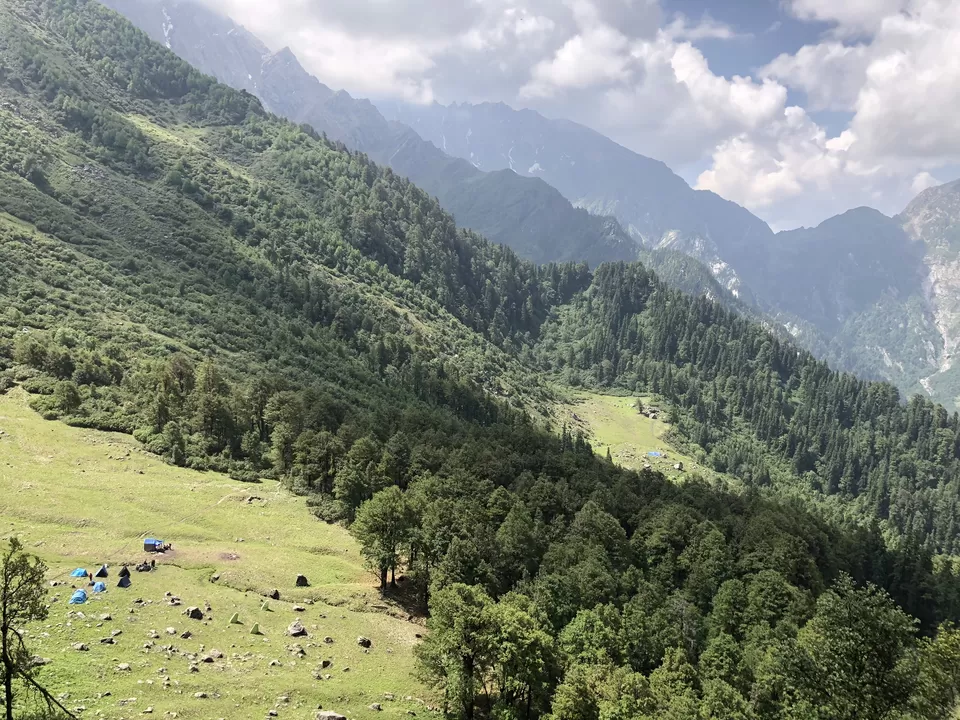
WAY TO NAGARU
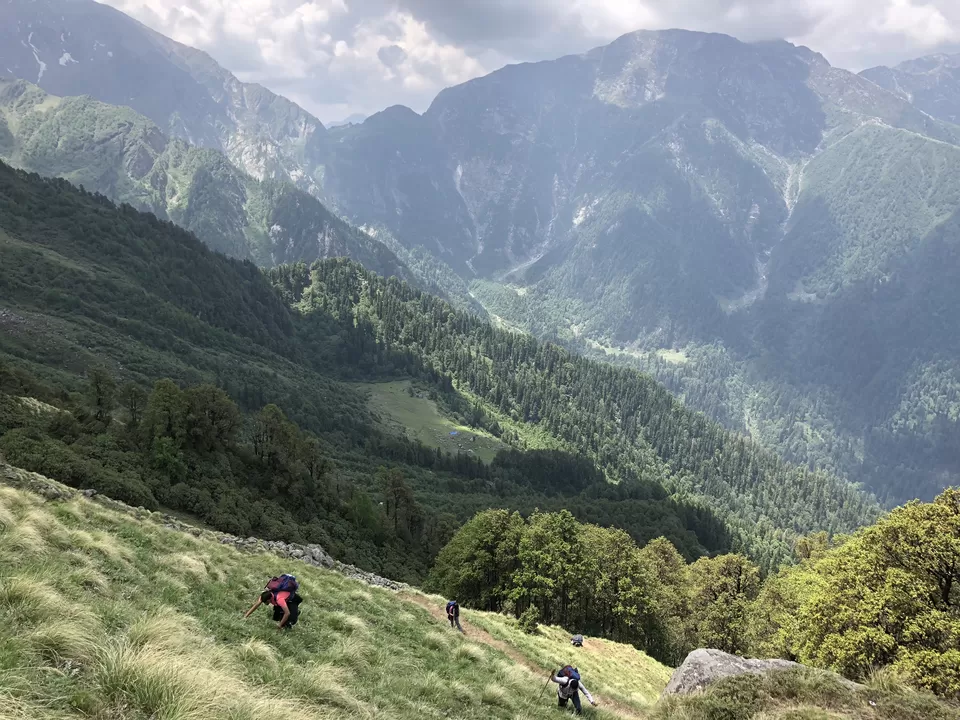
ITS THE RAIN
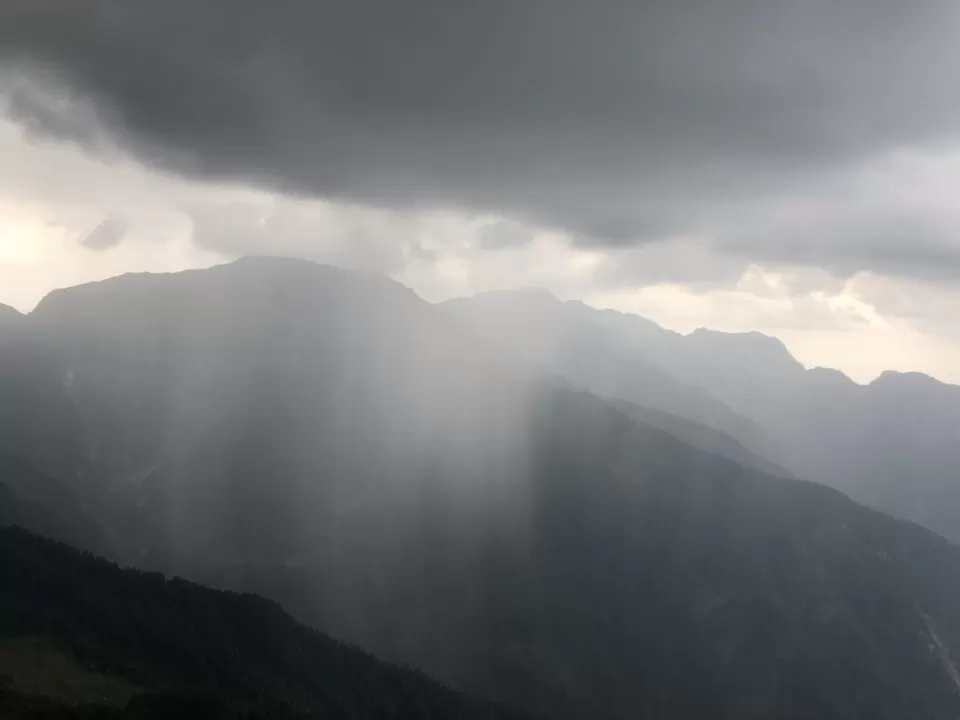
NAGARU CAMP
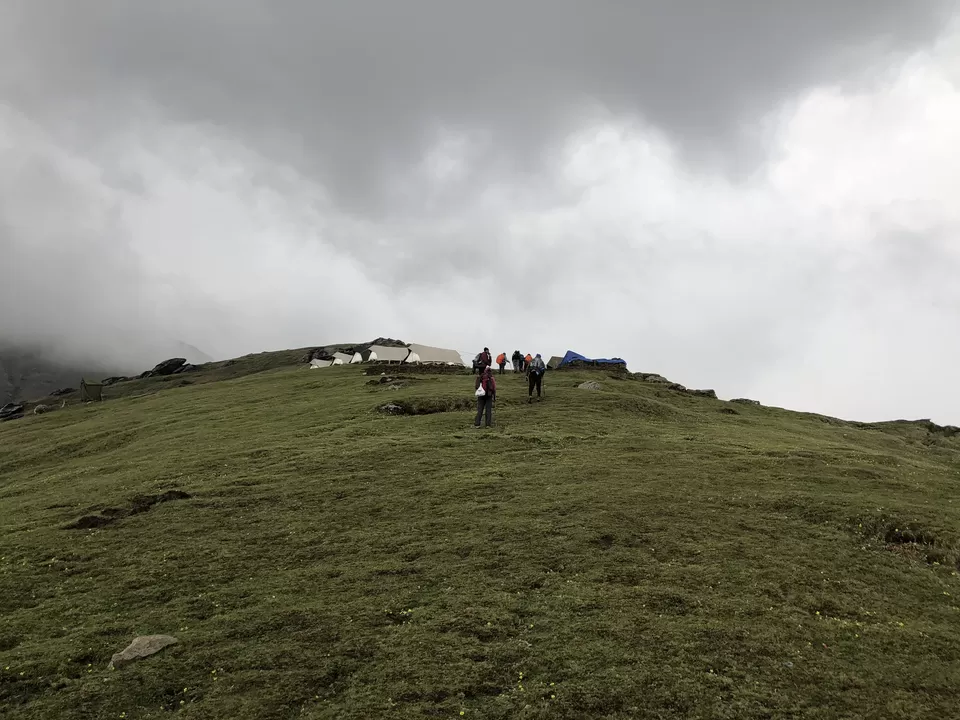
We woke up at 3:30 in the morning had our breakfast & packed our lunches, We are RANGERS & We are ready to conquer our final destination, to reach SARPASS finally we start walking at 5:00 & I have no idea when we reach sarpass but as soon we reach we are mesmerised by the view, the feeling of reaching at the top is something i had never imagined i guess that's why people come to mountains. after fulfilling our souls with the view we start moving downwards & to our next camp BISKERITATCH no one is not walking they are dancing, jumping with the happiness & excitement of successfully reaching sarpass we walked on snow do the short slide in snow & reached BISKERITATCH. I saw rainbow there and talked to the camp officer he was an ex- army officer & he gave me the idea of BUSY SUITCASES that's my page on instagram that's how sarpass changed my life.
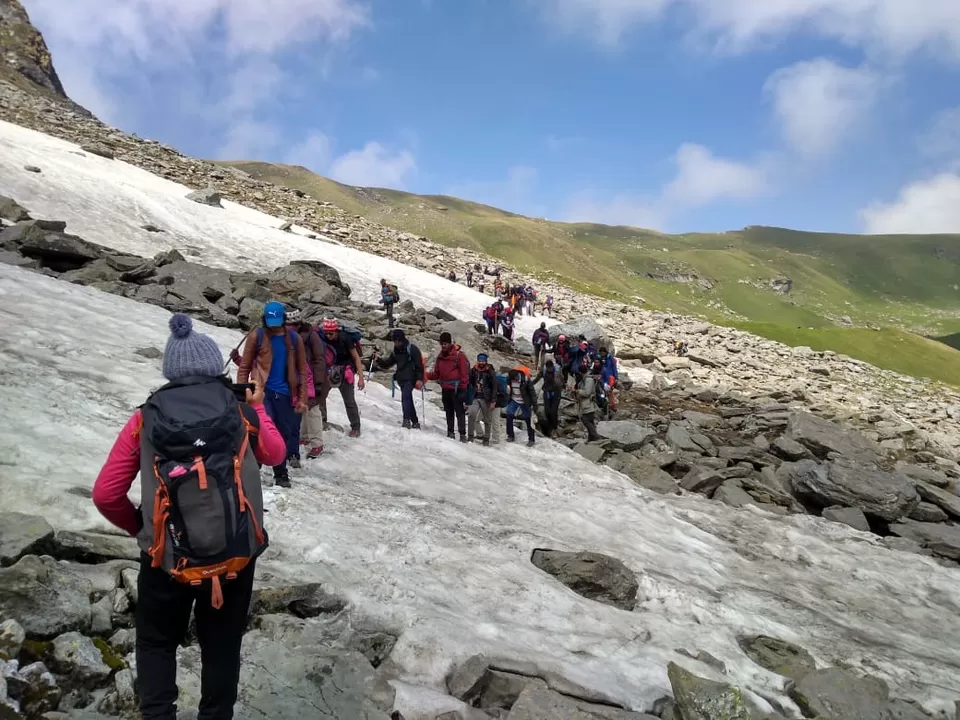
MEET MY FAMILY, AT TOP OF SARPASS
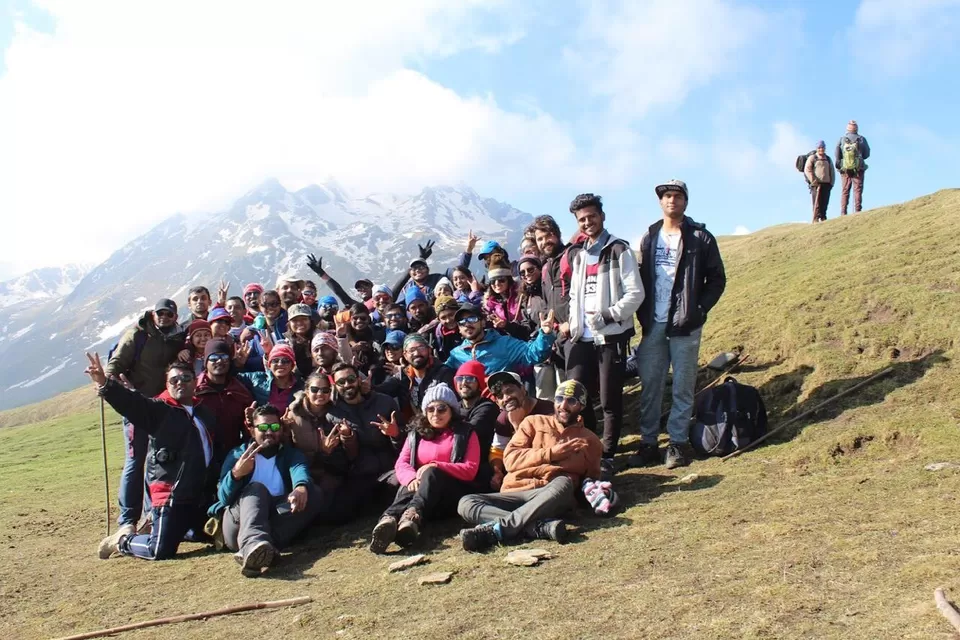
ON OUR WAY TO BISKERITATCH
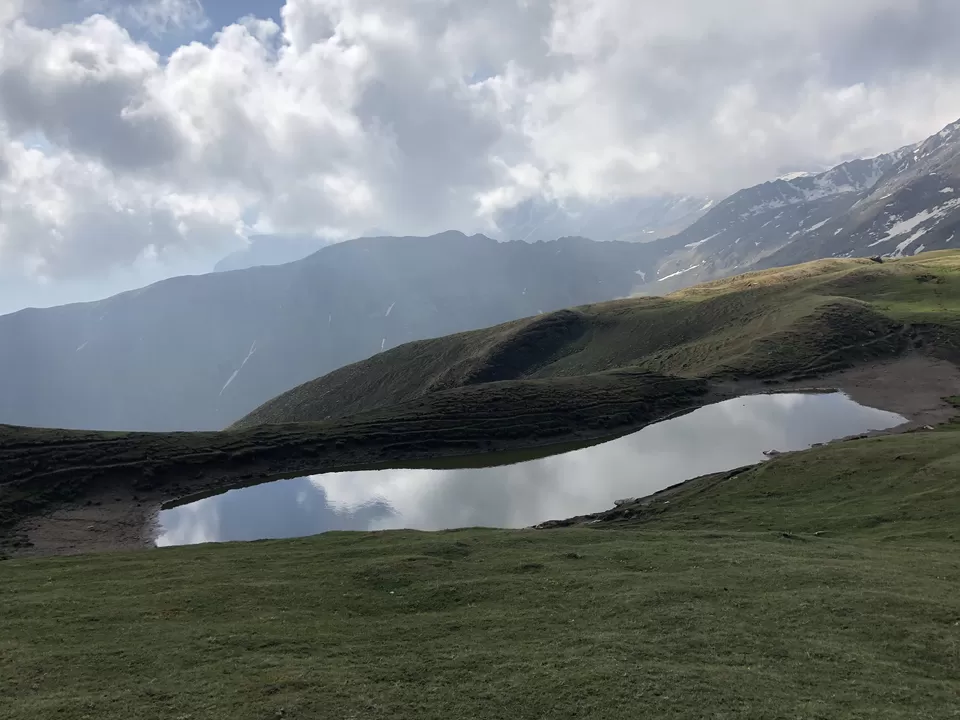
RESTING ON OUR WAY TO BISKERITATCH
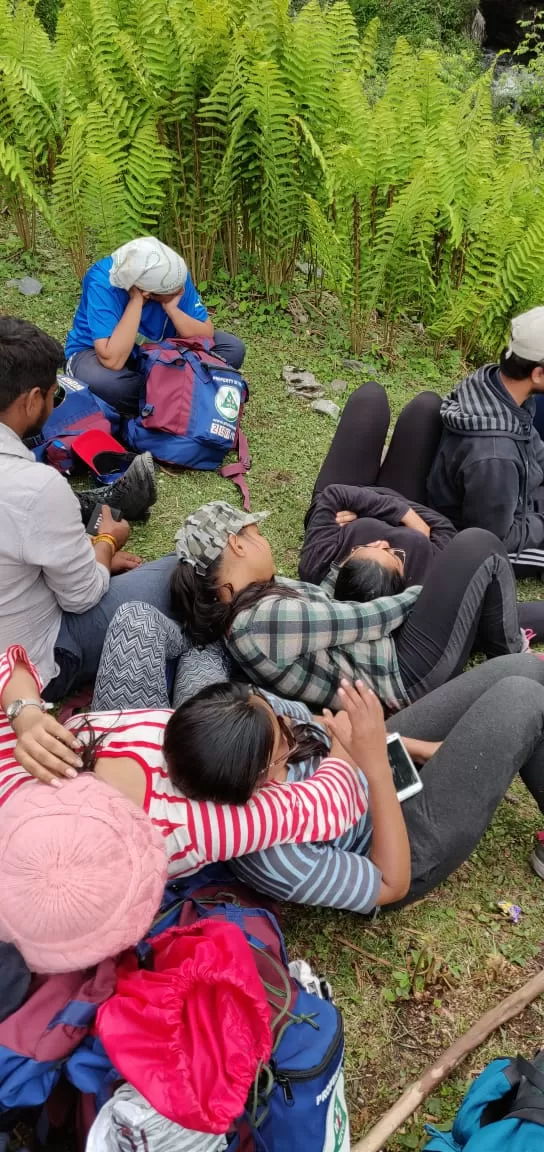
RAINING OUTSIDE BISKERITATCH CAMP
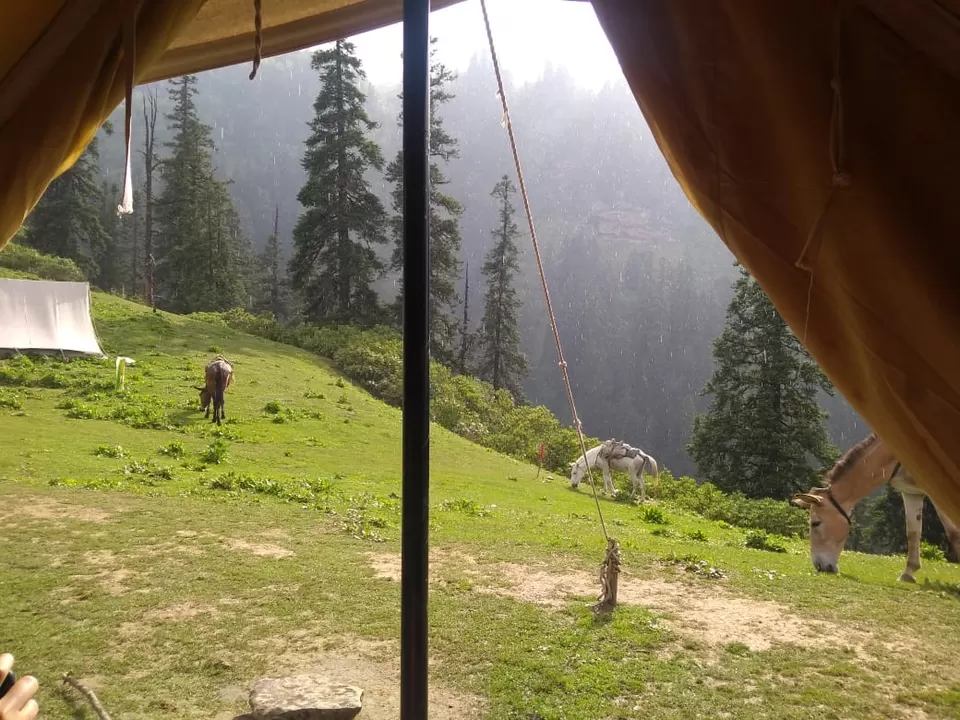
Today we have to move towards our last camp of the trek BHANDAKTATCH, we packed our lunch & start our trek the trek from biskeri to bhandaktatch is 90% in dense forest which we never done before, every trek from one camp to another is different from another trek, every camp is beautiful from the last camp that's the beauty of camps of YHAI that you don't have to worry about your food or anything else they got you covered the only thing I don't like is the washrooms though washrooms are more of pits, camps were in height so they can't arrange washrooms there but you have to carry a bucket of water from distance & that's the problem in cold at least for me. We all reached our last camp spend the last night with each other talking, dancing, singing with a bonfire.
Last day of our trek today we reach kasol at our base camp & got certificate of our trek and I had to leave that day only but my soul stays there only, we all exchange GOODBYE & HUGS & promise each other to keep in touch.
I left with so many friends from all over INDIA.
Trek Updates
- +91 9634923602
- +91 7895770439
- [email protected]

The Searching Souls – चल एक सफर पे
Sar Pass Trek
Tour dates & itinerary adventure starts now, send enquiry & get itinerary on whats app, sar pass trek.
- Early Bird Offer 20% off
- Kasol to Kasol all inclusive
- Book Now at Just ₹ 2000
- Easy rescheduling 15 days prior to trek date
- Highest Rated Trekking Company in India
- First Company to Introduce Jumbo Bag (Includes all Trekking Gear)
- Certified by Startup India, Uttarakhand Tourism, MSME and STU
- Top 10 Most Promising Adventure Travel Company in India
Trek Duration
Trek Distance
Difficulty Level
Best Season
₹ 7500 ₹ 5999
- Kasol to Kasol
Call our Sar Pass Trek Expert Ms. Swati to know more about the trek
- Jumbo Bag at ₹ 2500/person for entire Trek (Click here to know more)
- One Night Stay with Meals at Kasol in ₹ 1000/person
- All Meals (Veg only) included from Day 1 Lunch to Day 5 Breakfast
- Tents(Triple/Double Sharing), Sleeping Bags, Sleeping Matts
- Experienced and Qualified Guides
- Friendly and supportive staff
- Forest permits
- Medical Amenities –Medical Tents, Oximeter, Oxygen Cylinder, Stretcher, First Aid Kit
- Sanitised and Hygienic Camp sites
- Anything not mentioned in inclusion list
- Meals during Transportation
- Any kind of personal Expenses
- Unscheduled or extended stay due to road blocks, Landslides, heavy snowfall
- Porter/mule charges (Personal), Back pack offloading Charges
- Cost of Evacuation in case of emergency
- April: Everyday Departure
- May: Every Day Departure
- June: Everyday departure till 5 June 2024
- Call our Trek Expert at 8006074398/9634923602 to plan your trek
- Group Customisation also Available
- Extra Stay in Kasol available at ₹ 1000/person (Triple Sharing)
- Back Pack offloading ₹ 4500/bag for the whole trek
SUMMARY SAR PASS
Pay online to book sar pass trek now, 150+ 5 star google reviews for sar pass trek.
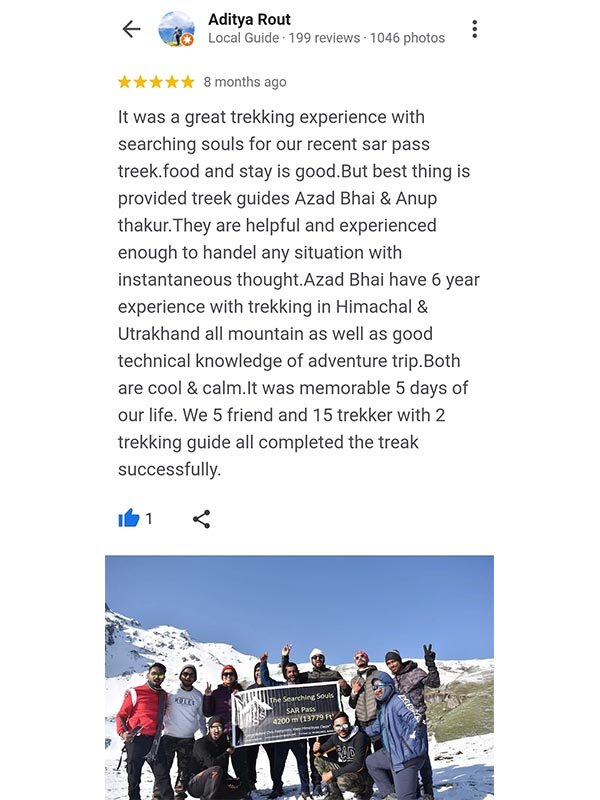
How We Make Treks Comfortable and Safe for you?
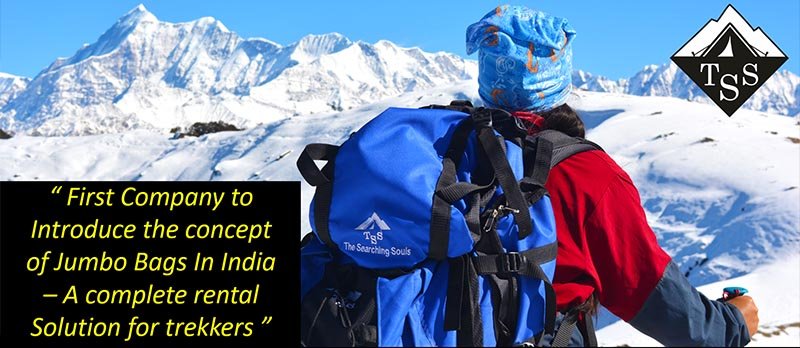
SAR Pass Trek Overview & Itinerary
Sar pass trek is one of the most popular treks in India done in the summer season (April to June). It is one of the few treks where trekkers can easily find snow during these months. The trek starts from Kasol, which is a is a hamlet in the Kullu district of the Indian state of Himachal Pradesh.
Perched at 13,800 ft. above sea level, Sar Pass trek offers the magnificence of a beautiful verdant landscape and is a heaven for photographers, artists, and nature lovers. Set against a curtain of majestic Himalayan peaks wrapped in snow, the Sar Pass trek passes through some of the most scenic views ranging from forests to the meadows to the ice blankets.
The trek has everything to offer starting from trekking through forests of pine and groves of rhododendrons, to camping in the high-altitude Grahan Village. This is the best getaway from the scorching heat of the cities and to witness the winter chills in the peak summer time.
What is special about SAR Pass trekking?
- If you are looking for a snow trek in the Himalayas accessible in Summers, Sar Pass trek is for you
- It gives you a feeling of climbing a Himalayan pass without technical climbing
- Visit old and ancient Grahan Village
- One of the best treks to hike for beginners
- Beautiful and different camp sites each of the trek
- Snow laden trails even in summers
- One of the most popular summer treks of the country
- The view from the summit is mesmerizing where everything looks below your feet
SAR PASS TREK ITINERARY
- Your Sar Pass trek starts from the centre of Kasol and keeps to the true left of the Grahan Nallah.
- The trail is easy and frequently used by locals and one can effortlessly cover much distance in a couple of hours.
- After passing the Grahan Nallah the trail becomes rocky and one will be climbing uphill, away from the right bank of the river and through the Rhododendron forest.
- Rhododendron petals can be eaten whole and the syrup can be mixed with water to make a refreshing drink.
- After a steep climb of about an hour, the Grahan Village is the last village of the trek and there will be no mobile network going forward.
- Overnight stay in homestay at Grahan.
- Wake up to a beautiful view of the beautiful snow-clad mountains.
- After having a hearty breakfast, start your climb north of the camping ground of Grahan towards Mung Thach through the trail commonly used by the locals.
- After continuing your trek for a while, witness the Mung Thach, Nagaru, and Sar Top on the mountain to the right.
- Trek through the steeper path that leads into the woods with a thick cover of trees.
- As the slope becomes steeper the path too becomes challenging at some places.
- After crossing the forest arrive at your destination for the day, i.e., Mung Thach.
- One can easily see the Chandrakhani stretch and other prominent Himalayan ranges from here.
- Overnight stay at Mung Thach in a forest camp.
- Enjoy a gust of fresh cold breeze in the morning.
- You will then start the trek from Mung Thach to Nagaru that will pass through the woods.
- This is a difficult part of the trek, the slope falls steeply to the valley below and the snow may be slippery.
- After crossing steep slope for a couple of hours, reach Nagaru campsite.
- When facing north you will see magnificent mountains across the Parvati valley and the beautiful town of Manikaran.
- Overnight camp stay at Nagaru.
- Make an early start, as the climb is steep through the snow.
- Reach the top and enjoy the stunning views of Sar pass and the elevated peaks of the Tosh valley.
- Stay at the top for a bit to cherish your accomplishment and take some amazing pictures to freeze the moment in time.
- After that, you will have to slide down the Biskeri that is really exciting and completely harmless as long as some precautions are taken.
- The slide takes one as far as a kilometre to a gentler slope of the valley.
- Walk for an hour crossing a few streams to reach the valley and finally to the campsite of Biskeri Thach.
- Overnight stay at Biskeri Thach.
- Enjoy the sublime view of the pine forests, the majestic mountains, and the lush grasslands in Biskeri.
- From Biskeri, hike down across a steep plot of land with fencing all around.
- After crossing the dense forest cross a stream, with a campsite across.
- The path to the village of Pulga goes to the left of the campsite as the twin villages of Pulga and Tulga are separated by a stream.
- From Tulga, cross a bridge on the river Parvati, to reach the village of Barshaini.
- Jeep ride to Kasol base camp and your Sar Pass trekking ends.
Sar Pass Trekking Map
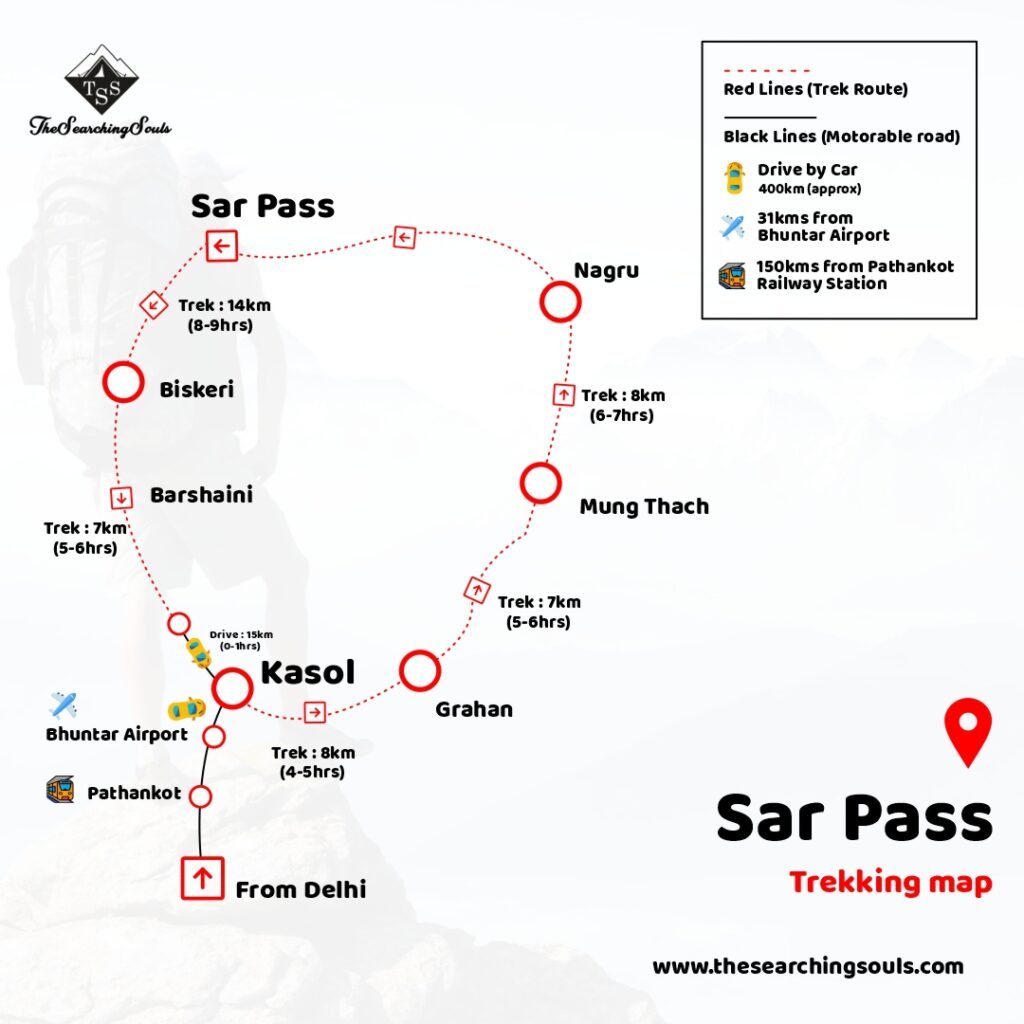
Trek Essentials
Tss jumbo bag.
- Backpack/Ruck Sack (at least 55 Litres) and a small day bag ( upto 15 litres) for summit day
- Poncho/Raincoat and Rain Cover for Ruck Sack
- 2 Quick Dry T-shirts (preferably Full Sleeves) and Track Pants
- Warm Jacket preferably a down jacket or an equivalent heavy jacket to protect from cold at night
- Comfortable Shoes with a good grip and ankle support. We recommend Quechua Forclaz 100 or similar shoe
- A pair of fleece jacket or fleece upper
- Good Thermals for insulation at night
- Lip Balm and Cold Cream
- Sun Cap or Sunscreen (SPF 30+)
- Dark Sunglasses. People who wear spectacle may use photochromatic lenses in their spects
- 2 pair of warm socks and at least 2 pair of normal cotton socks
- 1 Pair of slippers/Sandals
- Woolen Cap and Gloves for night
- Toiletries – Tooth brush, Tooth paste, Liquid soap, Hand Sanitizers, Slippers, Light Towel, Toilet Roll (Avoid wet tissues as they are not eco friendly)
- Torch or Headlamp with extra pair of batteries
- Personal Medical Kit: Crocin-Fever, Avomine-Motion Sickness, Avil 25mg – Allergies, Combiflam, Disprin-headache, Norflox TZ & Lomofen-diarrhea, digene-acidity, omez/rantadine antacid, crepe bandages, band aids, ORS, betadiene or antiseptic cream, moov spray/volini, cotton, gauze.
- Water bottle 1 L or Hydration bag 2 L
- Other personal accessories – Camera, Tripod, mobile charger, power banks(as there will be no electricity during the trek)
- Being a high altitude trek, this trek is suitable for climbers with good physical condition and stamina.
- This is a tentative itinerary which may change as per weather conditions
- We expect you to carry your rucksacks, in case if you want them to be carried by mules back pack offloading charge up to Rs. 300/bag/day is applicable
- In case of any natural calamity the company will not be able to refund the trip charges, for more details check our cancellation policy
The difficulty level of SAR Pass Trek is moderate. For regular trekkers it is under easy to moderate category. The Trek can be difficult if you are not well prepared for it.
SAR Pass Trek cost varies from Rs. 6000 to Rs. 7000 depending on the group size and the time of the year you are planning to do it. Being a very popular trek there are many companies which sell this trek online but only few companies are service providers.
April to Mid June is the best time to do SAR pass Trek.
Yes a beginner can do Sar Pass trek. If you are a beginner and planning this trek you should have three things in mind.
- Physical fitness : You don’t have to be a fitness freak to do a trek it is just that basic fitness should be maintained. You should not be obese and should not have any medical ailments.
- Mental fitness : You should come with an open mindset and be ready for the harsh conditions winters have to offer.
- Gear : Being a Monsoon trek good gear is extremely essential.
You can keep extra luggage in the base village for any particular trek. There are no cloak roo charges applicable. Its free of cost
If you are going on a trek don’t expect mobile signals. There are few spots on the trails of few treks where you might find a single tower or something but it always depends if that is enough to make a call or not.
As there are no permanent toilets on the trek, we carry toilet tents which are dry toilets so you need to carry wet tissues/tissue wipes with you.
Yes, TSS team can organize private batches for individual groups, but the cost of the trek may vary according to the number of members in your group. You can talk to our trek coordinator via whatsapp/call to get the customized group rates.
It’s a strict no. If you fall sick during the trek due to alcohol consumption TheSearchingSouls has the right to cancel your trek and send you back to base village. No expenses shall be refunded in that case and you will have to pay additional for stay at base village.
Start running/walking at least 3-4 Kms everyday.
If it’s a snow trek a good trekking shoe is mandatory. If you buy a new shoe do walk for few days so that it fits you well and doesn’t leave you with blisters while you trek. If it is a summer trek or post monsoon trek a shoe with good grip and ankle support will do.
We provide 3 Veg meals and evening Snacks. There will be no non veg served during the trek. Eggs may or may not be served depending on the trek.
We will provide sleeping bags, inner liners, sleeping mats, tents. You just need to carry your personal gear. List of personal Gear is in our website under Trek Essentials.
Himalaya Journeys Treks &Expedition prides itself on being prepared for any emergency situation. Our guides are trained in first aid and can deal with most of the basic ailments that occur during a trek. Every camp site has basic first aid and oxygen cylinders But if a serious emergency occurs, we will evacuate you to the base village and nearest hospital but the expenses of that has to be borne by the individual
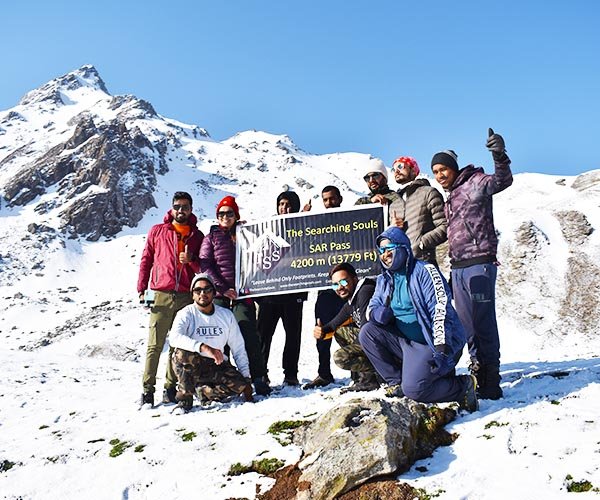
How to reach the base camp of Kasol?
Bus: To reach Kasol, there are multiple transportation options available to you. If you prefer to travel by road, the Himachal Road Transport Corporation (HRTC) operates regular buses from nearby states such as Delhi, Haryana, and Punjab. Within the state of Himachal Pradesh, the buses run between cities like Pathankot, Shimla, Kangra, Solan, and Dharamsala.
Train: In case you plan to travel by train, Pathankot serves as the nearest railhead which is approximately 150 km away from Kasol. You can choose to travel via Himsagar Express, Andaman Express, Ten Jammu Express, or Sarvodaya Express. Another option you can consider is Chandigarh, which is about 310 km away. From either of these railheads, you can hire taxis or private vehicles to reach Kasol.
Air: If you prefer air travel, the nearest airport to Kasol is Bhuntar Airport, which is almost 31 km away and located near Kullu. The airport is connected to three cities, namely Delhi, Pathankot, and Shimla. Upon arrival, you can hire local cabs or private vehicles to reach Kasol.
Do you want to explore the wilderness of forests, vast meadows, exotic villages, and snow-capped mountains? If yes, then the Sar Pass should be a no-brainer for you!
The SAR pass trek, in the stunning Parvati valley of Kullu District in Himachal Pradesh, is a beloved favorite among hikers and offers the chance to experience the breathtaking beauty of the region, including Kasol, Nagaru, Biskeri, and Manikaran.
Sar, meaning pond, is often frozen until late summer and doesn’t fit the typical image of a mountain saddle to cross. From the pass, the view opens up to the east, revealing the towering peaks of the Tosh valley, while to the south, snow blankets the land and is surrounded by snow-capped mountains, including one that appears deceptively close.
However, reaching it requires several hours of trekking and covering much distance to the next camp. SAR trek’s intricate topography and vast variations in altitude create a diverse ecosystem that supports a wide range of species, spanning from subtropical to alpine. The region’s predominant trees are of the conifer species, including deodar, pine, spruce, and fir.
Additionally, the valley is home to several species of medicinal plants, such as Hath Panja (Dactylorhiza hatageria) and Brahma Kamal (Saussurea obvallata). Notably, the area also boasts wildlife such as the Himalayan brown bear and Himalayan Tahr, and is a habitat for prominent bird species like the Western Tragopan (the state bird of Himachal Pradesh) and the Monal pheasant.
Is SAR trek for me: All reasons why you should plan your next trek to SAR trek?
The Sar Pass Circuit trek is one of the most sought-after treks in India and is known for its magnificent views of the Himalayan peaks.
- The trek originates from the famous village of Kasol and weaves through dense forests, lush meadows, and rustic hamlets.
- The trek is moderately difficult and is ideal for fit beginners.
- The trek offers unmatched views of the roaring Parvati river and includes crossing the icy waters of the river on the way towards the village of Nagaru.
- The terrain of the trek transitions from a fairytale forest to a winter wonderland, promising trekkers a visual and spiritual feast.
- The Sar Pass Circuit trek guarantees to leave you with a camera full of postcard-worthy photographs and a heart full of lifetime memories.
- If you are looking to explore the world of Himalayan trekking, Sar Pass Circuit could be the perfect adventure for you.
Why Book with TSS?

Pay Online To Book Your Trek Now
Safety with tss.
The Searching Souls have always taken Safety as the utmost Priority in their Treks. We Have a “Zero Negligence” approach toward Safety. As a result, we have taken the Following Steps.
Medical Tents: TSS is the Only Company in the Country that Pitches dedicated Medical Tents to The Slopes at all their Campsites. The Medical Tents consist of a Stretcher, Oxygen Cylinder, First Aid Kits, Oxymeters, and a few other facilities depending on the Slope and the nature of The Terrain.
Qualified Trek leaders: All Our Trek Leaders are Qualified From the Nehru Institute of Mountaineering and have thorough knowledge and experience of the Mountains.
Emergency Planning: Team TSS always plans a step ahead in the Mountains as we believe anything at any time can happen in the Mountains. All Our trek leaders, Camp managers, and Cooks are aware of what should be the Course of Action in case of Medical emergency and Natural Calamities.
TSS Support Team: Safety in the Mountains begins at Home, Proper Planning and preparation are Key in any Mountain Trek. TSS Support Team is always available and will help you prepare better for the Trek through their Expert Knowledge and Guidance.
TSS Jumbo Bags: For executive travelers seeking adventure, trekking is a popular way to explore unfamiliar terrain and find inner peace. However, selecting the right equipment can be crucial to ensure safety and comfort during the journey. TSS recognizes this and offers a solution with their MY JUMBO BAG – BUDDY, which includes all necessary gear for a high-altitude trek at an affordable price.
Why Experience the Magic of Sar pass trek with The Searching Souls?
Expertise: The Searching Souls is a team of experienced trek leaders who are passionate about sharing their love for the outdoors with others. They have extensive knowledge of the Nag Tibba trek and the surrounding areas, ensuring that you have a safe and enjoyable experience.
Personalized attention: The Searching Souls focuses on small group sizes, allowing them to provide personalized attention to each trekker. They take the time to understand your individual needs and interests and customize the trek to ensure that you have the best experience possible.
Safety: Safety is a top priority for The Searching Souls. They provide all necessary safety equipment, including first aid kits and emergency communication devices, and their trek leaders are trained in wilderness first aid.
Responsible tourism: The Searching Souls is committed to responsible tourism practices. They follow Leave No Trace principles, minimizing their impact on the environment, and also support local communities by using local guides and porters.
Memorable experience: The SAR Pass Trek with The Searching Souls is not just a trek, but an experience. From the stunning views to the warmth of the local hospitality, the trek is sure to leave you with memories that will last a lifetime.
Related Treks
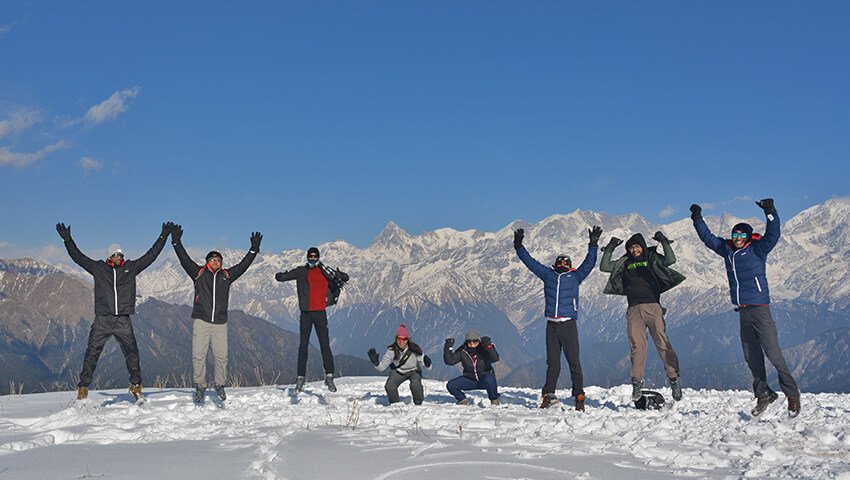
Dayara Bugyal Trek
Hike to a high altitude meadow considered among the highest & largest meadows of the Himalayas offering a panoramic view of gigant...
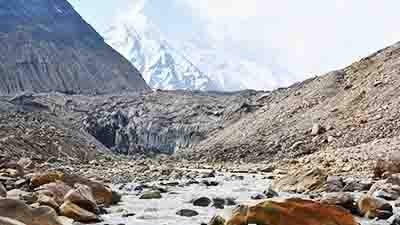
Gaumukh: The Source of...
Hike to Gaumukh is a challenging trek with scenic views.It is a glacier in the Himalayas which is the source of the Ganges River. ...
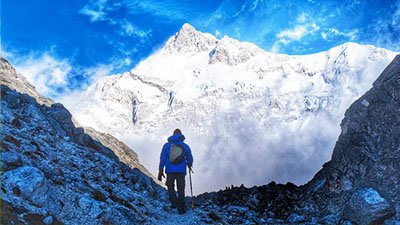
Goechala Trek
Nestled at a height of 15,100 ft, with a closer look at the third-highest peak-Mt. Kanchenjunga Goechala Trek is a dream and desire ...
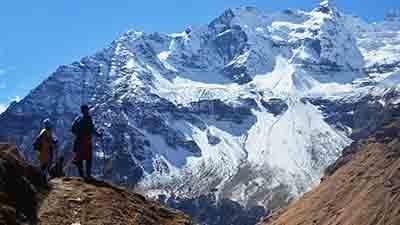
Pindari Glacier Trek
Pindari Glacier is one of the best treks in Kumaon region of Uttarakhand and a very easy one to begin with.
FULFIL DREAMS
At The Searching Souls, we intend to encourage people, to take out time from their busy lives and join us on a journey of self-exploration in the Himalayas.
Address Lane No 3, Friends Enclave, Near Siddhartha law college, IT Park, Sahastradhara Rd, Dehradun, Uttarakhand 248013
Daily Business Hours: 9 AM to 9 PM
Call: +91- 9634923602, 7895770439
IN A NUTSHELL
Certified by StartUpIndia, MSME and Uttarakhand Tourism, we are a 5 Star Rated Company with a 95% Customer Satisfaction Score. We deal in Trekking in the Himalayas, Customized group tours.

Sar Pass Trek, Kasol
Trip highlights.
Experience a beginner-friendly trail to Sar Pass that passes through forests, meadows, quaint villages, and snow-covered mountains.
Trek up to a view that stretches as far as the eye can see with snow-capped giants like Deo Tibba, Indraasthaan, and the Pir Panjal range.
Get a magical camping experience that might allow you to witness the Milky Way Galaxy in all its glory, a sight often enveloped by city lights.
Get a sense of accomplishment standing at the top, where the world seems to spread out before you at a 4,200-meter high pass.

Know Before You Go
- Climatic conditions in the high altitudes vary from the plains; take adequate time to get acclimatized to high altitudes.
- The management reserves all the right to modify the trek during any emergencies or natural calamities.
- The trek takes place through an eco-friendly zone; do not encourage littering the local sites or campsites. Travellers littering may be fined.
- Water is very precious, so conservation is appreciated.
- Avoid using plastic bags and maintain the ecological balance of the destinations.
- The exact location will be shared with you post-booking.
- Neat and clean vehicle for the journey with experienced driver especially for hilly terrains available.
- Carry dry snacks/food from home (you will save a lot of money). Carry water bottles with you, so that you can refill.
- Avoid using earphones during the trek; this might hinder your audibility.
- In case, the trek needs to be cancelled, the authorities should be informed beforehand.
- All the activities depend upon the weather.
- Mobile & laptop charging points may/may not be available on campsites at a common point.
- Keep your luggage minimum; the more you carry, the more you hassle.
- Pay heed to the trek leader and guide in order to enjoy a safe and sound trek.
- Professional Treak Leaders are available to ensure high safety and more information and personal attention which are necessary to appreciate a trek.
- Camping is very basic in nature. One must not expect luxuries. Electricity will not be available at any campsite.
- It is recommended to carry enough warm clothes and the right kind of shoes for the Sar Pass trekking.
- Any personal expenses, items of personal nature, meals not mentioned, etc. will not be in part of the Sar Pass trek package.
- Itineraries are based on information available at the time of planning and are subject to change. "Thrillophilia'' reserves the right to change expedition dates, people or itineraries as conditions warrant If a trip must be delayed or the itinerary changed due to bad weather, road conditions, transportation delays, government intervention, airline schedules, sickness, or other contingency for which Thrilllophilia or its agents cannot make provision, the cost of delays and/or other changes are the responsibility of the participant. Thrillophilia reserves the right to decline, or accept, any individual as a trip member for any reason whatsoever.
- Liability for change in itinerary due to reasons beyond our control like a change in flight and train schedule, cancellation of flights/1trains, political disturbances, natural phenomenon, roadblocks, etc. will not be accommodated in the package cost. No bill will be reimbursed for any missed service/facility.
- During a trip, in case the roads are blocked due to landslides or a reason that is beyond control, Thrillophilia will rearrange the itinerary for the travellers real-time, however, the cost of alternative accommodation will be borne by the customer as the hotels pre-booked execute their cancellation policies and are nonrefundable.
- Because of any reason natural or personal, if the Trek or a particular activity is not completed, no refund will be processed.
- The difference in the cost shall be borne by the client in case of any amendment in the package due to change in the number of guests, hotel change, itinerary change, etc.
- If in case any traveller wants to or decides to leave the trip in the middle, all the expenses from that point onwards will be borne by the traveller. Neither the operator nor Thrillophilia will be held responsible for such decisions or for any refund.
- The refund or compensation is also not issued if for any reason you have to come down from the trek. The trek leader may send you down from the trek, owing to reasons like lack of fitness, AMS, blood pressure, turn-around-time, health issues, or if you are found smoking/ drinking, or breaking the rules of the trek. refund or compensation are issued only when the whole trek is cancelled or called off on behalf of Thrillophilia.
- At Thrillophilia, we almost never call off or cancel our treks. But in the rare event we might have to call off or cancel a trek due to any unforeseen natural catastrophes like continuous rain or snow, thunderstorms, snowstorms, landslides, floods, earthquakes, or any other natural calamity or other issues like local riots, curfews, pandemics, lockdowns, government orders, or any such situations that might prevent a safe trekking experience. In such cases, Thrillophilia will issue a Credit note summing up to the same amount as your trek fee that can be redeemed on any of the treks over a period of the next year.
Additional Information
About Sar Pass Trek:
Perched at 13,800 ft. above sea level, Sar Pass offers the magnificence of a beautiful verdant landscape and is a heaven for photographers, artists, and nature lovers. Set against a curtain of majestic Himalayan peaks wrapped in snow, the Sar Pass trek passes through some of the most scenic views ranging from forests to the meadows to the ice blankets.
While trekking across the path from Tila Lotni to Biskeri Ridge, one has to pass by a small, usually frozen lake which means "Sar" in the local language of Himachal. Hence the name, Sar Pass! The trail passes through the thick forest and takes you to a winter wonderland that makes it fascinating.
Sar Pass Trek Quick Facts:
Start Point/End Point: Kasol Base Camp. (It is 2 km away from the Kasol Bus Stand)
Duration: 4N/5D
Maximum altitude: 13,800 ft.
Sar Pass Trek Distance: 48 Kms
Temperature: 22 ° C (Max. During Day Time) to -5 ° C ( Min. During Night Time)
Best Time for Sar Pass Trek: April to Mid July
Sar Pass Trek Package Inclusions:
➔ Accommodation – You will be staying in tents for 4 days of the trek (3 people/tent). Room/Tent is separate for the male and female participants.
➔ Meals – (Breakfast, lunch, snacks, and dinner). We provide simple, nutritious veg/Jain food on all days of the trek.
➔ Camping charges – All trekking permits and forest camping charges are included.
➔ Trekking equipment – High-quality tents and sleeping bags in all the camps. Sleeping bags can withstand temperatures as low as -10 ºC.
➔ Safety equipment – First aid kit, oxygen cylinders, oximeter, etc. will be with guide/trek leader and at the campsite as well to deal with emergencies.
➔ Expert trek Leaders – All our trek leaders are at least qualified in basic/advanced mountaineering and first aid course.
➔ Expert Trek support team – The mountain staff on Sar Pass trekking consists of certified guides, cooks, helpers, and porters.
Available Group Departure Dates:
March: 26,27
April: 1,2,3,8,9,10,15,16,17,22,23,24,29,30
May: 1,6,7,8,13,14,15,20,21,22,27,28,29
June: 3,4,5,10,11,12,17,18,19,24,
July: 3,5,10, 12,17,18,19,24,
Note: Customisation available on request
How To Reach Kasol:
By Air: The nearest airport is Bhuntar Airport which is well connected with all major airports via Delhi and Chandigarh. The distance between Kasol and Bhuntar Airport is 32 km, so from Bhuntar, you can board the government/private bus, or can hire a private tourist cab to reach Kasol.
By Train: The nearest Railway station is Chandigarh which is 310 km away. From here one can easily get a government/private bus to Kasol. Another option is to hire a private cab, but that will be a bit expensive option.
By Road: Reaching Kasol by road is the most convenient option. You can easily get a bus to Bhuntar from all major cities like Chandigarh, Delhi, etc. And from Bhuntar, you can board the government/private bus, or can hire a private tourist cab to reach Kasol.
Related Products
Kasol tour faqs, what is the best time to go for sar pass trekking.
The best time to go for the Sar Pass trek is during the spring, and summer seasons. Although the trek takes place in the monsoon season, it is recommended to carry proper equipment and supplements as there are chances of landslides and slippery tracks. During this time, the trail is lined by lush green forests and you can also find blankets of snow at the higher altitudes. The temperature remains pleasant, aiding you to climb an altitude of almost 13,500 ft. In winters, the entire route gets jammed with extreme snowfall, thereby restricting trekking possibilities.
How much does the Sar Pass Trek cost?
The cost of a trek to Sar Pass can range between INR 5,000 to INR 9,000 per person which depends on the number of days included and the distance covered. The whole price is also dependent on the inclusions of the package like the meals, the travel assistance, the extra charges of entry to the reserved areas, and other additional expenses.
How is the weather during the Sar Pass trek?
The weather is generally cool and soothing during the Sar Pass trek in Kasol. The temperatures can range from 20 to 22 degree Celsius during the day time, and 0 to -5 degree Celsius during the night time. The spring and summer season is ideal to go for this trek, as the conditions remain near-perfect. During the monsoon season, there is a possibility of heavy rain that can hinder the progress and make the trek slippery, especially at steeper ascents. This trek does not take place in the winter season.
What is the total distance of Sar Pass Trekking?
The Sar Pass trekking distance is 40 to 50 KM in 5 days from the starting point of Kasol and back to the base again. Situated at an elevation of 13,800 feet, the Sar pass trek is an ideal trek for beginners in the Kull region of Himachal Pradesh.
What is the difficulty level of Sar Pass trek?
The difficulty level of Sar Pass trek ranges between easy to moderate level of difficulty, and no prior trekking experience is required. Since the 'easy-moderate' tag is relative to other difficult treks in the Himalayas, Sar Pass commands a moderate level of fitness from all trekkers. The treks include a near-vertical incline at the top and an equally steep descent. The air above 12,000 ft. is very thin, and the oxygen levels are considerably lower, which increases the level of difficulty. It is mandatory to follow a regular fitness regime to ensure your body adapts well to the lower oxygen on the trek.
Is Sar Pass Trek dangerous?
The Sar Pass trek is a relatively moderate trek than other Himalayan treks. Beginners can easily commence upon this trek with guides who are accustomed with the trail. Since this is an adventure activity, one needs to be cautious and take proper precautions while undertaking any trek. Thrillophilia’s Sar Pass trek packages are inclusive of all essential needs like meals, sleeping, bags, medical kits, and professional guides, thereby ensuring the safety and security of beginners. However, it is suggested to prepare for the trek from at least a month before and be physically fit.
How can I get Sar Pass from Delhi?
Kasol is an overnight journey from Delhi which takes around 11 hours. The trek to Sar pass begins from the base camp of Kasol. One can take a flight from Delhi to Kullu followed by a bus journey to Kasol. There is also a train to Bhunter from Delhi where you can catch a local bus till Kasol.
Can we do Sar Pass trek anytime of the year?
The best time recommended for doing Sar Pass trek is between May-July if you wish to experience both pleasant summers and snow-covered peaks. Sar Pass trek is usually not conducted during the winter months of October- December to avoid the chances of rough weather with hailstones and blizzards.
Can we do Sar Pass trek in winters?
Sar pass trek is mostly not arranged by companies during the winter season as the weather can be unpredictable between October- December. The chances of hailstorms and blizzard increases during the winter season and the trail also tends to get covered with the heavy snow in the Sar Pass trek.
What should I carry for Sar Pass trekking?
You need to be well-prepared for the Sar Pass trek.
1. Equipment and gears-
- Trekking pole
- Snow-friendly gloves
- Trekking shoes
- Backpack with rain cover
- Sleeping bag and camp (optional)
2. Clothing-
- Jackets (preferably those that cover sub-zero temperatures)
- Trekking pants
- Quick-dry socks
- Neck-warmer
3. Other essentials-
- Dry tissue paper and non-alcoholic wet tissues too.
- Sunscreen (preferably SPF 50+)
- Heavy moisturizer
- Cleanser/face-wash
- Smaller backpack to carry immediate stuff.
- Water bottle
What level of fitness is expected from trekkers for the Sar Pass Trek?
The Sar Pass trek is an easy to moderate level trek which holds some steep ascent, requiring good stamina. Naturally, this implies that trekkers must have a decent amount of fitness. You should be able to jog for 5 km in about 35 to 40 minutes to increase cardiovascular endurance.
Make your muscles stronger by doing 3 sets of squats with 15 reps per day, and some yoga asanas. This will aid acclimatization, and facilitate adaptability to lower oxygen levels on high altitudes.
Which type of shoes should I buy for Sar Pass trekking?
We recommend carrying trekking shoes with high ankle support, and good quality material that is water-resistant. Since the terrain is uneven and rugged, it is imperative that your trekking shoes have a good grip, which will be less prone to slipping. When buying new shoes, we insist that break them in at least 2-3 weeks before the trek to avoid chafing and blisters. Please avoid carrying sports shoes, as they are not meant for trekking, and can cause fatal slips. Also, carry at least 3-4 pairs of cotton socks.
How do I get to Sar Pass?
You can get to Sar Pass base camp which is in Kasol easily via public as well as private transit systems available.
By Bus- You can take a bus from Delhi, Chandigarh, or nearby major cities to Bhuntar. Kasol is 32 kilometres from Bhuntar, and this distance can be covered by taking a cab, or a public bus offered by Himalayan Road Transport Corporation.
By Train- The nearest railway station to Kasol is Joginder Nagar Railway Station in Mandi, which is easily connected to the major cities of Pathankot and Chandigarh. Some of the major trains running on this route are Pathankot - Jwalamukhi Road Express Special and Pathankot-Baijnath Paprola Express Special. Alternatively, a more convenient route is to travel to Chandigarh via train, and then take a cab or bus from there till Kasol, covering around 260 kilometres in 7-8 hours.
By Air- There are several direct flights from Delhi to Bhuntar airport that take hardly an hour to reach. Alternatively, you can avail of connecting flights from all major cities of India like Chandigarh, Amritsar, Jaipur, Kolkata, Bangalore, and others. From Bhuntar, Kasol is 32 kilometres away, taking 1-2 hours to reach via a private car, a cab, or a public bus.
Is there snow in Sar Pass in May?
Yes, You can witness snow in the Sar Pass Trek in May at the higher altitude places like the Sar Pass (top), Nagaru, and Biskeri Thach. Thrillophilia’s Sar Pass trek itinerary includes all these spots, where we provide camp stays for an enriching experience. During the peak summers in May, you can expect lush and vibrant valleys in the lower altitudes, thereby experiencing a varied range of landscapes and geographical wonders along the route.
Can I go for sar pass trek in November?
No, November marks the start of the winter season and there are high chances of snowfall that can block the route. Since the trek covers a high elevation, the temperatures can drop below -15 degrees Celsius, making it impossible to trek the 48-kilometer trail. Even if it does not snow in November, it is not safe to undertake the trek due to unpredictable weather conditions during this time. Thrillophilia’s Sar Pass trek package is non-functional in November.
What is the height of Sar Pass?
The height of this dramatic mountainous Pass is around 4220 m and 13,850 ft above sea level. The height can be reached by trekking for around five days in which you get to enjoy various splendid sceneries as well as a chance to pass through some of the most thrilling as well as adrenaline-rushing terrains.
Where does the Sar Pass trek start from?
The Sar Pass Trek begins from Kasol, from where you are required to trek to Garhan Village for 5 to 6 hours. From here, a 4 to 5 hour long trek is followed to Mung Thach and then to more 6 hours to Nagaru. From Nagaru, a 6 or 8 hour long trek is done to Biskeri Thatch via Sar Pass.
How is the Sar Pass trek experience?
Huddled 13,700 ft. above sea level in the Kullu district of Himachal Pradesh, sits a snowy dream world that beckons herds of adventurers into its folds every year. Sar Pass is one of the most beautiful treks in India and promises a medley of thick forests, sylvan meadows, and roaring streams. Your first stop is Kasol, which is the base village for the trek. It is a beautiful hamlet reflecting Israeli culture, which makes it every backpackers' dream destination.
The initial part of the Sar Pass trek is housed within stunning woods that seem like something right out of a fantasy movie. The scenery shifts from grassy meadows to the Winterland of Narnia midway through the trek! Patches of green and brown are veiled under a layer of powdery snow. The last hour or two of the trek to the main Sar Pass is the most thrilling part, as the incline of the slope is nearly 90 degrees!
As daunting as it sounds, the surrounding Himalayan beauty overpowers your fear and fatigue. The highlight of the Sar Pass trek is the descent from Sar Pass, which can't be traversed by trekking, give the steep incline. You have to slide down the slope! It feels like a roller coaster ride, only better. Experience your heart racing, and soul rejoicing as the little child in you comes shrieking alive!
Which are the other best Himachal treks that we can book from Thrillophilia?
Here is the list of best treks in Himachal that you can book from Thrillophilia:
- Hampta Pass Trek
- Kareri Lake Trek
- Bhrigu Lake Trek
- Beas Kund Trek
- Prashar Lake Trek
- Buran Ghati Trek
- Shrikhand Mahadev Trek
More on Kasol Tourism
Expedia Rewards is now One Key™
Visit mytishchi, where to stay in mytishchi.
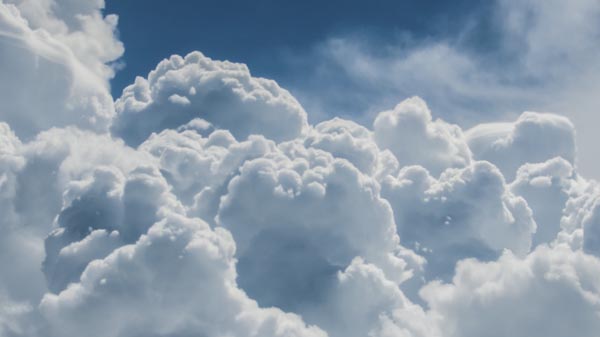
Travelers like the museums in Perlovka, and XL Family Outlet is a top attraction you might want to visit.
Check Mytishchi hotel availability
Popular places to visit.
You can learn about the history of Moscow with a trip to Red Square. Experience the area's fascinating museums and acclaimed theater scene.
- Moscow Kremlin
Visit the most iconic square in Russia, which is bordered by many of the city’s most famous landmarks.
- St. Basil's Cathedral
Think of Russia and you probably picture this iconic building, whose onion-shaped domes overlook the Moscow skyline.
- Bolshoi Theatre
A centerpiece of the Russian arts scene, this theater’s magnificent auditorium and top-tier productions will impress even the most jaded theatergoer.
- Lenin's Mausoleum
Mourners and curious visitors stream to the grave to see the embalmed Vladimir Lenin, the famous revolutionary and one-time leader of the Soviet Union.
- Exhibition of Achievements of National Economy
Learn about the events happening at Exhibition of Achievements of National Economy during your trip to Moscow. Wander the parks and gardens while you're in the area.
- Cities near Mytishchi
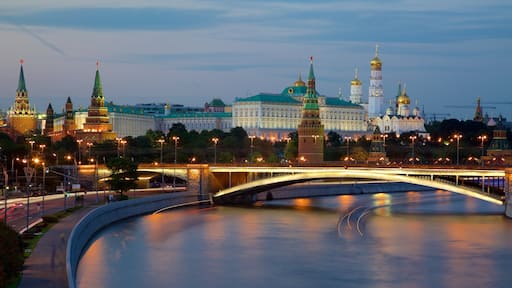
- Places of interest
- XL Family Outlet
- Kva-Kva Aquapark
- Mytishchi Arena
- Puppet Theatre Flint
- Fest Mytishchi Drama and Comedy Theater
- Ice Palace Arena Mytischi
- Crocus City Hall
- Moscow City
- Crocus Expo Center
- State Historical Museum
- Armoury Chamber
- Arbat Street
- Moscow State University
- Pushkin Museum of Fine Arts
- State Tretyakov Gallery
- Ministry of Foreign Affairs
- Cathedral of Christ the Savior
- Luzhniki Stadium
- Victory Park

IMAGES
VIDEO
COMMENTS
1. Membership is mandatory for all the YHAI Programs. All the participants have to validate their Membership at the base camp during registration. 2. Smoking, use of alcohol and narcotics of any description is strictly prohibited during the course of the program. 3. Stay other than YHAI Camp is not allowed for the entire duration of the camp. 4.
Sar Pass Trekking 2023. Program Type - National By Office. Program Category - Trekking. Duration - 7N/8D. Program Date - date. National Himalayan Trekking cum Training Expedition Sar Pass 2023. Your Journey Started 0 and Journey Ends 0. Inclusive of Food, Boarding, Group Medical Insurance and Trekking. 9000.00.
Importatnt Note - Participants are requested to bring the below documents at the time of reporting at base camp. 1) 2 Copies of ID proof 2) Trekking Medical certificate 3) 2 Passport size photographs About Program : After completing 50 years in Himalayan Trekking, Youth Hostels Association of India once again brings the National Himalayan Trekking cum Training Expedition- SAR Pass, 2024 ...
Last 2 km trek is on off-road till the power project (Pick-up point). Transportation Amount is not included in the trek cost. On the way to Kasol you can visit Gurudwara Sahib Manikaran and the hot spring, taxi waiting charges will be applicable. Drive to Kasol is next to the Parvati river. Reach Kasol by 4-5 pm.
An ideal trek for beginners. Trek through forests, meadows and quaint villages. Climb to the summit of Sar Pass at 13,799 feet for stunning views of snow-capped mountains. The trek starts from Kasol, which is a haven for backpackers from around the globe. This trail attracts large weekend crowds.
The Sar Pass Trek is a popular trekking route in the Parvati Valley of Himachal Kasol - India. -2024- Complete information, Itinerary, Route, Map, Best Season ... Trek Equipment You can book directly at the Base Camp of your trek. Available Dates. April -2024. 21 April to 23 April 2024 (Open) 22 April to 26 April 2024 (Open)
Trek Distance. The Sar Pass Trek covers a total distance of approximately 48 kilometres (30 miles).It is usually completed over 5-6 days, depending on the pace and acclimatization of the trekkers. Each day's distance varies, ranging from 6 to 12 kilometres (4 to 7.5 miles), offering a perfect balance of trekking challenges and exploration. ...
The Sar Pass trek cost with YHAI i.e Youth Hostel Association of India is INR 7,875/- per person. The cost includes Food, Boarding, Medical Insurance, and Trekking. ... Click Below for Private Group booking with Customized Itinerary. Have questions ? Get instant answers to your Trek related queries. Message us on Whatsapp +91-8879607899.
I prefer YHAI for Sar Pass trek due to various reasons and I had penned down the reasons why should one consider trekking with YHAI. Booking for the YHAI Sar Pass trek starts around October or November with 50 - 60 slots per day. To book for the trek you can watch out this space often.
My SAR PASS Trek with YHAI. 7th Jun 2018. By Radhika Sodhi. I really wanted to push myself from my comfort zone & go for a real trek not a 1 or 2 days short trek but a real one & I am going solo that's also my first solo trip, I choose YHAI sar pass trek & This trek changed me, I found so much about myself. John Muir says it correct that "The ...
SAR PASS TREK. ₹ 7500 ₹5999. Early Bird Offer 20% off. Kasol to Kasol all inclusive. Book Now at Just ₹ 2000. Easy rescheduling 15 days prior to trek date. Highest Rated Trekking Company in India. First Company to Introduce Jumbo Bag (Includes all Trekking Gear)
Sar Pass Trek, Kasol is a thrilling adventure that takes you through the scenic beauty of the Parvati Valley. Book now and get 36% off on this amazing trekking experience. Explore the snow-covered peaks, lush meadows, and dense forests of the Himalayas with Thrillophilia.
This video documents our journey from Kasol to Grahan to Min thatch to Nagaru to SAR PASS top with YHAI group. It is a medium level trek where some stretches...
the trek. 2. Porter Facility Sar Pass trek goes through Grahan village. Local ladies from the village provide porter services at 500-600 INR per day for each of the bags. Participants can take services from them if they wish and pay directly in cash to them. This facility is available only from Grahan and many times till
Hi..In the 2nd part of the Sar Pass Trek, we will see the undefined beauty of Sar Pass. We crossed Sar Pass by walking on snow for more than 10 kilometers. W...
Plan this summer for an adventurous and picturesque trek. Sar pass trekking cum training expedition 2023 Duration: 7N/8D Dates: 26th April to 31st May in just Rs 9000/-PP Click here to book: https:// bit.ly/3QRQ4Yq. . . . #yhai #yhaindia #trekking #trek #camping #adventure
Rome2Rio makes travelling from Moscow to Nairobi easy. Rome2Rio is a door-to-door travel information and booking engine, helping you get to and from any location in the world. Find all the transport options for your trip from Moscow to Nairobi right here. Rome2Rio displays up to date schedules, route maps, journey times and estimated fares from relevant transport operators, ensuring you can ...
Book at blablacar.co.uk. Taxi from Mytishchi to Moscow Ave. Duration 31 min Estimated price RUB 500 - RUB 650 Yandex Taxi Phone +7 495 999 99 99 Website taxi.yandex.com Taxi Moskva Phone +7 495 255-33-99 Website themoscowtaxi.ru Taksik Phone +7 495 921-38-31 Website taxik.ru Old Taxi ...
Armoury Chamber. 4.5 /5 (146 reviews) Visit one of Moscow's oldest and most revered museums and discover more about Russian royal life and military history.
Get to Yuri Gagarin Cosmonaut Training Center from anywhere in the world by train, bus, car and more. Find quality accommodation and discover the best things to do and see.